Citizen SR-281N: Indice
Indice: Citizen SR-281N

SR260B_SR-281N_Italian_v090330.doc SIZE:140x75mm SCALE 1:1
2009/3/31
-It 1-
Guida Generale.................................................................................. 2
Accensione E Spegnimento.............................................................. 2
Sostituzione della Batteria ................................................................ 2
Funzione di Autospegnimento .......................................................... 2
Reset................................................................................................ 2
Regolazione del Contrasto ............................................................... 3
Schermo ........................................................................................... 3
Prima di Iniziare i Calcoli .................................................................. 4
Uso del tasto " MODE " .................................................................... 4
Uso dei Tasti " 2nd " ......................................................................... 4
Correzioni ......................................................................................... 4
Funzione Undo ................................................................................. 4
Funzione Replay .............................................................................. 5
Calcoli di Memoria............................................................................ 5
Ordine delle operazioni..................................................................... 6
Accuratezza e Capacità.................................................................... 7
Condizioni di errore .......................................................................... 9
Calcoli di Base................................................................................... 9
Calcolo aritmetici .............................................................................. 9
Calcolo con parentesi..................................................................... 10
Calcolo della percentuale ............................................................... 10
Notazioni di Visualizzazione ........................................................... 11
Calcoli di Funzioni Scientifiche...................................................... 12
Logaritmo e Antilogaritmo............................................................... 12
Calcolo delle Frazioni ..................................................................... 13
Conversione unità degli angoli ....................................................... 14
Trasformazione Sessagesimale
↔
Decimale................................. 15
Funzioni Trigonometriche / Tri. Inverse........................................... 15
Funzioni Iperboliche/ Ip. Inverse..................................................... 16
Trasformazione delle Coordinate.................................................... 16
Probabilità ...................................................................................... 17
Altre funzioni ( 1/x,
,
3
,
X
, x
2
, x
3
, x
y
, INT, FRAC ).............. 18
Conversione degli Unità ................................................................. 18
Costanti Fisiche.............................................................................. 19
Calcoli di Base–n............................................................................. 25
Conversioni di Base ....................................................................... 26
Funzione di Blocco ......................................................................... 26
Operazioni aritmetiche elementari per basi .................................... 27
Espressioni Negative...................................................................... 27
Operazione Logica ......................................................................... 27
Calcoli Statistici............................................................................... 28
Immissione di Dati .......................................................................... 28
Visualizzazione dei Risultati ........................................................... 29
Cancellando dati............................................................................. 32
Modifica di dati ............................................................................... 33
Messaggio FULL ............................................................................ 33
Calcoli Complessi ........................................................................... 34
Indice

SR260B_SR-281N_Italian_v090330.doc SIZE:140x75mm SCALE 1:1
2009/3/31
-It 2-
Guida
Generale
Accensione E Spegnimento
Per accendere la calcolatrice, premere [ ON/C ] ; per spegnere la
calcolatrice, premere [ 2nd ] [ OFF ].
Sostituzione della Batteria
La calcolatrice è alimentata da due batterie alcaline G13(LR44).
Quando lo schermo si diventa opaco, sostituire le batterie. Fare
attenzione ad evitare di provocarsi lesioni durante la sostituzione delle
batterie.
1. Svitare le viti nella parte posteriore della calcolatrice.
2. Inserire un cacciavite piatto nello slot tra la parte superiore ed
inferiore poi fare leva con il cacciavite per separare le due parti.
3. Rimuovere le due batterie smaltirle in modo appropriato. Non
lasciare che i bambini giochino con le batterie.
4. Pulire le batterie nuove con un panno sciutto per avere un contatto
buono.
5. Inserire le due nuove batterie con lati piatti (terminali positivi) verso
l’alto.
6. Allineare la parte superiore ed inferiore e chiuderle fino a che non
scattano.
7. Stringere le viti.
Funzione di Autospegnimento
Questa calcolatrice si spegne automaticamente se non utilizzata per
circa 6~9 minuti. Si può riattivare con il tasto [ON/C], mantenendo
visualizzazione, memoria e impostazioni
Reset
Se la calcolatrice è accesa ma si ottengono risultati errati, premere
[ MODE ] [ 4 ] ( RESET )
in sequenza. Compare un messaggio sullo
schermo per confermare il reset di tutta la memoria della calcolatrice e
la cancellazione del contenuto della memoria.
RESET : N Y
Spostare il cursore su “Y” con [
], quindi premere [ = ] per cancellare
tutte le variabili, i programmi, operazioni in sospeso, dati statistici,
risposte, tutti i dati immessi precedenti e la memoria; Per
abbandonare il reset senza eliminare i dati della calcolatrice, scegliere
“ N “ .
Se il calcolatore è bloccato ed ulteriori operazioni di tasto diventano
impossibili, si prega di usare un oggetto appuntito per premere il foro
di reimpostazione e per rilasciare contemporaneamente la condizione.
Tutte le impostazioni ritorneranno sulla posizione predefinita.

SR260B_SR-281N_Italian_v090330.doc SIZE:140x75mm SCALE 1:1
2009/3/31
-It 3-
Regolazione del Contrasto
Premendo [
−
] o [ + ] più il tasto [ MODE ] si può schiarire o scurire il
contrasto dello schermo. Tenere premuto uno dei tasti per far
diventare lo schermo, rispettivamente, più chiaro o più scuro.
Schermo
Lo schermo comprende due linee di immissione e gli indicatori. La
linea superiore è una visualizzazione punteggiata con fino a 128
caratteri. La linea inferiore permette visualizzare un risultato fino a 12
cifre con esponente di 2 cifre positivi o negativi.
Quando si immette formule e si esegue calcolo con tasto [ = ], loro
sono visualizzati sulla linea superiore, e poi I risultati sono mostrati
sulla linea inferiore.
I seguenti indicatori appaiono sullo schermo ad indicare lo stato
attuale della calcolatrice.
Indicatore Significato
M Memoria
indipendente
– Risultato
è
negativo
E Errore
STO
Modalità di memorizzazione di variabile attiva
RCL
Modalità di richiamata di variabile attiva
2nd
Secondo insieme di tasti funzione attivo
HYP
Viene calcolata la funzione iperbolica/trig.
ENG
Notazione di simboli tecnici
CPLX
Modalità numero complesso attiva
CONST Visualizza
costanti
fisiche
DEGRAD
Modalità Angolo : DEGrees (gradi), GRADs (gradians),
o RADs (radianti)
BIN Base
Binaria
OCT Base
Ottale
HEX Base
Esadecimale
( )
Parentesi Aperti
TAB
Numero di posti decimali visualizzati è fisso
STAT
Modalità Statistiche attiva
REG Modalità
Regressione
attiva
EDIT Dati
statistici saranno modificati
CPK
CPK : Capacità di Processo
CP : Capacità di Precisione
USL
Fissare limite di specificazione superiore
LSL
Fissare limite di specficazione inferiore
i Parte
Imaginaria
Permette usare funzione undo

SR260B_SR-281N_Italian_v090330.doc SIZE:140x75mm SCALE 1:1
2009/3/31
-It 4-
Prima di Iniziare i Calcoli
Uso del tasto " MODE "
Premendo [ MODE ] si può entrare nei menu di modalità e scegliere
una modalità di operazione (" 1 MAIN ", " 2 STAT ", " 3 CPLX ", " 4
RESET " ), o la notazione dei simboli tecnici ( " 5 ENG" ).
MAIN : Usare questa modalità per I calcoli aritmetici semplici
incluso calcoli di funzione scientifica e calcoli di Base-n.
2 STAT : Usare questa modalità per eseguire calcoli statistici a
variabile singola e a variabile doppia e calcoli di
regressione.
3 CPLX : Usare questa modalità per eseguire calcolo di numero
complesso.
4 RESET : Usare questa modalità per eseguire operazione reset.
5 ENG : Usare questa modalità per permettere calcoli tecnici
utilizzando simboli tecnici.
Prendiamo " 2 STAT " come esempio :
Metodo 1 : Premere [ MODE ] e scorrere tra I menu con [
] o [ 2nd ]
[
] fin quando " 2 STAT " è sottolineato, quindi digitare
la modalità desiderata premendo [ = ].
Metodo 2 : Premere [ MODE ] e battere direttamente il numero della
modalità, [ 2 ] per entrare subito nella modalità voluta.
Uso dei Tasti " 2nd "
Quando si preme [2nd], compare l’indicatore “2nd“ nello schermo ad
indicare che sarà selezionata la seconda funzione del prossimo tasto
premuto. Se si preme [2nd] per sbaglio, premere ancora [2nd] per
rimuovere l’indicatore “2nd".
Correzioni
Se si digita un numero per sbaglio (senza premere nessun tasto di
operazione aritmetica), basta premere [ CE ] per eliminare l’ultimo
numero, poi digitare nuovamente il valore o cancellare cifre indivisuali
con il tasto backspace [
], o elimina tutti i numeri con [ ON/C ].
Dopo delle correzioni, immissione della formula è completa, la
risposta può essere ottenuta premendo [ = ]. Si può anche premere
[ ON/C ] per eliminare I risultati immediati completamente (eccetto
eliminando memoria). Se premere il tasto di operazione aritmetica
sbagliato, basta premere il tasto corretto per sostituirlo.
Funzione Undo
L’unità offre una funzione undo che permette disfare alcuni dei errori
appena fatti.
Per recuperare un carattere appena cancellato con [
],
un’immissione appena eliminate con [ CE ] od appena annullata con
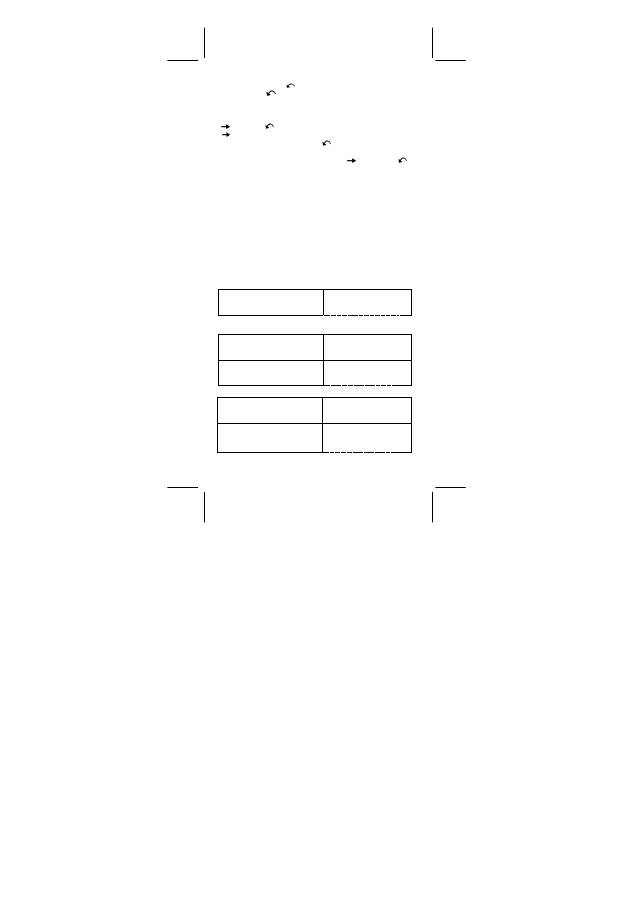
SR260B_SR-281N_Italian_v090330.doc SIZE:140x75mm SCALE 1:1
2009/3/31
-It 5-
[ ON/C ], il indicatore [
] mostrato sullo schermo indica che si può
premere [ 2nd ] [
] per annullare l’operazione.
Funzione Replay
Dopo la fine dell’esecuzione,o durante l ‘immissione, premere i tasti
[
] o [ 2nd ] [
] per mostrare la operazione eseguita. Premendo
[
] mostrerà l’operazione dall’inizio con il cursore posto sotto il
primo carattere. Premendo [ 2nd ] [
] visualizzerà l’operazione dal
fine con il cursore posto sotto il spazio dopo dell’ultimo carattere. Si
può continuare spostando il cursore con [ ] o [ 2nd ] [
] e
modificando valori o comandi per esecuzione susseguente.
Calcoli di Memoria
Variabili di Memoria
La calcolatrice ha nove viariabili di memoria per uso ripetuto -- A, B, C,
D, E, F, M, X, Y. Si può memorizzare un numero reale in una delle
nove variabili di memoria.
•
[ STO ] + [ A ] ~ [ F ], [ M ], [ X ] ~ [ Y ] permette di memorizzare I
valori a variabili. .
•
[ RCL ] + [ A ] ~ [ F ], [ M ], [ X ] ~ [ Y ] richiama il valore della
variabile.
•
[ 0 ] [ STO ] + [ A ] ~ [ F ], [ M ], [ X ] ~ [ Y ] elimina il contenuto di
una variabile di memoria specificata.
¾
(1) Memorizzare il valore 30 nella variabile A
DEG
3 0
Æ
A
30 [ STO ] [ A ]
3 0
.
¾
(2) Moltiplicare 5 per la variabile A, poi salvare il risultato nella
variabile B
DEG
5
¼
A =
5 [ x ] [ RCL ] [ A ] [ = ]
1 5 0
.
DEG
1 5 0
Æ
B
[ STO ] [ B ]
1 5 0 .
¾
(3) Eliminare il valore della variabile B
DEG
0
Æ
B
0 [ STO ] [ B ]
0
.
DEG
B =
[ RCL ] [ B ] [ = ]
0
.
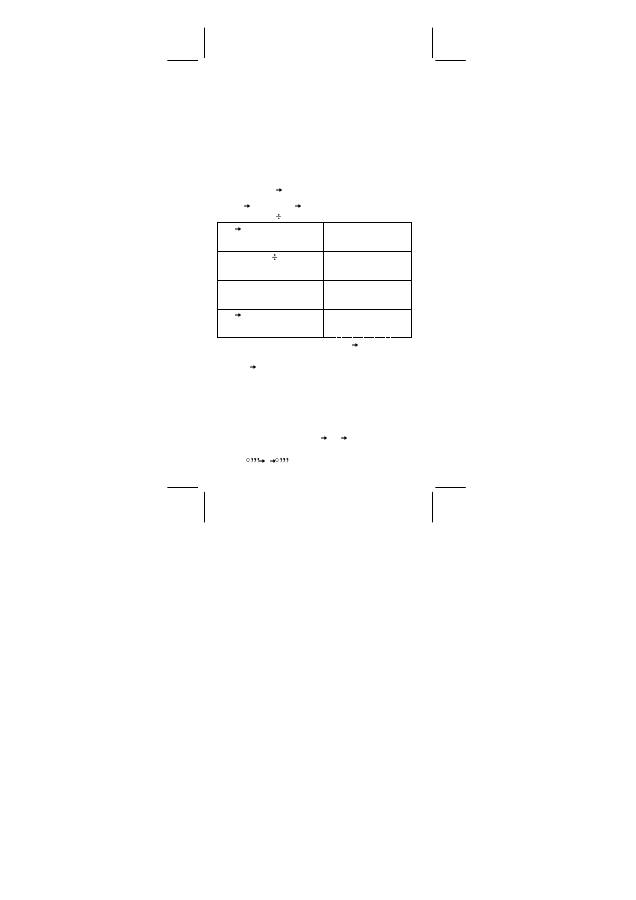
SR260B_SR-281N_Italian_v090330.doc SIZE:140x75mm SCALE 1:1
2009/3/31
-It 6-
Memoria Corrente
Non dimenticare le seguenti regole quando usare la memoria corrente.
• Premere [ M+ ] per aggiungere un risultato alla memoria corrente ed
il indicatore " M " apparirà quando memorizzare un numero nella
memoria. Per richiamare il valore nella memoria cprrente , premere
[ MR ].
• La richiamata dei valori dalla memoria corrente premendo tasto
[ MR ] non incide sui contenuti.
• Memoria corrente non è disponibile nella modalità statistiche.
• La variabile de memoria M e memoria corrente usano la stessa
area di memoria.
• Per sostituire il contenuto della memoria con il numero visualizzatto ,
premere il tasto [X M ].
• Per eliminare il contenuto della memoria corrente si può premere
[ 0 ] [ X M ], [ ON/C ] [ X M ] o [ 0 ] [ STO ] [ M ] in ordine.
¾
[ ( 3 x 5 ) + ( 56 7 ) + ( 74 – 8 x 7 ) ] = 41
DEG
0 [ X M ]
0
.
DEG
7 4 – 8
¼
7 M +
3 [ x ] 5 [ M+ ] 56 [ ] 7 [ M+ ] 74
[ – ] 8 [ x ] 7 [ M+ ]
M
1 8
.
DEG
M
[ MR ]
M
4 1
.
DEG
0 [ X M ]
0
.
(Nota) : Inoltre a premere il tasto [ STO ] o [ X M ] per memorizzare
un valore, si può anche assegnare valori a variabile di
memoria M con [ M+ ]. Tuttavia, quando si usa [ STO ] [ M ] o
[ X M ], i contenuti di memoria precedenti memorizzati nella
variabile M sono eliminati e sostituiti con un valore
recentemente assegnato. Quando si usa [ M+ ], valori sono
aggiunti alla somma presente nella memoria.
Ordine delle operazioni
Ogni calcolo è effettuato nel seguente ordine di precedenza:
1) Frazioni
2) Espressione all’interno di parentesi.
3) Trasformazione di coordinate ( P R , R P )
4) Funzioni di tipo A, che richiedono di inserire valori prima di
premere un tasto funzione, per esempio, x
2
,1/x,
π
, x!, %, RND,
ENG,
,
, x ', y '.

SR260B_SR-281N_Italian_v090330.doc SIZE:140x75mm SCALE 1:1
2009/3/31
-It 7-
5) x
y
,
X
6) Funzioni di tipo B che richiedono la pressione di un tasto funzione
prima dell’immissione, per esempio, sin, cos, tan, sin
–1
, cos
–1
,
tan
–1
, sinh, cosh, tanh, sinh
–1
, cosh
–1
, tanh
–1
, log, ln, FRAC, INT,
√
,
3
, 10
X
, e
X
, NOT, EXP, DATA nella modalità STAT.
7) +/–, NEG
8) nPr, nCr
9) x ,
10) +, –
11) AND, NAND –-- soltanto in modalità Base–n
12) OR, XOR, XNOR --- soltanto in modalità Base–n
Accuratezza e Capacità
Cifre visualizzate : fino a 12 cifre.
Cifre calcolate : fino a 14 cifre
In generale, ogni calcolo ragionevole è visualizzato fino ad un
massimo di mantissa 12 cifre, o mantissa 12-cifre più esponente a 2-
cifre fino a 10
± 99
.
I numeri usati per l’immissione devono essere all’interno della gamma
di funzione data, come indicato di seguito :
Funzioni
Gamma di immissione
sin x
cos x
tan x
Deg :
x
<
4.5 x 10
10
deg
Rad :
x
<
2.5 x 10
8
π
rad
Grad :
x
<
5 x 10
10
grad
Tuttavia, per tan x
Deg :
x
≠
90 (2n+1)
Rad :
x
≠
2
π
(2n+1)
Grad :
x
≠
100 (2n+1), (n è un intero)
sin
–1
x, cos
–1
x
x
≦
1
tan
–1
x
x
<
1 x 10
100
sinh x, cosh x
x
≦
230.2585092
tanh x
x
<
1 x 10
100
sinh
–1
x
x
<
5 x 10
99
cosh
–1
x
1
≦
x
<
5 x 10
99
tanh
–1
x
x
<
1
log x, ln x
1 x 10
–99
≦
x
<
1 x 10
100
10
x
–1 x 10
100
<
x
<
100
e
x
–1 x 10
100
<
x
≦
230.2585092
x
0
≦
x
<
1 x 10
100

SR260B_SR-281N_Italian_v090330.doc SIZE:140x75mm SCALE 1:1
2009/3/31
-It 8-
x
2
x
<
1 x 10
50
x
3
x
<
2.15443469003 x 10
33
1/x
x
<
1 x 10
100
, x
≠
0
3
x
x
<
1 x 10
100
x !
0
≦
x
≦
69, x è un intero.
R P
2
2
y
+
x
<
1 x 10
100
P R
0
≦
r
<
1 x 10
100
Deg
:
θ
<
4.5 x 10
10
deg
Rad
:
θ
<
2.5 x 10
8
π
rad
Grad
:
θ
<
5 x 10
10
grad
Tuttavia, per tan x
Deg
:
θ
≠
90 (2n+1)
Rad
:
θ
≠
2
π
(2n+1)
Grad
:
θ
≠
100 (2n+1), (n è un intero)
D
, M, S
<
1 x 10
100
, 0
≦
M, S
x
<
1 x 10
100
x
y
x
>
0 : –1 x 10
100
<
y log x
<
100
x = 0 : y
>
0
x
<
0 : y = n, 1/(2n+1), n è un intero.
ma –1 x 10
100
<
y log
x
<
100
x
y
y
>
0 : x
≠
0, –1 x 10
100
<
x
1
log y
<
100
y = 0 : x
>
0
y
<
0 : x=2n+1, l/n, n è un intero.(n
≠
0)
ma –1 x 10
100
<
x
1
log
y
<
100
a b/c
Immissione
:
Totale di intero, numeratore e
denominatore devono essere all’interno di 12
cifre (include segno di divisione)
Risultato
:
Risultato si visualizza come
frazione per intero quando intero,
numeratore e denominatore sono minori di 1
x 10
12
nPr, nCr
0
≦
r
≦
n, n
≦
10
100
, n,r sono interi.
STAT
x
<
1 x 10
50
,
y
<
1 x 10
50
σ
x,
σ
y,
x
, y , a, b, r : n
≠
0 ;
Sx, Sy
:
n
≠
0, 1 ; x
n
= 50 ; y
n
= 50 ;
Numero di ripetuti
≤
255, n è un intero.

SR260B_SR-281N_Italian_v090330.doc SIZE:140x75mm SCALE 1:1
2009/3/31
-It 9-
DEC
– 2147483648
≦
x
≦
2147483647
BIN
0
≦
x
≦
01111111111111111111111111111111
(per zero, positivo)
10000000000000000000000000000000
≦
x
≦
11111111111111111111111111111111
(per negativo)
OCT
0
≦
x
≦
17777777777 (per zero o positivo)
20000000000
≦
x
≦
37777777777
(per negativo)
HEX
0
≦
x
≦
7FFFFFFF ( per zero o positivo)
80000000
≦
x
≦
FFFFFFFF (per negativo)
Condizioni di errore
Compare un messaggio “ E ” sullo schermo e diventa impossibile
proseguire nei calcoli in una qualunque delle seguenti circostanze.
1) Tentativo di dividere per 0
2) Quando il intervallo di immissione fuoriesce dall’intervallo
specificato
3) Quando il risultato dei calcoli della funzione fuorisce dall’intervallo
specificato.
4) Quando si usa il tasto [ ( ] più di 13 livelli in una singola
espressione.
5) Quando il valore USL
<
valore LSL
Per uscire dai suddetti errori, premere il tasto [ ON/C ].
Calcoli di Base
Usare modalità MAIN ( [ MODE ] 1 ( MAIN ) ) per calcoli di base.
Calcolo aritmetici
Operazioni aritmetiche sono eseguite premendo i tasti nella stessa
sequenza come nella espressione.
¾
7 + 5 x 4 = 27
DEG
7 + 5
¼
4 =
7 [ + ] 5 [ x ] 4 [ = ]
2 7
.
Per valori negativi, premere [ +/– ] dopo di immettere il valore; Si può
immettere un numero in forma di mantissa e esponente con il tasto
[ EXP ].
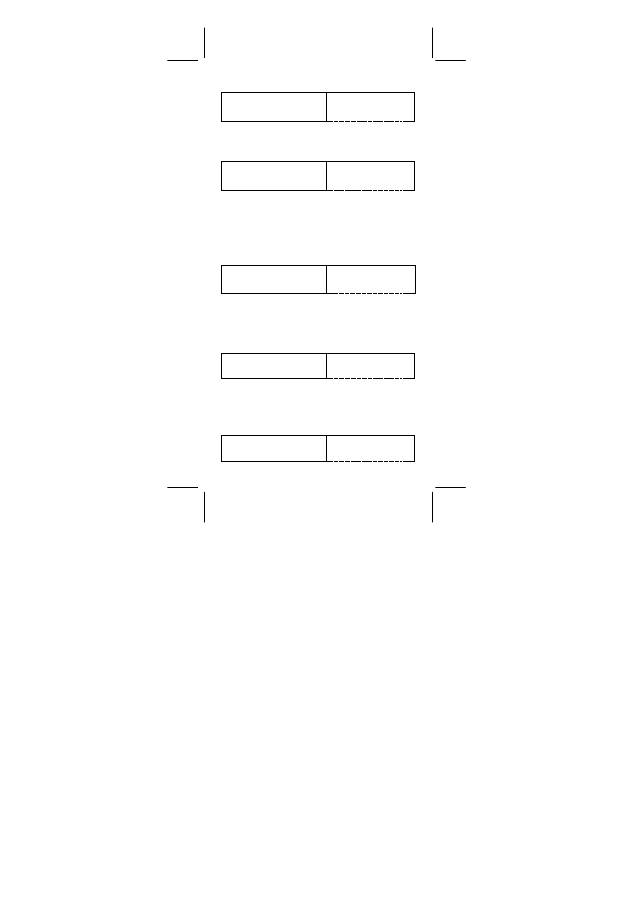
SR260B_SR-281N_Italian_v090330.doc SIZE:140x75mm SCALE 1:1
2009/3/31
-It 10-
¾
2.75 x 10
– 5
= 0.0000275
DEG
2
.
7 5 E – 0 5 =
2.75 [ EXP ] 5 [ +/– ] [ = ]
0
.
0 0 0 0 2
7 5
Risultati maggiori di 10
12
o minori di 10
–11
sono visualizzati nella
forma esponenziale.
¾
12369 x 7532 x 74010 = 6895016425080
= 6.89501642508 x 10
12
DEG
1 2 3 6 9
¼
7 5 3 2
¼
7
12369 [ x ] 7532 [ x ] 74010
[=]
6
.
8 9 5 0 1 6 4 2 5 0 8
12
Calcolo con parentesi
Le operazioni in parentesi sono sempre svolte prima.
SR-281N
può
usare fino a 13 livelli di parentesi consecutive in un singolo calcolo.
Le parentesi chiuse poste immediatamente prima di un’operazione
con il tasto [ ) ] si possono omettere, indipendentemente da quante ne
servano.
¾
2 x { 7 + 6 x ( 5 + 4 ) } = 122
DEG
2
¼
( 7 + 6
¼
( 5 + 4 =
2 [ ( ] 7 [ + ] 6 [ ( ] 5 [ + ] 4 [ = ]
1 2 2
.
(Nota) : Un segno di moltiplicazione "
x
" posto immediatamente
prima di una parentese aperta si può omettere.
Il risultato corretto non si può ottenere immettendo [ ( ] 2 [ + ] 3 [ ) ]
[ EXP ] 2. Bisogna digitare [ x ] prima di [ ) ] e [ EXP ] nell’esempio
sottostante.
¾
( 2 + 3 ) x 10
2
= 500
DEG
( 2 + 3 )
¼
1 E 0 2 =
[ ( ] 2 [ + ] 3 [ ) ] [ x ] [ EXP ] 2
[ = ]
5
0 0
.
Calcolo della percentuale
[ 2nd ] [ % ] divide per 100 il numero sullo schermo. Si può usare
questa sequenza di tasti per calcolare percentuali, aggiunte, sconti e
rapporti di percentuale.
¾
120 x 30 % = 36
DEG
1 2 0
¼
3 0 % =
120 [ x ] 30 [ 2nd ] [ % ] [ = ]
3 6
.

SR260B_SR-281N_Italian_v090330.doc SIZE:140x75mm SCALE 1:1
2009/3/31
-It 11-
¾
88 55 % = 160
DEG
8 8
5 5 % =
88 [ ] 55 [ 2nd ] [ % ] [ = ]
1 6 0
.
Notazioni di Visualizzazione
La calcolatrice fornisce le seguenti notazioni di visualizzazione per il
valore visualizzato.
Notazioni con Ponto Fisso/ Vírgola mobile
Per impostare le posizioni decimali premere [ 2nd ] [ TAB ] e poi il
valore indicando il numero di posizioni ( 0~9 ). Valori sono visualizzati
con arrotondamento al numero di posizioni specificate. Per ritornare a
impostazione di vírgola mobile, premere [ 2nd ] [ TAB ] [ • ].
Notazione Scientifica
Per cambiare la modalità di visualizzazione tra notazione vírgola
flutuante e scientifica, premere [ F
↔
E ].
Notazione Tecnica
Premendo [ ENG ] ou [ 2nd ] [
] cambierà visualizzazione
dell’esponente ed il numero visualizzato cambierà in multipli di 3.
¾
6 7 = 0.85714285714…
DEG
6
7 =
6 [ ] 7 [ = ]
0
.
8 5 7 1 4 2 8 5 7 1 4
DEG TAB
6
7 =
[ 2nd ] [ TAB ] 4
0 . 8 5 7 1
DEG TAB
6
7 =
[ 2nd ] [ TAB ] 2
0
.
8 6
DEG
6
7 =
[ 2nd ] [ TAB ] [ • ]
0
.
8 5 7 1 4 2 8 5 7 1 4
DEG
6
7 =
[ F
↔
E ]
8
.
5 7 1 4 2 8 5 7 1 4 3
–01
DEG
[ ENG ]
8 5 7
.
1 4 2 8 5 7 1 4 3
–03
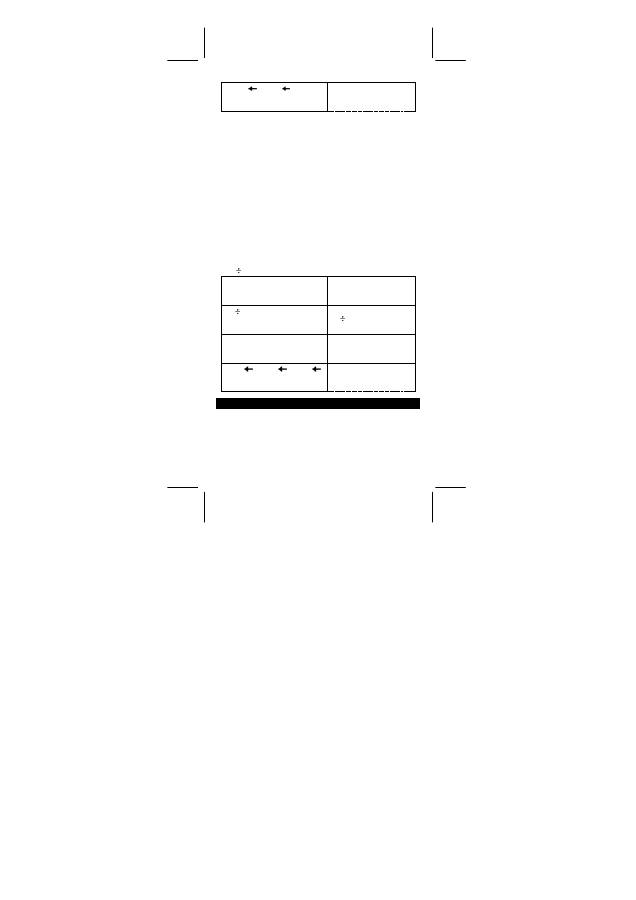
SR260B_SR-281N_Italian_v090330.doc SIZE:140x75mm SCALE 1:1
2009/3/31
-It 12-
DEG
[ 2nd ] [
] [ 2nd ] [
]
0
.
0 0 0 8 5 7 1 4 2 8 5
03
Notazione di Simboli Tecnici
Ogni volta che si specifica la modalità ENG, un risultato visualizzato è
automaticamente mostrato sullo schermo con il simbolo tecnico
corrispondente.
Y
yotta
= 10
24
,
Z
zetta
= 10
21
,
E
exa
= 10
18
,
P
peta
= 10
15
,
T
tera
= 10
12
,
G
giga
= 10
9
,
M
mega
= 10
6
,
K
kilo
= 10
3
,
m
milli
= 10
– 3
,
μ
micro
= 10
– 6
,
n
nano
= 10
– 9
,
p
pico
= 10
– 12
,
f
femto
= 10
– 15
,
a
atto
= 10
– 18
,
z
zepto
= 10
– 21
,
y
yocto
= 10
– 24
Eseguire la seguente operazione per specificare notazione di simbolo
tecnico.
[ MODE ] 5 ( ENG )
Per uscire da questa modalità, premere [ MODE ] 5 nuovamente.
¾
6 7 = 0.85714285714…
ENG
DEG
[ MODE ] 5
0
.
ENG
DEG
6
7 =
m
6 [ ] 7 [ = ]
8
5
7
.
1 4 2 8 5 7 1
4 3
ENG
DEG
μ
[ ENG ]
8 5 7 1 4 2
.
8 5 7 1 4 3
ENG
DEG
K
[ 2nd ] [
] [ 2nd ] [
] [ 2nd ] [
]
0
.
0 0 0 8 5 7 1 4 2 8 5
Calcoli di Funzioni Scientifiche
Usare la modalità MAIN ( [ MODE ] 1 ( MAIN ) ) per calcoli di
funzioni scientifiche.
Logaritmo e Antilogaritmo
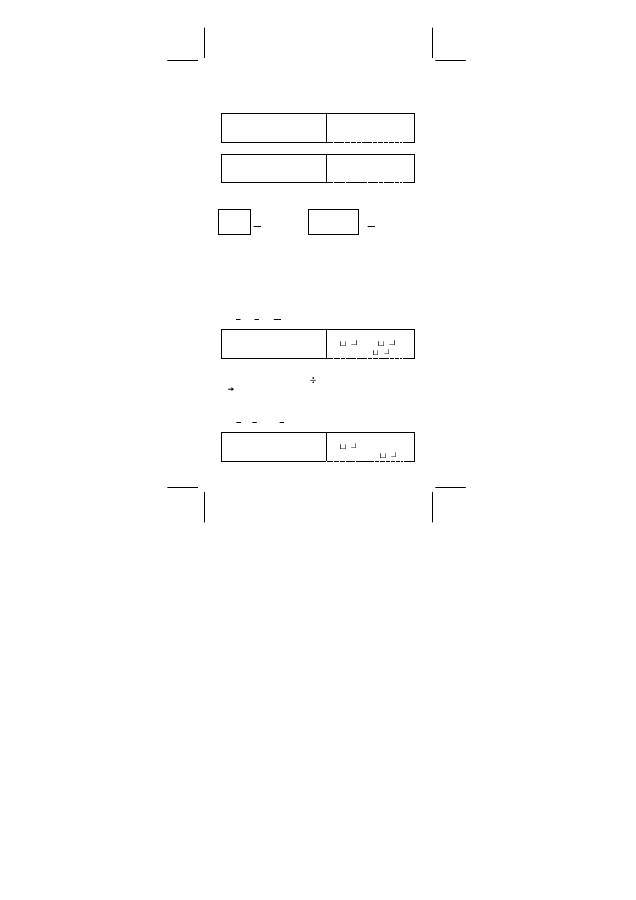
SR260B_SR-281N_Italian_v090330.doc SIZE:140x75mm SCALE 1:1
2009/3/31
-It 13-
La calcolatrice può calcolare logaritmi e antilogaritmi comuni e naturali
usando [ log ], [ ln ], [ 2nd ] [ 10
x
], e [ 2nd ] [ e
x
].
¾
ln 7 + log 100 = 3.94591014906
DEG
l n 7 + l o g 1 0 0 =
[ ln ] 7 [ + ] [ log ] 100 [ = ]
3
.
9 4 5 9 1 0 1 4 9 0 6
¾
10
2
+ e
–5
= 100.006737947
DEG
10
^ 2 + e ^ – 5 =
[ 2nd ] [ 10
X
] 2 [ + ] [ 2nd ] [ e
X
] 5
[ + / – ] [ = ]
1 0 0
.
0 0 6 7 3 7 9 4 7
Calcolo delle Frazioni
La visualizzazione del valore delle frazioni è la seguente:
5
」
12
Visualizzazione di
12
5
56
∪
5
」
12
Visualizzazione di
56
12
5
(Nota) : Valori sono visualizzati automaticamente in formato decimale
sempre che il numero totale di cifre dei valori frazionari
( intero + numeratore + denominatore + segni separatori)
eccede 12.
Per digitare un numero misto, battere la parte del numero intero,
premere [ a b/c ], digitare il numeratore, premere [ a b/c ], e digitare il
denominatore ; per digitare una frazione impropria, battere il
numeratore, premere [ a b/c ], e battere il denominatore.
¾
21
8
22
7
5
14
3
2
7
=
+
DEG
7
2
3
+ 1 4
5
7
7 [ a b/c ] 2 [ a b/c ] 3 [ + ] 14 [ a b/c ]
5 [ a b/c ] 7 [ = ]
2 2
8
2 1
.
z
Durante il calcolo di una frazione, se il numero è riducibile, un
numero, viene ridotto ai minimi termini dopo di premere il tasto di
funzione ( [ + ], [ – ], [ x ] or [ ] ) o il tasto [ = ]. Premendo [ 2nd ]
[ d/e ], il valore visualizzato sarà convertito in frazione impropria e
viceversa. Per convertire un risultato decimale in frazionario e
viceversa, premere [ a b/c ].
¾
2
9
5
.
4
2
1
4
4
2
4
=
=
=
DEG
4
2
4
=
4 [ a b/c ] 2 [ a b/c ] 4 [ = ]
4
1
2
.
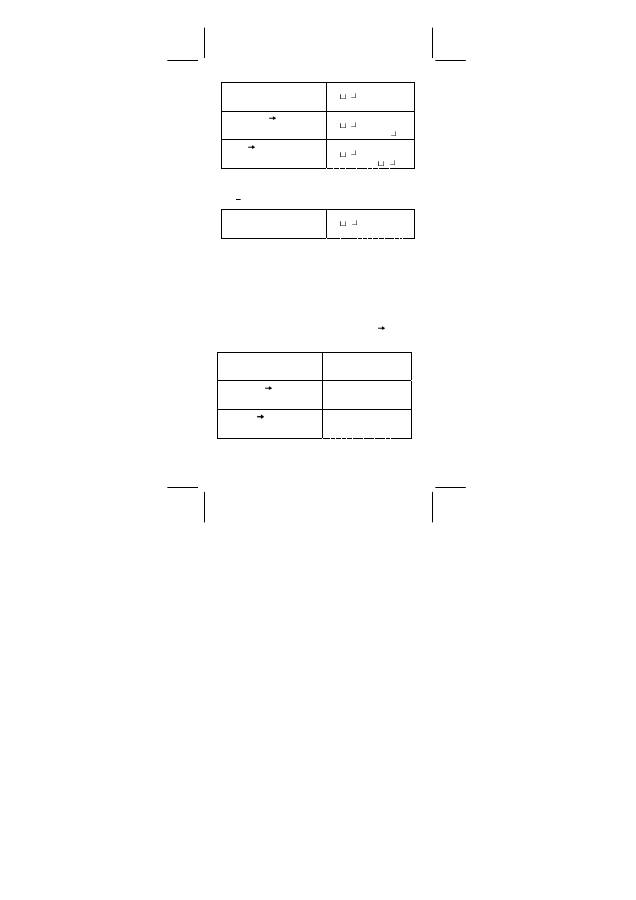
SR260B_SR-281N_Italian_v090330.doc SIZE:140x75mm SCALE 1:1
2009/3/31
-It 14-
DEG
4
2
4
=
[ a b/c ]
4
.
5
DEG
4
2
4
=
[ a b/c ] [ 2nd ] [ d/e ]
9
2
.
DEG
4
2
4
=
[ 2nd ] [ d/e ]
4
1
2
.
I calcoli che contengono sia frazioni che decimali sono calcolati nel
formato decimale.
¾
55
.
12
75
.
3
5
4
8
=
+
DEG
8
4
5
+ 3
.
7 5 =
8 [ a b/c ] 4 [ a b/c ] 5 [ + ] 3.75
[ = ]
1 2
.
5 5
Conversione unità degli angoli
La calcolatrice le permette convertire la unità degli angoli, fra gradi
(DEG), radianti(RAD), e gradians(GRAD).
Il rapporto fra le tre unità degli angoli è :
180
°
=
π
rad = 200 grad
1) Per cambiare la impostazione predefinita a un’altra impostazione,
premere .[ 2nd ] [ DRG ] ripetutamente per visualizzare l’unità
degli angoli desiderata.
2) Dopo di immettere un valore, premere [ 2nd ] [ DRG ]
ripetutamente per visualizzare l’unità desiderata. .
¾
90 deg. = 1.57079632679 rad. = 100 grad.
DEG
[ 2nd ] [ DRG ]
0
.
RAD
9 0
O
=
90 [ 2nd ] [ DRG ]
1 .
5 7 0 7 9 6 3 2 6 7 9
GRAD
1
.
5 7 0 7 9 6 3 2 6 7
[ 2nd ] [ DRG ]
1 0 0
.

SR260B_SR-281N_Italian_v090330.doc SIZE:140x75mm SCALE 1:1
2009/3/31
-It 15-
Trasformazione Sessagesimale
↔
Decimale
La calcolatrice le permette di convertire una cifra sessagesimale
(gradi, minuto e secondo) a notazione decimale premendo [
] o
di convertire la notazione decimale a notazione sessagesimale con
[ 2nd ] [
].
Visualizzazione di valore per cifra sessagesimale è illustrato di
seguito :
125
45
׀
30
׀
׀
55
Rappresenta 125 gradi (D),
45 minuti(M), 30.55 secondi(S)
(Nota) : Il totale di cifre D, M, S e segni separatori devono essere
all’interno 12 cifre, o non si mostrerà la sessagesimale
completamente.
¾
12.755 = 12
45
l
18
l l
DEG
12.755 [ 2nd ] [
]
1 2
4 5
l
1 8
l l
¾
2
45
l
10.5
l l
= 2.75291666667
DEG
2 [
] 45 [
] 10.5 [
]
2
.
7 5 2 9 1 6 6 6 6 6 7
Funzioni Trigonometriche / Tri. Inverse
SR-281N
forniscono le funzioni trigonometriche standard e le funzioni
trigonometriche inverse - sin, cos, tan, sin
–1
, cos
–1
e tan
–1
.
(Nota) : Usando questi tasti, assicurarsi che la calcolatrice sia regolata
sull’unità degli angoli desiderati.
¾
sin 30 deg.= 0.5
DEG
s i n 3 0 =
[ sin ] 30 [ = ]
0
.
5
¾
3 cos (
π
3
2
rad) = – 1.5
RAD
3
¼
c o s ( 2
¼
π
3 =
3 [ cos ] [ ( ] 2 [ x ] [ 2nd ] [
π
] [ ]
3 [ = ]
– 1
.
5
¾
3 sin
–1
0.5 = 90 deg
DEG
3
¼
s i n
–1
0
.
5 =
3 [ 2nd ] [ sin
–1
] 0.5 [ = ]
9 0
.
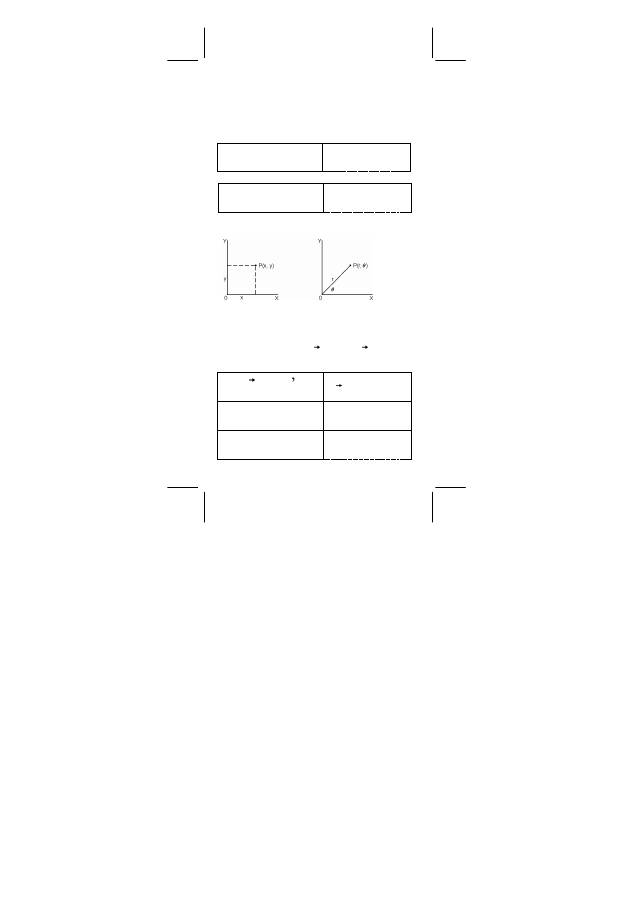
SR260B_SR-281N_Italian_v090330.doc SIZE:140x75mm SCALE 1:1
2009/3/31
-It 16-
Funzioni Iperboliche/ Ip. Inverse
SR-281N
usano [ 2nd ] [ HYP ] per calcolare le funzioni iperboliche e
iperboliche inverse - sinh, cosh, tanh, sinh
–1
, cosh
–1
e tanh
–1
.
(Nota) : Usando questi tasti, assicurarsi che la calcolatrice sia regolata
sull’unità degli angoli desiderati.
¾
cosh 1.5 + 2 = 4.35240961524
DEG
c o s h 1
.
5 + 2 =
[ 2nd ] [ HYP ] [ cos ] 1.5 [ + ] 2 [ = ]
4
.
3 5 2 4 0 9 6 1 5 2 4
¾
sinh
–1
7 = 2.64412076106
DEG
s i n h 1
–1
7 =
[ 2nd ] [ HYP ] [ 2nd ] [ sin
–1
] 7 [ = ]
2
.
6 4 4 1 2 0 7 6 1 0 6
Trasformazione delle Coordinate
Coordinata Rettangolare Coordinata Polare
x + y i = r (cos
θ
+ i sin
θ
)
(Nota) : Usando queste funzioni, assicurarsi che la calcolatrice sia
regolata sull’unità degli angoli desiderati.
La calcolatrice può eseguire la conversione tra coordinate rettangolari
e coordinate polari con [ 2nd ] [ P R ] e [ 2nd ] [ R P ].
¾
Se x = 5, y = 30, cosa sono,
θ
? Risp : r = 30.4138126515,
θ
= 80.537677792
o
DEG
( )
R
P ( 5
,
[ 2nd ]
[ R P ] 5 [ 2nd ] [ ] 30
3 0
DEG
r
[ = ]
3 0
.
4 1 3 8 1 2 6 5 1 5
DEG
θ
[ 2nd ] [ X
↔
Y ]
8 0
.
5 3 7 6 7 7 7 9 2

SR260B_SR-281N_Italian_v090330.doc SIZE:140x75mm SCALE 1:1
2009/3/31
-It 17-
¾
Se r = 25,
θ
= 56
o
cosa sono x , y ? Risp : x = 13.9798225868,
y = 20.7259393139
DEG
( )
P
R ( 2 5
,
[ 2nd ] [ P R ] 25 [ 2nd ] [ ] 56
5 6
DEG
X
[ = ]
1 3
.
9 7 9 8 2 2 5 8 6 8
DEG
Y
[ 2nd ] [ X
↔
Y ]
2 0
.
7
2 5 9 3 9 3 1 3 9
Probabilità
Questa calcolatrice fornisce le seguenti funzioni di probabilità :
[nPr]
Calcola il numero di permutazioni possibili dii n voci
prendendo r alla volta.
[ nCr ] Calcola il numero di combinazioni possibili de n voci
prendendo r alla volta.
[ x ! ]
Calcola il fattoriale di un intero n positive specificato, dove n
≦
69.
[ RND ] Genera un numero casuale fra 0.000 e 0.999
¾
840
!
]
)
4
7
(
[
!
7
=
−
DEG
7 P 4 =
7 [ 2nd ] [ nPr ] 4 [ = ]
8 4 0
.
¾
5
3
!
]
)
4
7
(
[
!
4
!
7
=
−
DEG
7 C 4 =
7 [ 2nd ] [ nCr ] 4 [ = ]
3 5
.
¾
5 ! = 120
DEG
5 ! =
5 [ 2nd ] [ x ! ] [ = ]
1 2 0
.
¾
Genera un numero casuale fra 0.000 ~ 0.999
DEG
R n d
[ 2nd ] [ RND ]
0
.
4 4 9

SR260B_SR-281N_Italian_v090330.doc SIZE:140x75mm SCALE 1:1
2009/3/31
-It 18-
Altre funzioni ( 1/x, ,
3
,
X
, x 2, x 3, x y , INT,
FRAC )
La calcolatrice fornisce anche funzioni reciproca ( [ 2nd ] [ 1/x ] ),
radice quadrata ( [
√
] ), radice cubica ( [ 2nd ] [
3
] ), radice
universale ( [ 2nd ] [
X
] ), quadrato ( [ x
2
] ), cubico ( [ 2nd ] [ x
3
] ),
ed esponenziazione ( [ x
y
] ).
¾
8
.
0
.25
1
1
=
DEG
1
.
2 5
–1
=
1.25 [ 2nd ] [ 1 / x ] [ = ]
0
.
8
¾
139
=
5
+
125
+
21
+
4
+
2
3
3
2
DEG
2
2
+
√
( 4 + 2 1 ) +
2 [ x
2
] [ + ] [
√
] [ ( ] 4 [ + ] 21 [ ) ]
[ + ] [ 2nd ] [
3
] 125 [ + ] 5 [ 2nd ]
[ x
3
] [ = ]
1 3
9
.
¾
16812
=
625
+
7
4
5
DEG
7 x
y
5 + 4
X
√
6 2 5 =
7 [ x
y
] 5 [ + ] 4 [ 2nd ] [
X
] 625 [ = ]
1 6 8 1
2
.
INT
Indica la parte intera di un numero dato
FRAC
Indica la parte frazionaria di un numero dato
¾
INT ( 10 8 ) = INT ( 1.25 ) = 1
DEG
I N T ( 1 0
8 =
[ 2nd ] [ INT ] 10 [ ] 8 [ = ]
1
.
¾
FRAC ( 10 8 ) = FRAC ( 1.25 ) = 0.25
DEG
F R A C ( 1 0
8 =
[ 2nd ] [ FRAC ] 10 [ ] 8 [ = ]
0
.
2 5
Conversione degli Unità
La calcolatrice tiene una caratteristica di conversione degli unità
incorporata que permette convertire numeri tra unità differenti.
1. Digitare il numero che si vuole convertire.
2. Premere [ CONV ] per visualizzare il menù. Ci sono 7 menu,
coprendo distanza, area, temperatura, capacità, peso, energia,e
pressione.
3.
Usare [ CONV ] per spostare attraverso l’elenco di unità fino a
mostrare l’unità appropriate, poi premere [ = ].
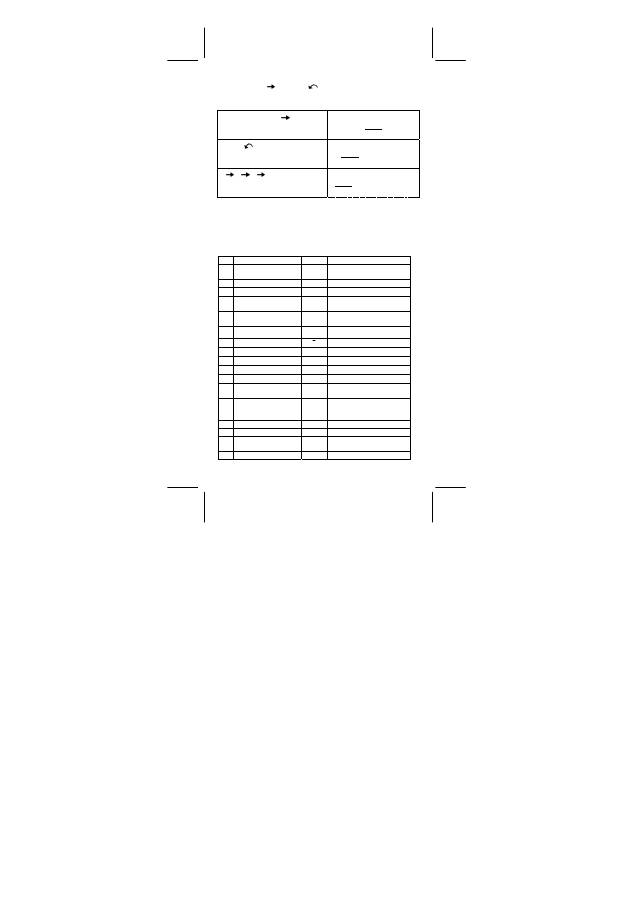
SR260B_SR-281N_Italian_v090330.doc SIZE:140x75mm SCALE 1:1
2009/3/31
-It 19-
4.
Premendo [ ] o [ 2nd ] [
] può convertire il numero a una
altra unità.
¾
1 y d
2
= 9 f t
2
= 0.00000083612 km
2
DEG
f t
2
y d
2
m
2
1 [ CONV ] [ CONV ] [
] [ = ]
1
.
DEG
f t
2
y d
2
m
2
[ 2nd ] [
]
9
.
DEG
k m
2
h e c t a r e s
[
] [
] [
]
0
.
0 0 0 0 0 0 8 3 6 1 2
Costanti Fisiche
Si può usare 136 costanti fisiche in suoi calcoli. Con le seguenti
costanti :
Dati si riferiscono a Peter J.Mohr e Barry N.Taylor, CODATA
Recommended Values of the Fundamental Physical Constants :1998,
Journal of Physical and Chemical Reference Data,Vol.28, No.6,1999
and Reviews of Modern Physics,Vol.72, No.2, 2000.
No. Quantità Simbolo
Valore,
Unità
1.
Velocità della luce nel
vuoto
c
299792458 m s
–1
2. Costante
Magnetica
μ
0
1.2566370614 x10
–6
N A
–2
3. Costante
Elettrica
ε
0
8.854187817 x 10
–12
F m
–1
4.
Impedenza Caratteristica
nel vuoto
Z
0
376.730313461
Ω
5.
Costante gravitazionale
Newtoniano
G 6.67310
x10
–11
m
3
kg
–1
s
–2
6.
Costante di Planck
h
6.6260687652 x10
–34
J s
7.
Costante di Planck su 2 pi
h
1.05457159682 x10
–34
J s
8.
Costante di Avogadro
N
A
6.0221419947 x10
23
mol
–1
9.
Lunghezza di Planck
lp
1.616012 x10
–35
m
10. Tempo di Planck
tp
5.390640 x10
–44
s
11. Massa di Planck
mp
2.176716 x10
–8
kg
12.
Costante di massa
Atomica
m
μ
1.6605387313 x10
–27
kg
13.
Equivalente di energia
costante della massa
atomica
m
μ
c
2
1.4924177812 x10
–10
J
14. Costante di Faraday
IF
96485.341539 C mol
–1
15. Carica Elementare
e
1.60217646263 x10
–19
C
16.
Rapporto Elettrone volt–
joule
eV 1.60217646263
x10
–19
J
17. Carica Elementare su h
e/h
2.41798949195 x10
14
AJ
–1

SR260B_SR-281N_Italian_v090330.doc SIZE:140x75mm SCALE 1:1
2009/3/31
-It 20-
18. Constante di gas molare
R
8.31447215 J mol
–1
K
–1
19. Costante di Boltzmann
k
1.380650324 x10
–23
J K
–1
20. Costante di planck molare
N
A
h 3.99031268930x10
–10
Js mol
–1
21.
Costante di Sackur–
Tetrode
S
0
/R
–
1.164867844
22.
Costante di spostamento
di Wien
b 2.897768651
x10
–3
m K
23.
Parametro Reticolato di
silicio
a 543.10208816
x10
–12
m
24.
Costante di Stefan–
Boltzmann
σ
5.67040040 x10
–8
W m
–2
K
–4
25.
Accelerazione di gravità
standard
g
9.80665 m s
–2
26.
Rapporto delle masse
unità–chilogrammo
μ
1.6605387313 x10
–27
kg
27.
Costante di prima
radiazione
c
1
3.7417710729 x10
–16
Wm
2
28.
Costante di prima
radiazione per radianza
spectrale
c
1
L
1.19104272293x10
–16
Wm
2
sr
–1
29.
Costante di Seconda
Radiazione
c
2
1.438775225 x10
–2
m K
30.
Volume Molare del gas
ideale
Vm
22.41399639 x10
–3
m
3
mol
–1
31. Costante di Rydberg
R
∞
10973731.5685 m
–1
32.
Costante di Rydberg in
Hz
R
∞
c
3.28984196037 x10
15
Hz
33.
Costante di Rydberg in
joules
R
∞
hc
2.1798719017 x10
–18
J
34. Energia di Hartree
E
h
4.3597438134 x10
–18
J
35. Quantum di circolazione
h/me
7.27389503253 x10
–4
m
2
s
–1
36. Costante di struttura fina
α
7.29735253327 x10
–3
37. Costante di Loschmidt
n
0
2.686777547
x10
25
m
–3
38. Raggio di Bohr
a
0
0.52917720832
x10
–10
m
39.
Quantum del flusso
Magnetico
Φ
0
2.06783363681 x10
–15
Wb
40. Quantum di Conduttività
G
0
7.74809169628
x10
–5
S
41.
Quantum di Conduttività
Inversa
G
0
–1
12906.4037865
Ω
42. Costante di Josephson
KJ
483597.89819 x10
9
Hz V
–1
43. Costante di Von Klitzing
RK
25812.8075730
Ω
44. Magneton di Bohr
μ
B
927.40089937 x10
–26
J T
–1
45. Magneton di Bohr in Hz/T
μ
B/h
13.9962462456 x10
9
Hz T
–1
46. Magneton di Bohr in K/T
μ
B/k
0.671713112 K T
–1
47. Magneton Nucleare
μ
N
5.0507831720 x10
–27
J T
–1
48.
Magneton Nucleare in
MHz/T
μ
N/h
7.6225939631 MHz T
–1
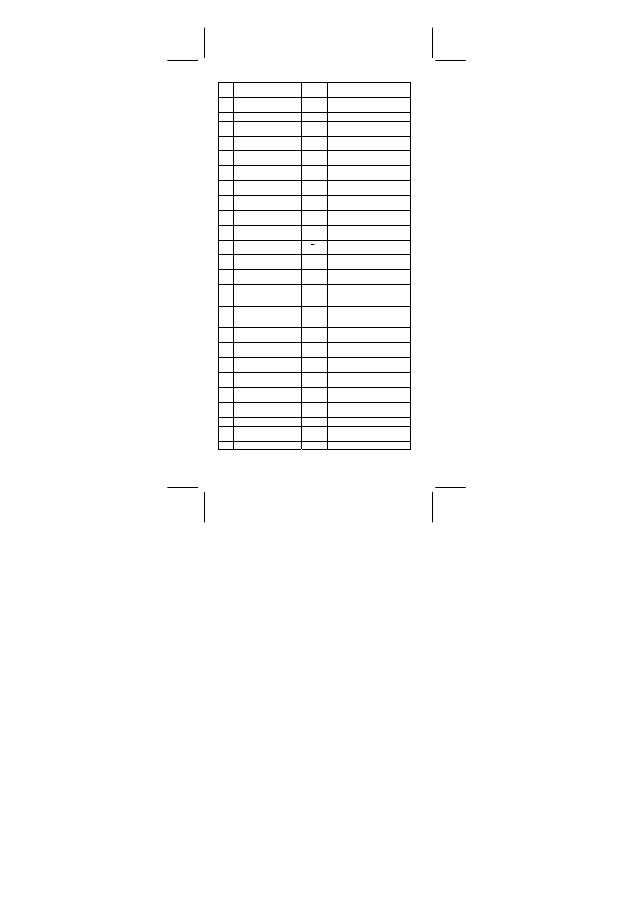
SR260B_SR-281N_Italian_v090330.doc SIZE:140x75mm SCALE 1:1
2009/3/31
-It 21-
49.
Magneton Nucleare in
K/T
μ
N/k
3.658263864 x10
–4
K T
–1
50.
Raggio del elettrone
classico
re
2.81794028531 x10
–15
m
51. Massa del Elettrone
me
9.1093818872 x10
–31
kg
52.
Equivalente di energia de
la massa del elettrone
mec
2
8.1871041464 x10
–14
J
53.
Rapporto delle masse
elettrone-muone
me/m
μ
4.8363321015 x10
–3
54.
Rapporto delle masse
elettrone-tau
me/m
τ
2.8755547 x10
–4
55.
Rapporto delle masse
elettrone-protone
me/mp
5.44617023212 x10
–4
56.
Rapporto delle masse
elettrone–neutrone
me/mn
5.43867346212 x10
–4
57.
Rapporto delle masse
elettrone–deuterone
me/md
2.72443711706x10
–4
58.
Carica del elettrone al
quoziente di massa
–
e/me
–
1.75882017471 x10
11
Ckg
–1
59.
Lunghezza d’onda di
Compton
λ
c
2.42631021518 x10
–12
m
60.
Lunghezza d’onda di
Compton su 2 pi
λ
c
386.159264228 x10
–15
m
61.
Sezione d’urto di
Thomson
σ
e
0.66524585415 x10
–28
m
2
62.
Momento magnetico
dell’elettrone
μ
e
–
928.47636237x10
–26
J T
–1
63.
Momento magnetico
dell’elettrone in
magnetoni di Bohr
μ
e/
μ
B
–
1.00115965219
64.
Momento magnetico
dell’elettrone in
magnetoni nucleari
μ
e/
μ
N
–
1838.28196604
65.
Momento magnetico
dell’Elettrone–muone
μ
e/
μ
μ
206.766972063
66.
Momento magnetico
dell’Elettrone–protone
μ
e/
μ
p
–
658.210687566
67.
Momento magnetico
dell’Elettrone–neutrone
μ
e/
μ
n
960.9205023
68.
Momento magnetico
dell’Elettrone–deuterone
μ
e/
μ
d
–
2143.92349823
69.
Momento schermato del
elettrone helione
μ
e/
μ
'h
864.05825510
70.
Anomalia del momento
magnetico dell’elettrone
a e
1.15965218694 x10
–3
71. Fattore g dell’elettrone
g e
–
2.00231930437
72.
Rapporto giromagnetico
dell’elettrone
γ
e
1.76085979471 x10
11
s
–1
T
–1
73. Massa di muone
m
μ
1.8835310916 x10
–28
kg

SR260B_SR-281N_Italian_v090330.doc SIZE:140x75mm SCALE 1:1
2009/3/31
-It 22-
74.
Equivalente di energia
della massa del muone
m
μ
c
2
1.6928333214 x10
–11
J
75.
Rapporto delle masse
muone–tau
m
μ
/m
τ
5.9457297 x10
–2
76.
Rapporto delle masse
muone–protone
m
μ
/mp
0.11260951733
77.
Rapporto delle masse
muone–neutrone
m
μ
/mn
0.11245450793
78.
Anomalia del momento
magnetico del muone
a
μ
1.1659160264 x10
–3
79. Fattore g del muone
g
μ
–
2.00233183201
80.
Lunghezza d’onda di
Compton del muone
λ
c,
μ
11.7344419735 x10
–15
m
81.
Lunghezza d’onda di
Compton del muone su 2
pi
λ
c,
μ
1.86759444455 x10
–15
m
82.
Momento magnetico del
muone
μ
μ
–
4.4904481322x10
–26
J T
–1
83.
Momento magnetico del
muone in magnetoni di
Bohr
μ
μ
/
μ
B
–
4.8419708515 x10
–3
84.
Momento magnetico del
muone in magnetoni
nucleari
μ
μ
/
μ
N
–
8.8905977027
85.
Rapporto del momento
magnetico del muone-
prottone
μ
μ
/
μ
p
–
3.1833453910
86.
Lunghezza d’onda di
Compton del Tau
λ
c,
τ
0.6977011 x10
–15
m
87.
Lunghezza d’onda di
Compton del Tau su 2 pi
λ
c,
τ
0.11104218 x10
–15
m
88. Massa di Tau
m
τ
3.1678852 x10
–27
kg
89.
Equivalente energia di
massa Tau
m
τ
c
2
2.8471546 x10
–10
J
90.
Rapporto di massa Tau–
protone
m
τ
/mp
1.8939631
91.
Lunghezza d’onda di
Compton del Protone
λ
c,p
1.32140984710 x10
–15
m
92.
Lunghezza d’onda di
Compton del protone su 2
pi
λ
c,p
0.21030890892 x10
–15
m
93. Massa del Protone
mp
1.6726215813 x10
–27
kg
94.
Equivalente di energia
della massa di protone
mpc
2
1.5032773112 x10
–10
J
95.
Rapporto di massa
protone–neutrone
mp/mn
0.99862347856
96.
Quoziente di massa della
carica del protone
e/mp
9.5788340838 x10
7
C kg
–1
97.
Momento magnetico del
Protone
μ
p
1.41060663358 x10
–26
J T
–1
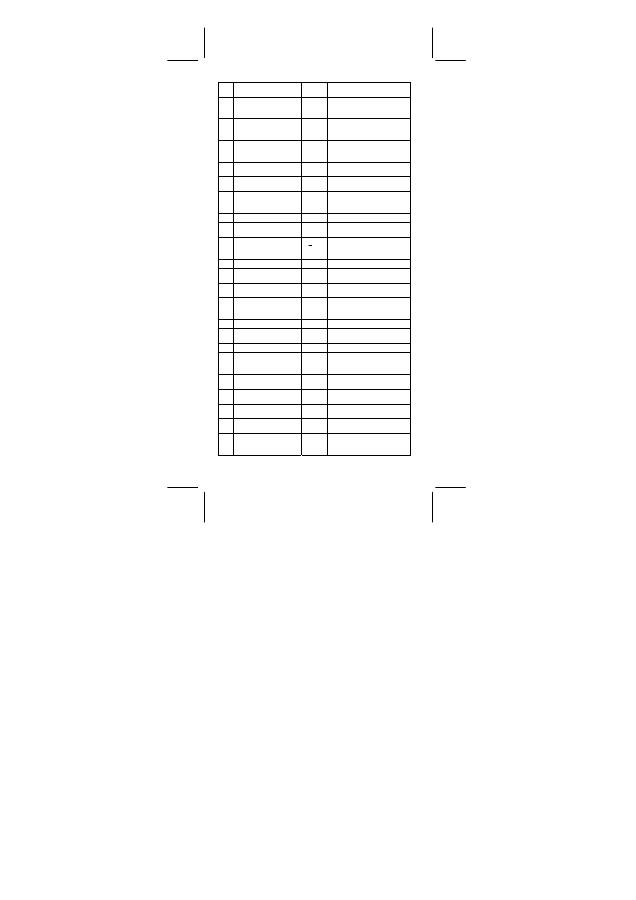
SR260B_SR-281N_Italian_v090330.doc SIZE:140x75mm SCALE 1:1
2009/3/31
-It 23-
98.
Momento magnetico
schermato del protone
μ
'p
1.41057039959 x10
–26
J T
–1
99.
Momento magnetico del
protone in magnetoni
nucleari
μ
p/
μ
N
2.79284733729
100.
Rapporto del momento
magnetico protone–
neutrone
μ
p/
μ
n
–
1.4598980534
101.
Momento magnetico
schermato del protone in
magnetoni di Bohr
μ
'p/
μ
B
1.52099313216 x10
–3
102.
Rapporto giromagnetico
del protone
γ
p
2.6752221211 x10
8
s
–1
T
–1
103.
Rapporto giromagnetico
schermato del protone
γ
'p
2.6751534111 x10
8
s
–1
T
–1
104.
Correzione di
schermatura magnetica
per il protone
σ
'p
25.68715 x10
–6
105. Fattore g protone
g p
5.58569467557
106.
Lunghezza d’onda di
Compton del neutrone
λ
c,n
1.31959089810 x10
–15
m
107.
Lunghezza d’onda di
Compton del neutrone su
2 pi
λ
c,n
0.21001941422 x10
–15
m
108. Massa del Neutrone
mn
1.6749271613 x10
–27
kg
109.
Equivalente di energia
della massa del neutrone
mnc
2
1.5053494612 x10
–10
J
110.
Momento magnetico del
Neutrone
μ
n
–
0.9662364023x10
–26
J T
–1
111.
Momento magnetico del
neutrone in magnetoni di
Bohr
μ
n/
μ
B
–1.0418756325 x10
–3
112. Fattore g del Neutrone
gn
–
3.8260854590
113.
Rapporto giromagnetico
del neutrone
γ
n
1.8324718844 x10
8
s
–1
T
–1
114. Massa del Deuterone
md
3.3435830926 x10
–27
kg
115.
Equivalente di energia
della massa del
deuterone
mdc
2
3.0050626224 x10
–10
J
116.
Massa molare del
deuterone
M(d) 2.01355321271x10
–3
kg
mol
–1
117.
Rapporto della massa del
deuterone–elettrone
md/me
3670.48295508
118.
Rapporto della massa del
deuterone–protone
md/mp
1.99900750083
119.
Momento magnetico del
deuterone
μ
d
0.43307345718 x10
–26
J T
–1
120.
Momento magnetico del
deuterone in magnetoni di
Bohr
μ
d/
μ
B
0.46697545565 x10
–3
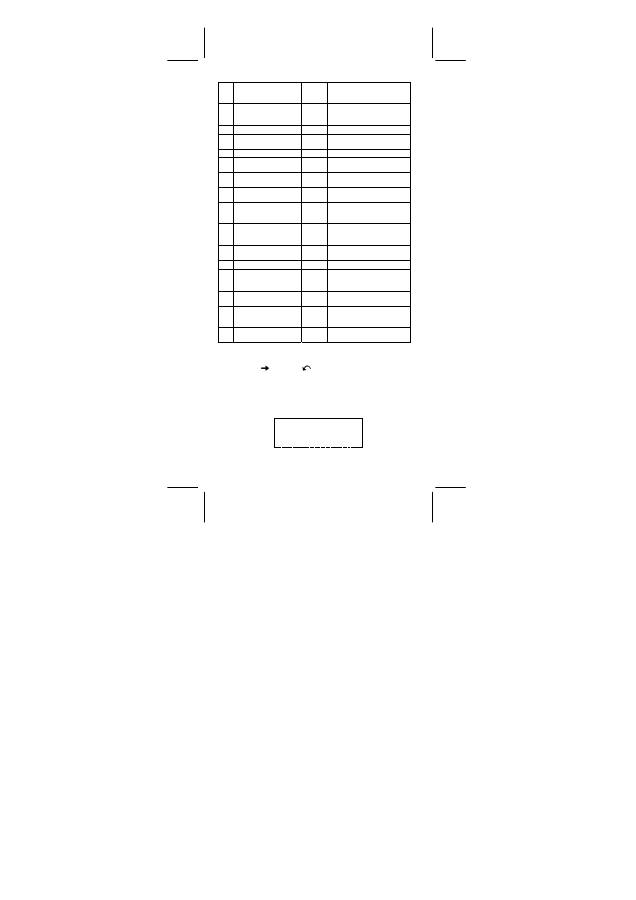
SR260B_SR-281N_Italian_v090330.doc SIZE:140x75mm SCALE 1:1
2009/3/31
-It 24-
121.
Momento magnetico del
deuterone in magnetoni
nucleari
μ
d/
μ
N
0.85743822849
122.
Rapporto del momento
magnetico del
deuterone–protone
μ
d/
μ
p
0.30701220835
123. Massa del helione
mh
5.0064117439 x10
–27
kg
124.
Equivalente di energia
della massa del helione
mhc
2
4.4995384835 x10
–10
J
125. Massa molare del helione
M(h)
3.01493223470x10
–3
kg mol
–1
126.
Rapporto della massa
helione–elettrone
mh/me
5495.88523812
127.
Rapporto della massa
helione–protone
mh/mp
2.99315265851
128.
Momento magnetico
schermato del helione
μ
'h
–
1.07455296745 x10
–26
J T
–1
129.
Momento magnetico
schermato del helione in
magnetoni di Bohr
μ
'h/
μ
B
–
1.15867147414 x10
–3
130.
Momento magnetico
schermato del helione in
magnetoni nucleari
μ
'h/
μ
N
–
2.12749771825
131.
Rapporto giromagnetico
del helione
γ
'h
2.03789476485 x10
8
s
–1
T
–1
132. Massa della particella alfa
m
α
6.6446559852 x10
–27
kg
133.
Equivalente di energia
della massa di particella
alfa
m
α
c
2
5.9719189747 x10
–10
J
134.
Massa molare della
particella alfa
M(
α
)
4.00150617471 x10
–3
kg
mol
–1
135.
Rapporto della massa
dell’elettrone per
particella alfa
m
α
/me
7294.29950816
136.
Rapporto della massa del
protone per particella alfa
m
α
/mp
3.97259968461
Per inserire una costante alla posizione del cursore :
1. Premere [ CONST ] per visualizzare il menù di costanti fisiche..
2. Premere [ ] o [ 2nd ] [
] fino a sottolineare la costante
desiderata.
3. Premere [ = ].
Si può anche usare il tasto [ CONST ] in combinazione con un numero
1 a 136,per richiamare costanti fisiche. Per esempio, premere 15
[ CONST ].
DEG
e
1
.
6 0 2 1 7 6 4 6 2 6 3
–19
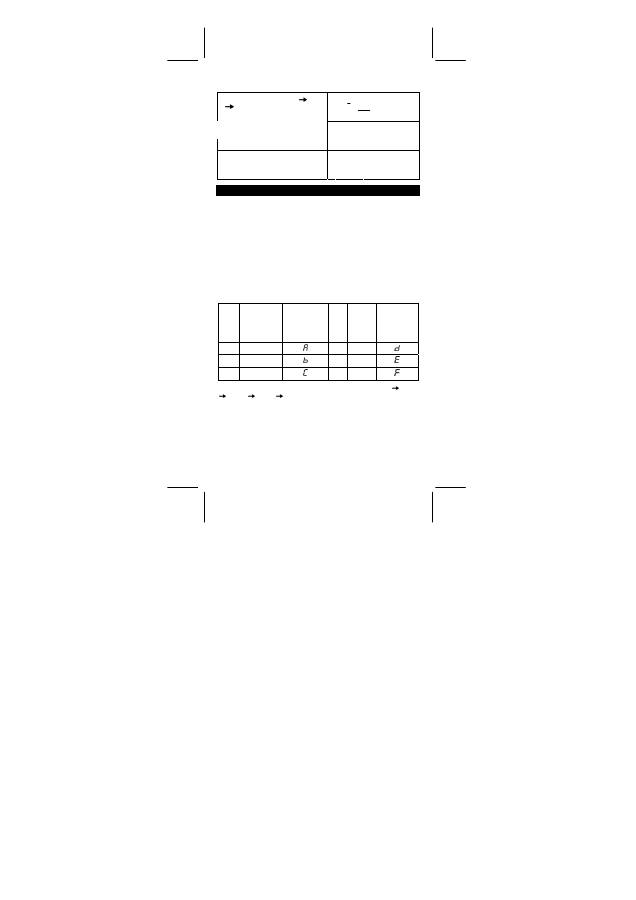
SR260B_SR-281N_Italian_v090330.doc SIZE:140x75mm SCALE 1:1
2009/3/31
-It 25-
¾
3 x N
A
= 1.80664259841 x 10
24
CONST DEG
h
h
N
A
l p
t p
3 [ x ] [ CONST ] [ CONST ] [
]
[
]
6
.
0 2 2 1 4 1 9 9 4 7
23
CONST DEG
0 0 8
:
m o l
–1
[ = ]
6
.
0 2 2 1 4 1 9 9 4 7
23
CONST DEG
3
¼
N
A
=
[ = ] [ = ]
1
.
8 0 6 6 4 2 5 9 8 4 1
24
Calcoli di Base–n
Usare modalità MAIN ( [ MODE ] 1 ( MAIN ) ) per calcoli di Base–n .
La unità permette di calcolare in base numerica altra che la decimale..
La calcolatrice può aggiungere, sotrarre, moltiplicare e dividere numeri
binari, ottali, ed esadecimali.
I numerali mostratidi seguito possono essere usati in ogni base di
numero.
Base binaria ( b ) : 0, 1
Base ottale ( o ) : 0, 1, 2, 3, 4, 5, 6, 7
Base decimale : 0, 1, 2, 3, 4, 5, 6, 7, 8, 9
Base Esadecimale ( h ) : 0, 1, 2, 3, 4, 5, 6, 7, 8, 9, A, B, C, D, E, F
Per distinguere A, B, C, D, E e F usato nella base esadecimale dalle
lettere standard, loro sono visualizzati di seguito.
Tasto
Visualizzazion
e
(Superiore)
Visualizzazione
(Inferiore)
Tasto
Visualizz
azione
(Superior
e)
Visualizzazion
e
(Inferiore)
A /A
D
ID
B IB
E IE
C
I
C
F
IF
Selezionare la base numerica che si vuole usare con [
BIN ],
[ OCT ], [ DEC ], [ HEX ]. Gli indicatori " BIN ", " b ", " OCT ", " o ",
" HEX ", " h " le mostranno che base numerica si sta usando. Se non
apparire nessun indicatori nella visualizzazione, la base è decimale.
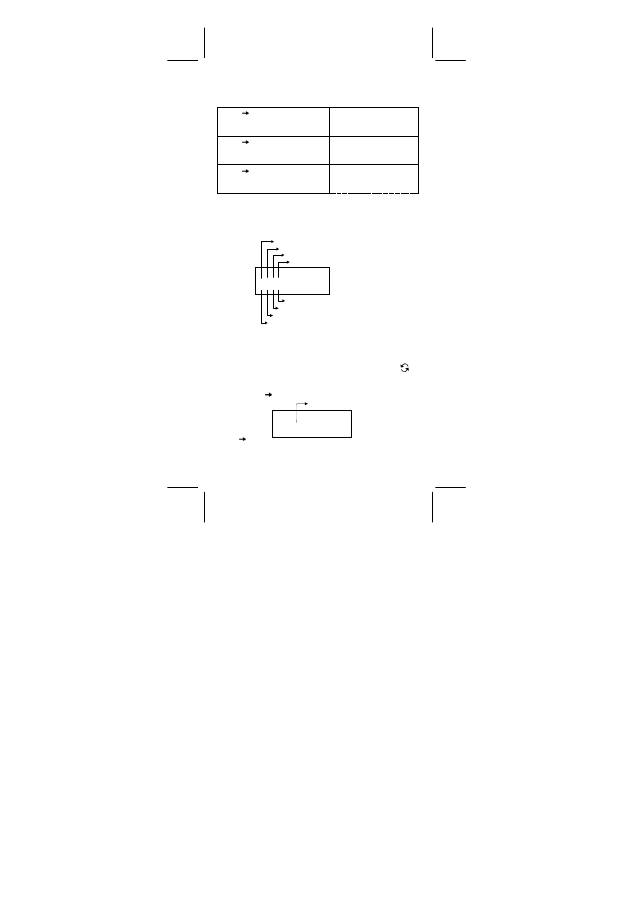
SR260B_SR-281N_Italian_v090330.doc SIZE:140x75mm SCALE 1:1
2009/3/31
-It 26-
Conversioni di Base
¾
37 (base 8) = 31 (base 10) = 1F (base 16)
DEG
OCT
[ 2nd ] [ OCT ] 37
0 0 0 0 0 0 0 0 0 3 7
o
DEG
[ 2nd ] [ DEC ]
3 1
.
DEG
HEX
[ 2nd ] [ HEX ]
0 0 0 0 0 0 1 F
h
Funzione di Blocco
Un risultato in base binaria, che supera 8 cifre, viene visualizzato con
la funzione di blocco. Un massimo di 32 cifre viene visualizzato in 4
blocchi da 8 cifre.
1 1 0 1 0 0 1 1
b
DEG BIN
Indica totale di blocchi : 1 blocco
Indica Blocco 1 attualmente visualizzato
Indica Blocco 2 attualmente visualizzato
Indica Blocco 3 attualmente visualizzato
Indica Blocco 4 attualmente visualizzato
Indica totale di blocchi : 2 blocchi
Indica totale di blocchi : 3 blocchi
Indica totale di blocchi : 4 blocchi
La funzione di blocco comprende gli indicatori superiore ed inferiore. Il
indicatore superiore significa posizione di blocco attuale, ed il
indicatore inferiore significa totale di blocchi per un risultato.
Nel modo binario, il blocco 1 viene visualizzato subito dopo il calcolo.
Altri blocchi ( blocco 2 ~ blocco 4 ) sono visualizzati premendo [
].
Per esempio, digitare 47577557
16
Premere [ 2nd ] [ HEX ] 47577557
[ 2nd ] [ BIN ]
0 1 0 1 0 1 1 1
b
DEG BIN
– –
Indica Blocco 1 attualmente visualizzato

SR260B_SR-281N_Italian_v090330.doc SIZE:140x75mm SCALE 1:1
2009/3/31
-It 27-
[
]
0 1 1 1 0 1 0 1
b
DEG BIN
–
–
Indica Blocco 2 attualmente visualizzato
[
]
0 1 0 1 0 1 1 1
b
DEG BIN
– –
Indica Blocco 3 attualmente visualizzato
[
]
0 1 0 0 0 1 1 1
b
DEG BIN
– – –
Indica Blocco 1 attualmente visualizzato
47577557
16
= Blocco 4 + Blocco 3 + Blocco 2 + Blocco 1
= 01000111010101110111010101010111
2
Operazioni aritmetiche elementari per basi
¾
1IEIF
16
+ 1234
10
1001
2
= 1170
8
DEG
OCT
h 1 IE IF + 1 2 3 4
b 1
[ 2nd ] [ HEX ] 1E F [ + ] [ 2nd ]
[ DEC ] 1234 [ ] [ 2nd ] [ BIN ] 1001
[ = ] [ 2nd ] [ OCT ]
0 0 0 0 0 0 0 1 1 7 0
o
Espressioni Negative
In basi binaria, ottali, ed esadecimali, la calcolatrice rappresenta
numeri negativi usando notazione in complemento. Il complemento è
il risultato della sottrazione di quel numero da
100000000000000000000000000000000 nella base numerica,
premendo tasto [ NEG ] in basi non decimali.
¾
3/A
16
= NEG IFIFIFIFIFIFIC6
16
DEG
HEX
N E G
h 3 /A
[ 2nd ] [ HEX ] 3 A [ NEG ]
F F F F F F C 6
H
Operazione Logica
Operazioni logiche si eseguono tramite i prodotti logici (AND),
negativo logico (NAND), somme logiche (OR), somme logiche
esclusive (XOR), negazioni (NOT), e negazione di somme logiche
esclusive (XNOR).

SR260B_SR-281N_Italian_v090330.doc SIZE:140x75mm SCALE 1:1
2009/3/31
-It 28-
¾
1010
2
AND ( /A
16
OR 7
16
) = 12
8
DEG
OCT
b 1 0 1 0
A N D
( h
[ 2nd ] [ BIN ] 1010 [ AND ] [ ( ] [ 2nd ]
[ HEX ] A [ OR ] 7 [ ) ] [ = ] [ 2nd ]
[ OCT ]
0 0 0 0 0 0 0 0 0 1 2
o
Calcoli
Statistici
Usare modalità STAT ( [ MODE ] 2 ( STAT ) ) per calcoli statistici.
Le calcolatrici possono eseguire calcoli statistici a variabile singola e a
variabili doppia in questa modalità.
Premere [ MODE ] 2 ( STAT ) per immettere modalità STAT. Ci sono
sei voci nella modalità STAT le chiedendo per selezionare uno di loro.
DEG
1–VAR LIN LOG
STAT
[
] [
] [
]
DEG
EXP PWR D–CL
STAT
Statistiche a variabile singola
1–VAR
Statistiche a variabile singola
Statistiche a variabile doppia / regressione
LIN
Regressione Lineare
y = a + b x
LOG
Regressione Logaritmica y = a + b lnx
EXP
Regressione Esponenziale y = a • e
bx
POW
Regressione di Potenza y = a • x
b
D–CL
Eliminare tutti dati statistici
Immissione di Dati
Assicurarsi sempre di eliminare i dati statistici con D–CL prima di
eseguire calcoli statistici.
(A) Per immettere dato a variabile singola usando le seguenti sintassi :
# Dato Individuale : [ DATA ] < valore x >
# Dato multiplo di stesso valore :
[ DATA ] < valore x > [ x ] < Numero di dati ripetuti >
(B) Per immettere variabile doppia / dato di regressione usando le
seguenti sintassi :
# Gruppo di dato individuale : [ DATA ] <valore x> [ ] <valore y >
# Dati multipli di stesso valore :
[ DATA ] < valore x > [ ] < valore y > [ x ] < Numero di dati
ripetuti>
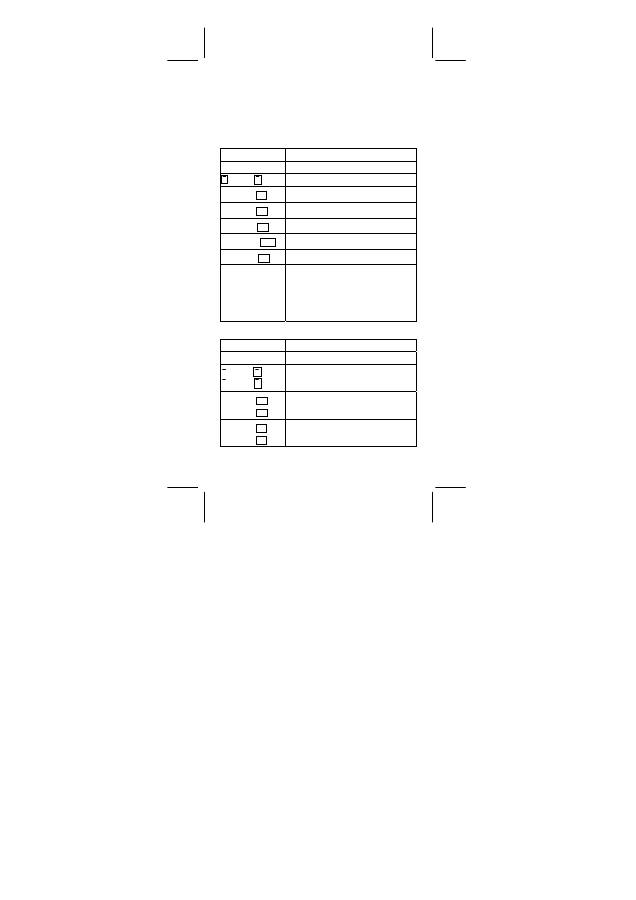
SR260B_SR-281N_Italian_v090330.doc SIZE:140x75mm SCALE 1:1
2009/3/31
-It 29-
(Nota) : Anche uscendo dal modo STAT, tutti i dati sono mantenuti a
meno che di cancellarli tutti selezionando il modo D-CL.
Visualizzazione dei Risultati
I valori delle variabili statistiche dipendono dei dati immessi. Si può
richiamare i valori con operazioni di tasti illustrati di seguito.
Calcoli di statistiche a variabili singole
Variabili
Significato
n ( [ n ] )
Numero di valori x immessi
x
( [2nd]+[
x
] )
Significato dei valori x
Sx
( [2nd]+[
Sx
] )
Deviazione standard di un campione per I
valori x
σ
x
( [2nd]+[
σ
x
] )
Deviazione standard della popolazione per I
dati x
∑
x
( [2nd]+[
∑
x
] )
Somma dei dati per i valori x
∑
x
2
( [2nd]+[
∑
x
2
]) Somma di tutti i valori x
2
CP
( [2nd]+[
CP
] )
Precisione potenziale di capacità per dati x
CPK ( [CPK] )
Minimo (CPU, CPL) per i dati x, dove CPU è
il limite specifico superiore di precisione
della capacità e CPL è il limite specifico
inferiore di precisione della capacità.
CPK = Min ( CPU , CPL ) = CP ( 1 – Ca )
Statistiche a variabili doppia / Calcoli di Regressione
Variabili
Significato
n ( [ n ] )
Numero di pari x-y immessi
x
( [2nd]+[
x
] )
y
( [2nd]+[ y
] )
Significato dei valori x o valori y
Sx
( [2nd]+[ Sx ] )
Sy
( [2nd]+[ Sy ] )
Deviazione standard di campione dei valori x
o valori y
σ
x
( [2nd]+[
σ
x
] )
σ
y
( [2nd]+[
σ
y
] )
Deviazione standard della popolazione per i
valori x o valori y

SR260B_SR-281N_Italian_v090330.doc SIZE:140x75mm SCALE 1:1
2009/3/31
-It 30-
∑
x
( [2nd]+[
∑
x
] )
∑
y
( [2nd]+[
∑
y
] )
Somma di tutti valori x o valori y
∑
x
2
( [2nd]+[
∑
x
2
])
∑
y
2
( [2nd]+[
∑
y
2
])
Somma di tutti valori x
2
o valori y
2
∑
x y
Somma di ( x • y ) per tutti pari x-y
CP
( [2nd]+[
CP
] )
Precisione potenziale di capacità per valori x
CPK ( [ CPK ] )
Minimo (CPU, CPL) per i dati x, dove CPU è
il limite specifico superiore e CPL è il limite
specifico inferiore di precisione della
capacità
CPK = Min ( CPU , CPL ) = CP ( 1 – Ca )
a ( [2nd]+[
a ] )
Termine costante di regressione a
b ( [2nd]+[
b ] )
Termine costante di regressione b
r ( [2nd]+[
r ] )
Coefficiente di correlazione r
x
’
([ x
’
] )
Valore Stimato di x
y
’
([ y
’
] )
Valore Stimati di y
Si può anche aggiungere un dato nuovo in qualsiasi momento. L’unità
ricalcola statistiche automaticamente ogni volta che si preme [ DATA ]
e si immette un valore nuovo.
¾
Immettere dato : USL
= 95, LSL = 70, DATA 1 = 75, DATA 2 = 85,
DATA 3 = 90, DATA 4 = 82, DATA 5 = 77, poi trovare n = 5, =
81.8, Sx = 6.05805249234,
σ
x = 5.41848687366, CP =
0.76897236513, e CPK = 0.72590991268
DEG
STAT
1–
V A R
L I N
L O G
[ MODE ] 2
DEG
STAT
D A T A
5
[ = ] [ DATA ] 75 [ DATA ] 85 [ DATA ] 90
[ DATA ] 82 [ DATA ] 77
7 7
DEG
STAT
n
[ n ]
5
.
DEG
STAT
x
[ 2nd ] [
x
]
8 1
.
8
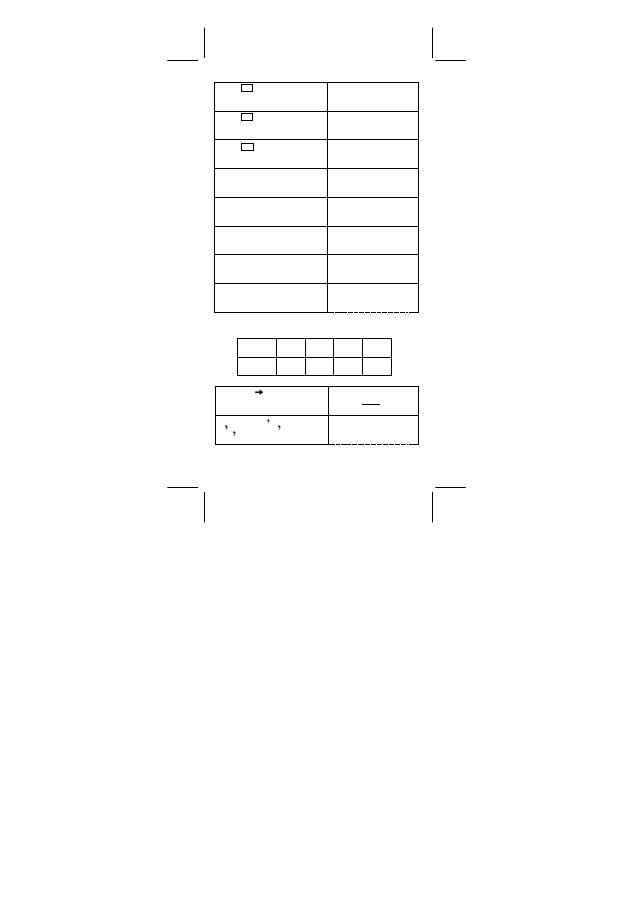
SR260B_SR-281N_Italian_v090330.doc SIZE:140x75mm SCALE 1:1
2009/3/31
-It 31-
DEG
STAT
S x
[ 2nd ] [ Sx ]
6
.
0 5 8 0 5 2 4 9 2 3 4
DEG
STAT
σ
x
[ 2nd ] [
σ
x ]
5
.
4 1 8 4 8 6 8 7 3 6 6
DEG
STAT
U S L =
[ 2nd ] [ CP
] 95
9 5
CP
USL
DEG
STAT
L S L =
[ = ] 70
7 0
CP
LSL
DEG
STAT
C P
[ = ]
0
.
7 6 8 9 7 2 3 6 5 1 3
DEG
STAT
U S L =
[ CPK ]
9 5
.
CPK
USL
DEG
STAT
L S L =
[ = ]
7 0
.
CPK
LSL
DEG
STAT
C P K
[ = ]
0
.
7 2 5 9 0 9 9 1 2 6 8
¾
Trovare a, b e r per il seguente dato usando regressione lineare
ed stimare x = ? per y =573 e y = ? per x = 19.
Voce del
dato
15 17 21 28
FREQ.
451 475 525 678
DEG
STAT
1–
V A R
L I N
L O G
[ MODE ] 2 [
]
DEG
STAT
D A T A
4 = 2 8
,
[ = ] [ DATA ] 15 [ ] 451 [ DATA ] 17
[ ] 475 [ DATA ] 21 [ ] 525 [ DATA ]
28 [ ] 678
6 7 8
REG
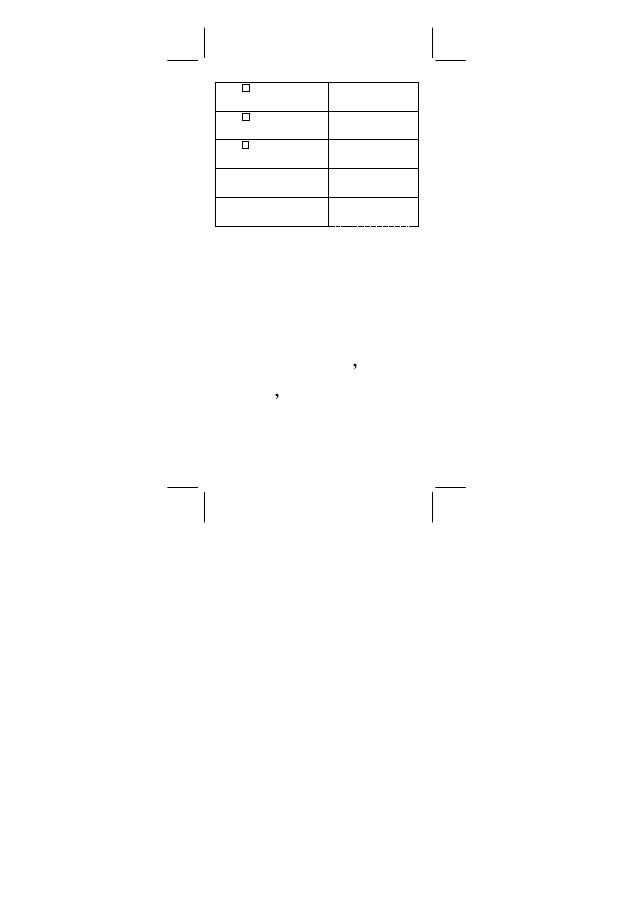
SR260B_SR-281N_Italian_v090330.doc SIZE:140x75mm SCALE 1:1
2009/3/31
-It 32-
DEG
STAT
a
[ 2nd ] [ a ]
1 7 6
.
1 0 6 3 2 9 1 1 4
REG
DEG
STAT
b
[ 2nd ] [ b ]
1 7
.
5 8 7 3 4 1 7 7 2 2
REG
DEG
STAT
r
[ 2nd ] [ r ]
0
.
9 8 9 8 4 5 1 6 4 1 3
REG
DEG
STAT
x
’
5 7 3
573 [ x
’
]
2 2
.
5 6 7 0 0 7 3 4 1 3
REG
DEG
STAT
y
’
1 9
19 [ y
’
]
5 1 0
.
2 6 5 8 2 2 7 8 5
REG
Cancellando dati
Il metodo per cancellare dato dipenderà se si ha memorizzato o non
memorizzato un dato con il tasto [ DATA ].
Per cancellare dato appena immesso ma non memorizzato con
[ DATA ],
basta premere [ CE ].
Per cancellare il dato che è stato memorizzato con [ DATA ] ,
(A) Per cancellare dato a variabile singola usando le seguenti
sintassi :
# < valore x > [ 2nd ] [ DEL ]
# < valore x > [ x ] < Numero di valori ripetuti > [ 2nd ] [ DEL ]
(B) Per cancellare variabili pari / regressione di dato usando le
seguenti sintassi :
# Gruppi di dati individuali : < valore x > [ ] < valore y > [ 2nd ]
[ DEL ]
# Gruppi di dati multipli con stesso valore
:
< valore x > [ ] < valore y > [ x ] < Numero di valori ripetuti >
[ 2nd ] [ DEL ]
Se immettere e cancellare per sbaglio il valore non incluso nei dati
memorizzati, " dEL Error " appare ma i dati precedenti sono mantenuti.

SR260B_SR-281N_Italian_v090330.doc SIZE:140x75mm SCALE 1:1
2009/3/31
-It 33-
Modifica di dati
Premere [ 2nd ] [ EDIT ] per immettere la modalità EDIT. La modalità
EDIT è conveniente e permette visualizzare, corregire, cancellare dati,
facilmente.
(A) Nella modalità 1–VAR, il metodo per visualizzare dati dipende se
si vuole o non visualizzare voci di dati.
# Ogni volta che si preme [ DATA ], la prima voce di dato appare
per 1 secondo e poi il valore corrispondente.
[ DATA ]
DEG
dAtA 1
STAT
EDIT
1 secondo
DEG
15.
STAT
EDIT
# Ogni volta che si preme [ = ], valore appare direttamente sul
schermo senza voce di dato.
[ = ]
DEG
15.
STAT
EDIT
(B) Nella modalità REG, ogni volta che si preme [ DATA ], voce di
dato e valore x appare sul schermo contemporaneamente. Si può
premere [ ] per scambiare tra il valore x e y .
[ DATA ]
DEG
DATA 1 = 15 , 45
STAT
15
EDIT
[ ]
DEG
DATA 1 = 15 , 45
STAT
451
EDIT
Se desidera corregir dato, ,trovare e digitare una nuova immissione
per sostituirlo.
Messaggio FULL
Il messaggio “ FULL” apparirà quando occorre una delle seguenti
condizioni impossibilitando immissione di dati ulteriore. Basta premere
qualunque tasto per eliminare indicatore. Le immissioni precedenti
sono mantenute a meno che esca dal modo STAT.
1) Se il numero di volte che si immette dato con [ DATA ] è più di 50
2) Il numero di valori ripetuti è più di 255
3) n
>
12750 (n = 12750 appare quando il numero di volte che si
immette dato con [ DATA ] è fino a 50 ed il numero di ripetuti per
ogni valore è 255, i.e. 12750 = 50 x 255 )
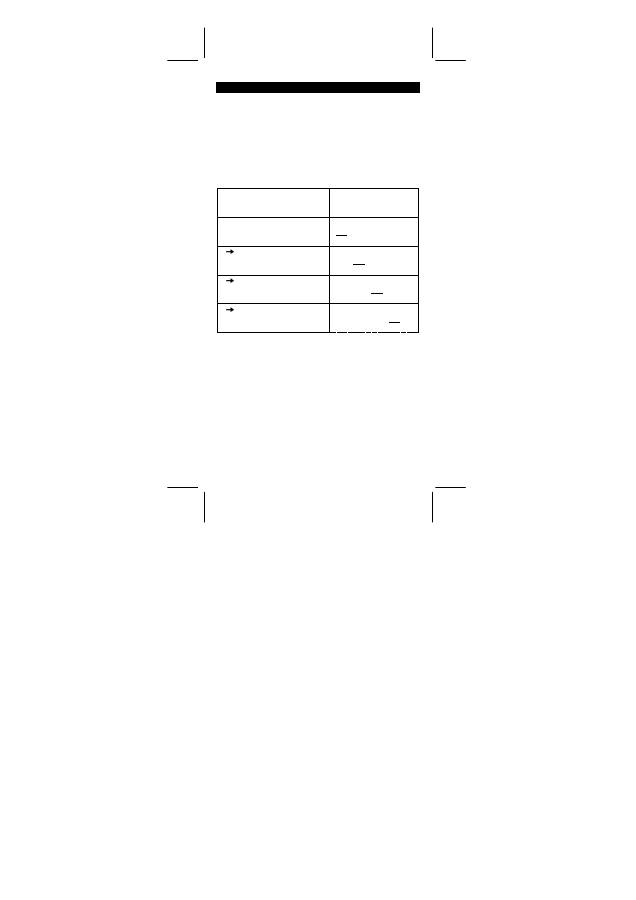
SR260B_SR-281N_Italian_v090330.doc SIZE:140x75mm SCALE 1:1
2009/3/31
-It 34-
Calcoli Complessi
Usare modalità CPLX ( [ MODE ] 3 ( CPLX ) ) per calcoli complessi .
La modalità complessa permette di aggiungere, sottrarre, moltiplicare
e dividere i numeri complessi.
I Risultati di un’operazione sono visualizzati come di seguito :
Re Valore Reale
Im Valore Immaginario
Ab Valore Assoluto
ar
Valore Argomento
¾
( 7 – 9 i ) + ( 15 + 12 i ) = 22 + 3 i , ab = 22.2036033112, ar =
7.76516601843
CPLX
DEG
[ MODE ] 3
0
.
CPLX
DEG
R e
I m
a b
a r
7 [ – ] 9 [ i ] [ + ] 15 [ + ] 12 [ i ] [ = ]
2 2
.
CPLX
DEG
R e
I m
a b
a r
[
]
3
.
i
CPLX
DEG
R e
I m
a b
a r
[
]
2 2
.
2 0 3 6 0 3 3 1 1 2
CPLX
DEG
R e
I m
a b
a r
[
]
7
.
7 6 5 1 6 6 0 1 8 4 3

SR260B_SR-281N_Dutch_v090331.doc SIZE: 140x75mm SCALE 1:1
2009/3/31
-D1-
Algemene inleiding ........................................................................... 2
Aan- en uitzetten .............................................................................. 2
De batterij vervangen ....................................................................... 2
Automatisch uitschakelen (Auto power-off) ...................................... 2
Het opnieuw instellen ....................................................................... 2
Het contrast bijregelen...................................................................... 3
Het beeldscherm .............................................................................. 3
Alvorens het uitvoeren van berekeningen ...................................... 4
De " MODE " toets gebruiken ........................................................... 4
De “2nd" toetsen gebruiken .............................................................. 4
Verbeteringen maken ....................................................................... 4
Ongedaan maken (Undo)................................................................. 5
De herhaalfunctie ............................................................................. 5
Berekeningen met het geheugen ..................................................... 5
Volgorde van de bewerkingen .......................................................... 7
Nauwkeurigheid en capaciteit........................................................... 7
Foutmeldingen.................................................................................. 9
Basisbewerkingen........................................................................... 10
Rekenkundige bewerkingen ........................................................... 10
Berekeningen met haakjes ............................................................. 10
Procentberekening ......................................................................... 11
Weergavenotaties........................................................................... 11
Wetenschappelijke berekeningen.................................................. 13
Logaritmes en antilogaritmes ......................................................... 13
Bewerkingen met breuken.............................................................. 13
Hoekconversies.............................................................................. 14
Sexagesimale
↔
decimale transformatie ....................................... 15
Trigonometrische / inverse trigonometrische functies..................... 15
Hyperbolische / inverse hyperbolische functies.............................. 16
Coördinaattransformatie ................................................................. 16
Waarschijnlijkheid........................................................................... 17
Andere functies ( 1/x,
,
3
,
X
, x
2
, x
3
, x
y
, INT, FRAC ).......... 18
Conversie van eenheden................................................................ 19
Constanten ..................................................................................... 19
Bewerkingen met getalbasissen (Base–n) .................................... 25
Grondtalconversies......................................................................... 26
Blokfunctie...................................................................................... 26
Rekenkundige basisbewerkingen in andere getalbasissen ............ 27
Negatieve uitdrukkingen ................................................................. 27
Logische functies............................................................................ 28
Statistische bewerkingen ............................................................... 28
Gegevens invoeren ........................................................................ 28
Resultaten weergeven.................................................................... 29
Gegevens verwijderen.................................................................... 32
Gegevens bewerken ...................................................................... 32
Het bericht "FULL".......................................................................... 33
Complexe bewerkingen .................................................................. 33
Inhoud

SR260B_SR-281N_Dutch_v090331.doc SIZE: 140x75mm SCALE 1:1
2009/3/31
-D2-
Algemene
inleiding
Aan- en uitzetten
Om de rekenmachine aan te zetten, drukt u op [ ON/C ]; Om de
rekenmachine uit te zetten, drukt u op [ 2nd ] [ OFF ].
De batterij vervangen
De rekenmachine gebruikt twee G13 (LR44) alkalische- batterijen. Als
het beeldscherm zwakker wordt en de gegevens moeilijk leesbaar
worden, moet u de batterijen vervangen. Let op dat u zichzelf niet
verwondt tijdens het vervangen van de batterij.
1. Draai de schroeven aan de achterkant van de rekenmachine los.
2. Plaats een platte schroevendraaier in de sleuf tussen de bovenste
en onderste behuizing en draai hem voorzichtig om de behuizing te
verwijderen.
3. Verwijder de oude batterijen en werp ze onmiddellijk weg. Hou de
batterijen buiten bereik van kinderen.
4. Veeg de nieuwe batterijen af met een droge en propere vod om een
goed contact te garanderen.
5. Plaats de nieuwe batterijen in het compartiment met de platte kant
(positieve kant) naar boven.
6. Plaats de bovenste en onderste behuizing terug.
7. Draai de schroeven vast.
Automatisch uitschakelen (Auto power-off)
Deze rekenmachine schakelt automatisch uit na ongeveer 6~9
minuten zonder activiteit. Zet de rekenmachine opnieuw aan door op
de toets [ ON/C ] te drukken. Het beeldscherm, het geheugen en de
instellingen worden onthouden en zullen niet beïnvloed worden
wanneer de rekenmachine automatisch uitschakelt.
Het opnieuw instellen
Wanneer de rekenmachine tijdens de werking niet reageert of
ongewone resultaten vertoont, drukt u op [ MODE ] [ 4 ] ( RESET ) Op
het beeldscherm zal nu een bericht verschijnen dat u vraagt of u al
dan niet de rekenmachine opnieuw wil instellen en de
geheugeninhoud wil wissen.
RESET : N Y
Gebruik de [ ] toets om de cursor naar " Y " te verplaatsen en druk
vervolgens op [ = ] om alle variabelen, programma’s, wachtende taken,
statistische gegevens, antwoorden, vorige invoer en geheugen te
wissen. Kies " N
" indien u het opnieuw instellen van de rekenmachine
wilt annuleren.
Wanneer de rekenmachine geblokkeerd is en niet op toetsaanslagen
reageert, gebruik dan een fijn, puntig voorwerp om de reset-knop, aan
de achterkant van de rekenmachine, in te drukken en deze situatie te

SR260B_SR-281N_Dutch_v090331.doc SIZE: 140x75mm SCALE 1:1
2009/3/31
-D3-
verhelpen. Deze handeling zal alle instellingen terugzetten naar de
standaardinstellingen.
Het contrast bijregelen
Druk op de [ MODE ] toets en druk vervolgens op [ – ] of [ + ] om het
contrast te verlagen of te verhogen. Hou één van beide toetsen
ingedrukt om het beeldscherm donkerder of lichter te maken.
Het beeldscherm
Het beeldscherm bestaat uit twee regels en verschillende indicatoren.
De bovenste regel kan maximaal 128 tekens weergeven. De onderste
regel kan resultaten weergeven met maximaal 12 cijfers en een
positieve of negatieve exponent van 2 cijfers.
Wanneer een bewerking ingegeven wordt en vervolgens uitgevoerd
wordt door op [ = ] te drukken, dan zal de bewerking op de bovenste
regel en het resultaat op de onderste regel weergegeven worden.
De volgende indicators verschijnen op het beeldscherm om de huidige
status van de rekenmachine aan te geven.
Indicator Betekenis
M
Het actieve geheugen
–
Het resultaat is een negatief getal
E Foutmelding
STO
De modus voor het opslaan van een variabele is actief
RCL
De modus voor het opvragen van een variabele is actief
2nd
De tweede functietoets is actief
HYP
De hyperbolische functie zal berekend worden
ENG
Technische (engineering) symboolnotatie
CPLX
De complexe getalbasis is actief
CONST
Er wordt een constante weergegeven
DEGRAD
Hoekmodus : DEGrees, GRADs, op RADs
BIN
De binaire getalbasis is actief
OCT
De octale getalbasis is actief
HEX
De hexadecimale getalbasis is actief
( )
Open parentheses
TAB
Het aantal decimalen dat getoond wordt staat vast
STAT
De statistische modus is actief
REG
Regressiemodus is actief
EDIT
Statistische gegevens worden bewerkt
CPK
CPK : Procesbegrenzing
CP : Begrenzingnauwkeurigheid
USL
Bovenste grenswaarde instellen
LSL
Onderste grenswaarde instellen
i Imaginair
gedeelte
U kunt de “ongedaan maken” functie gebruiken

SR260B_SR-281N_Dutch_v090331.doc SIZE: 140x75mm SCALE 1:1
2009/3/31
-D4-
Alvorens het uitvoeren van berekeningen
De " MODE " toets gebruiken
Druk op de [ MODE ] toets om: een menu weer te geven voor het
bepalen van de werkingsmodus ( " 1 MAIN ", " 2 STAT ", " 3 CPLX ",
" 4 RESET " ) of de technische (engineering) symboolnotatie ( " 5
ENG " ).
1 MAIN : Gebruik deze modus om algemene berekeningen,
inclusief wetenschappelijke en getalbasis berekeningen
uit te voeren.
2 STAT : Gebruik deze modus om statistische en
regressieberekeningen met één en twee variabelen uit
te voeren.
3 CPLX : Gebruik deze modus om berekeningen met complexe
getallen uit te voeren.
4 RESET : Gebruik deze modus om het opnieuw instellen (op nul
zetten) uit te voeren.
5 ENG : Gebruik deze modus om technische berekeningen uit te
voeren aan de hand van de technische symboolnotatie.
Laten we de modus " 2 STAT " als een voorbeeld nemen :
Methode 1 : Druk op [ MODE ] en schuif aan de hand van de [
]
of [ 2nd ] [
] toetsen door het menu totdat " 2 STAT "
onderlijnd is. Druk nu op de [ = ] toets om de modus te
selecteren.
Methode 2 : Druk op [ MODE ] en toets vervolgens het nummer van
de modus, in dit geval [ 2 ], in om rechtstreeks de
gewenste modus te selecteren.
De “2nd" toetsen gebruiken
Wanneer u op de [ 2nd ] toets drukt, zal de " 2nd " indicator op het
beeldscherm verschijnen om u te verwittigen dat u de tweede functie
gaat openen van de volgende toets die u indrukt. Indien u per ongeluk
op de [ 2nd ] toets drukt, druk dan nogmaals op de [ 2nd ] toets om de
" 2nd " indicator te laten verdwijnen.
Verbeteringen maken
Wanneer u tijdens het invoeren van een getal, een fout maakte
(alvorens op een rekenkundige bewerkingstoets te drukken), drukt u
gewoon op [ CE ] om de laatste invoer te wissen, drukt u op de
backspace [ ] toets om de invoer cijfer per cijfer te verwijderen of
drukt u op [ ON/C ] om alle invoer te wissen.
Wanneer u de fout verbeterd heeft en de volledige formule ingevoerd
heeft, kunt u het resultaat verkrijgen door op [ = ] te drukken. U kunt
ook op [ ON/C ] drukken om de onmiddellijke resultaten volledig te
wissen (met uitzondering van het geheugen). Indien u op de foute
rekenkundige bewerkingstoets gedrukt heeft, druk dan gewoon op de
juiste toets om de foute te vervangen.

SR260B_SR-281N_Dutch_v090331.doc SIZE: 140x75mm SCALE 1:1
2009/3/31
-D5-
Ongedaan maken (Undo)
De rekenmachine is voorzien van een Ongedaan maken functie, die u
toelaat om zopas gemaakte fouten ongedaan te maken.
Wanneer u zopas een teken aan de hand van [ ] verwijderd hebt of
een invoer gewist hebt aan de hand van [ CE ] of [ ON/C ], zal de
indicator "
" op het beeldscherm verschijnen om u te informeren
dat u op [ 2nd ] [
] kunt drukken om de bewerking ongedaan te
maken.
De herhaalfunctie
De herhaalfunctie (Replay) slaat zopas uitgevoerde bewerkingen op.
Nadat de bewerking is uitgevoerd kunt u op de [ ] of [ 2nd ] [
]
toets drukken om de uitgevoerde bewerking uit te voeren. Druk op
[
] om de bewerking vanaf het begin weer te geven; de cursor
bevindt zich onder het eerste teken. Druk op [ 2nd ] [
] om de
bewerking vanaf het einde weer te geven; de cursor bevindt zich
achter het laatste teken. U kunt de cursor verder verplaatsen aan de
hand van [ ] of [ 2nd ] [
] en waarden of opdrachten bewerken
voor volgende uitvoering.
Berekeningen met het geheugen
Geheugenvariabele
De rekenmachine heeft negen geheugenvariabelen voor herhaaldelijk
gebruik -- A, B, C, D, E, F, M, X, Y. U kunt een werkelijk getal in de
één van de negen variabelen opslaan.
•
[ STO ] + [ A ] ~ [ F ], [ M ], [ X ] ~ [ Y ] slaat de waarden op in de
variabelen.
•
[ RCL ] + [ A ] ~ [ F ], [ M ], [ X ] ~ [ Y ] vraagt de waarde van de
variabele op.
•
[ 0 ] [ STO ] + [ A ] ~ [ F ], [ M ], [ X ] ~ [ Y ] wist de inhoud van een
bepaalde geheugenvariabele .
¾
(1) Sla 30 op in de variabele A
DEG
3 0
Æ
A
30 [ STO ] [ A ]
3 0
.
¾
(2) Vermenigvuldig 5 met de variabele A en sla het resultaat in de
variabele B op.
DEG
5
¼
A =
5 [ x ] [ RCL ] [ A ] [ = ]
1 5 0
.
DEG
1 5 0
Æ
B
[ STO ] [ B ]
1 5 0 .
¾
(3) Verwijder de waarde die in variabele B opgeslagen is.
DEG
0
Æ
B
0 [ STO ] [ B ]
0
.
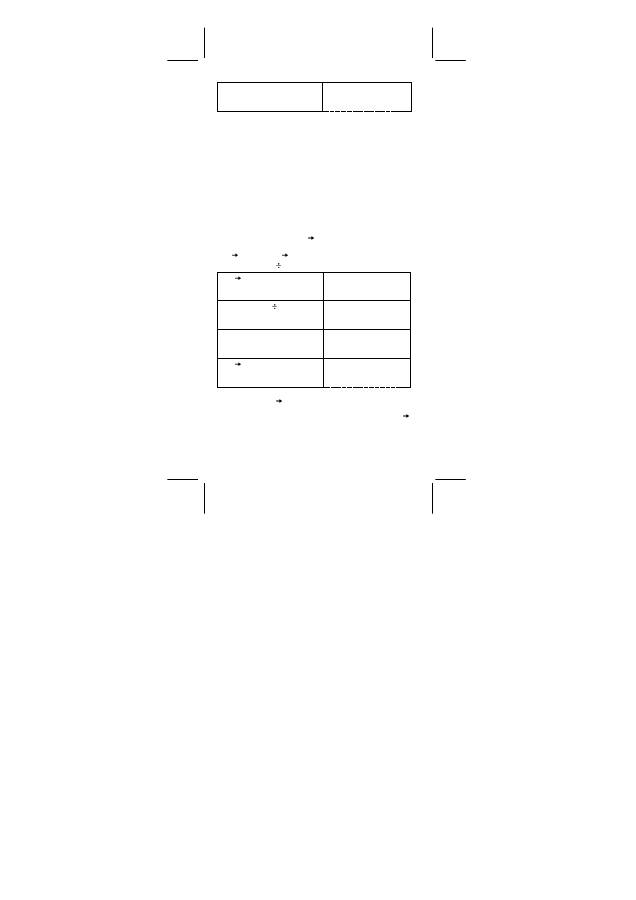
SR260B_SR-281N_Dutch_v090331.doc SIZE: 140x75mm SCALE 1:1
2009/3/31
-D6-
DEG
B =
[ RCL ] [ B ] [ = ]
0
.
Het actief geheugen
U moet de volgende regels in acht nemen wanneer u het actief
geheugen gebruikt.
• Druk op [ M+ ] om een resultaat aan het actief geheugen toe te
voegen en de " M " indicator verschijnt op het scherm wanneer een
getal in het geheugen opgeslagen is. Druk op [ MR ] om de inhoud
van het actief geheugen op te vragen.
• Het opvragen van de inhoud van het actief geheugen door op de
toets [ MR ] te drukken, zal de inhoud van het actief geheugen niet
beïnvloeden.
• Het actief geheugen is niet beschikbaar in de statistische modus.
• De geheugenvariabele M en het actief geheugen gebruiken
hetzelfde geheugengebied.
• Om de inhoud van het geheugen met het weergegeven getal te
verwisselen, moet u op de [ X M ] toets drukken.
• Om de inhoud van het actief geheugen te wissen, kunt u op [ 0 ]
[ X M ], [ ON/C ] [ X M ] of [ 0 ] [ STO ] [ M ] drukken.
¾
[ ( 3 x 5 ) + ( 56 7 ) + ( 74 – 8 x 7 ) ] = 41
DEG
0 [ X M ]
0
.
DEG
7 4 – 8
¼
7 M +
3 [ x ] 5 [ M+ ] 56 [ ] 7 [ M+ ] 74
[ – ] 8 [ x ] 7 [ M+ ]
M
1 8
.
DEG
M
[ MR ]
M
4 1
.
DEG
0 [ X M ]
0
.
(Opmerking) : U kunt niet alleen waarden opslaan door op de [ STO ]
of [ X M ] toets te drukken, maar u kunt ook waarden
toewijzen aan de geheugenvariabele M door op [ M+ ]
te drukken. Wanneer u echter [ STO ] [ M ] of [ X M ]
gebruikt, zal de vorige geheugeninhoud die in de
variabele M opgeslagen is, verwijderd en vervangen
worden door de nieuwe toegewezen waarde. Wanneer
u [ M+ ] gebruikt, worden de waarden toegevoegd tot
het actuele somgeheugen.
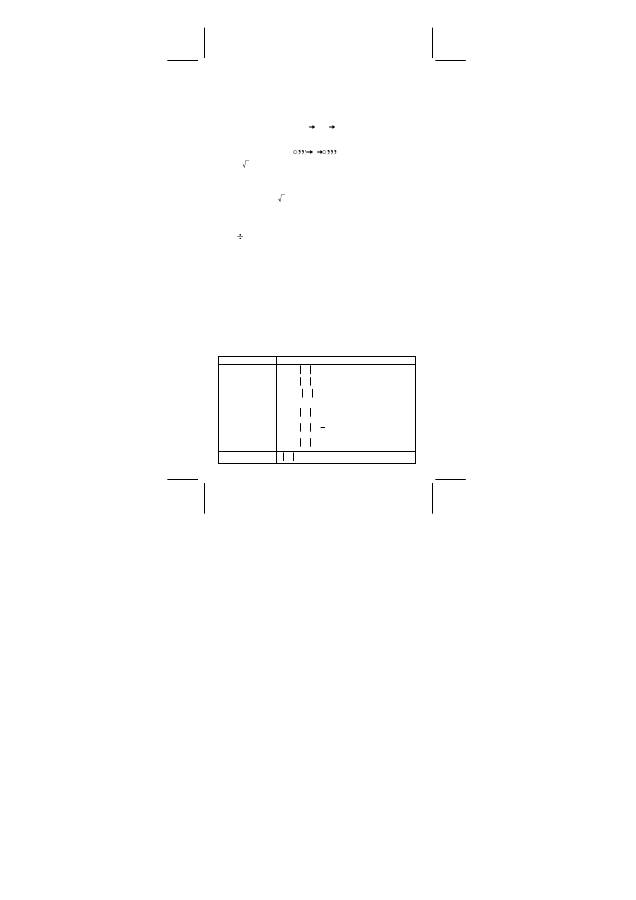
SR260B_SR-281N_Dutch_v090331.doc SIZE: 140x75mm SCALE 1:1
2009/3/31
-D7-
Volgorde van de bewerkingen
Elke berekening wordt uitgevoerd in de volgende prioriteitsvolgorde:
1) Breuken
2) Uitdrukking tussen haakjes.
3) Coördinaattransformatie ( P R , R P )
4) Functies van het type A die het invoeren van waarden vereisen
alvorens u op de functietoets kunt drukken, bijvoorbeeld: x
2
,1/x,
π
, x!, %, RND, ENG,
,
, x ' en y '.
5) x
y
,
X
6) Functies van het type B die het indrukken van de functietoets
vereisen alvorens het invoeren, bijvoorbeeld:sin, cos, tan, sin
–1
,
cos
–1
, tan
–1
, sinh, cosh, tanh, sinh
–1
, cosh
–1
, tanh
–1
, log, ln,
FRAC, INT,
√
,
3
, 10
X
, e
X
, NOT, EXP en DATA in de STAT
modus.
7) +/–,
NEG
8) nPr, nCr
9) x
,
10) +, –
11) AND, NAND –-- enkel in de getalbasis modus (Base–n)
12) OR, XOR, XNOR --- enkel in de getalbasis modus (Base–n)
Nauwkeurigheid en capaciteit
Uitvoer: tot 10 cijfers
Berekening: tot 14 cijfers
In het algemeen wordt elke logische berekening weergegeven door
een mantisse (het getal dat voor de exponent staat) met maximum 12
cijfers of een mantisse met 12 cijfers, plus een exponent met 2 cijfers
tot 10
± 99
.
De ingevoerde getallen moeten zich bevinden in het bereik van de
onderstaande functies:
Functies Invoerbereik
sin x
cos x
tan x
Deg :
x
<
4.5 x 10
10
deg
Rad :
x
<
2.5 x 10
8
π
rad
Grad :
x
<
5 x 10
10
grad
Voor tan x is dit echter:
Deg :
x
≠
90 (2n+1)
Rad :
x
≠
2
π
(2n+1)
Grad :
x
≠
100 (2n+1), (n is een geheel getal)
sin
–1
x, cos
–1
x
x
≦
1
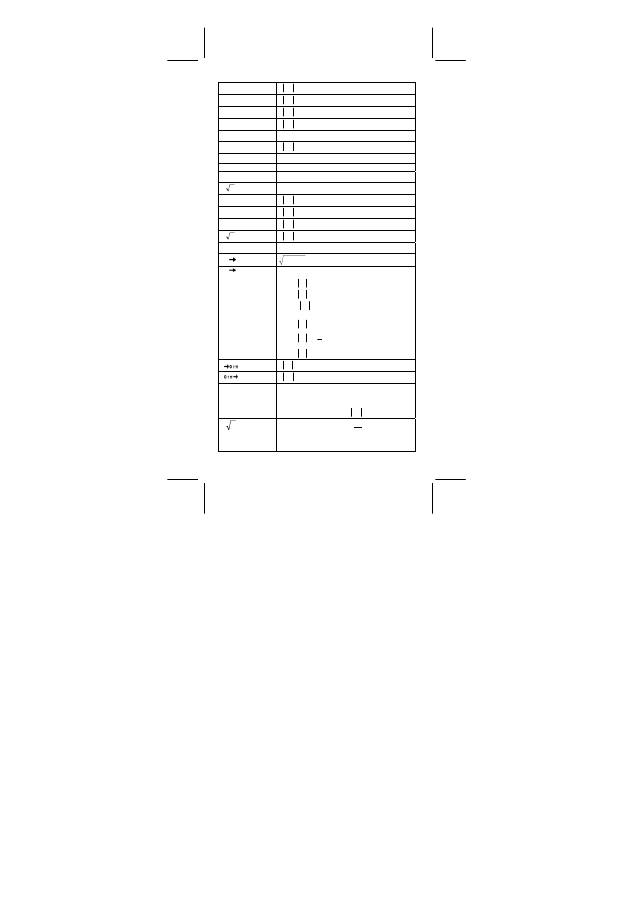
SR260B_SR-281N_Dutch_v090331.doc SIZE: 140x75mm SCALE 1:1
2009/3/31
-D8-
tan
–1
x
x
<
1 x 10
100
sinh x, cosh x
x
≦
230.2585092
tanh x
x
<
1 x 10
100
sinh
–1
x
x
<
5 x 10
99
cosh
–1
x
1
≦
x
<
5 x 10
99
tanh
–1
x
x
<
1
log x, ln x
1 x 10
–99
≦
x
<
1 x 10
100
10
x
–1 x 10
100
<
x
<
100
e
x
–1 x 10
100
<
x
≦
230.2585092
x
0
≦
x
<
1 x 10
100
x
2
x
<
1 x 10
50
x
3
x
<
2.15443469003 x 10
33
1/x
x
<
1 x 10
100
, x
≠
0
3
x
x
<
1 x 10
100
x !
0
≦
x
≦
69, x is een geheel getal.
R P
2
2
y
+
x
<
1 x 10
100
P R
0
≦
r
<
1 x 10
100
Deg
:
θ
<
4.5 x 10
10
deg
Rad
:
θ
<
2.5 x 10
8
π
rad
Grad
:
θ
<
5 x 10
10
grad
Voor tan x is dit echter:
Deg
:
θ
≠
90 (2n+1)
Rad
:
θ
≠
2
π
(2n+1)
Grad :
θ
≠
100 (2n+1), (n is een geheel getal)
D
, M, S
<
1 x 10
100
, 0
≦
M, S
x
<
1 x 10
100
x
y
x
>
0 : –1 x 10
100
<
y log x
<
100
x = 0 : y
>
0
x
<
0 : y = n, 1/(2n+1), n is een geheel getal.
Maar: –1 x 10
100
<
y log
x
<
100
x
y
y
>
0 : x
≠
0, –1 x 10
100
<
x
1
log y
<
100
y = 0 : x
>
0
y
<
0 : x=2n+1, l/n, n is een geheel getal.(n
≠
0)
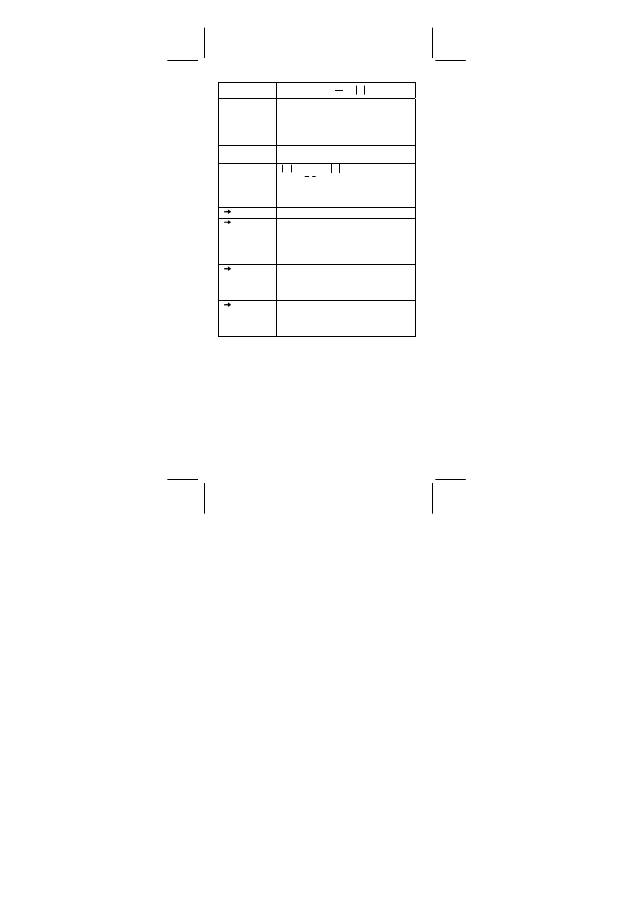
SR260B_SR-281N_Dutch_v090331.doc SIZE: 140x75mm SCALE 1:1
2009/3/31
-D9-
Maar: –1 x 10
100
<
x
1
log
y
<
100
a b/c
Invoer
:
Het aantal cijfers van het geheel
getal, teller en noemer mag niet meer dan 12
zijn (scheidingsteken inbegrepen)
Resultaat
:
Het resultaat wordt weergegeven
als een breuk, wanneer het geheel getal, de
teller en de noemer kleiner zijn dan 1 x 10
12
nPr, nCr
0
≦
r
≦
n, n
≦
10
100
, n en r zijn gehele
getallen.
STAT
x
<
1 x 10
50
,
y
<
1 x 10
50
σ
x,
σ
y,
x
, y ,a, b, r : n
≠
0 ;
Sx, Sy
:
n
≠
0, 1 ; x
n
= 50 ; y
n
= 50 ;
Aantal herhalingen
≤
255, n is een geheel
getal.
DEC
– 2147483648
≦
x
≦
2147483647
BIN
0
≦
x
≦
01111111111111111111111111111111
(voor nul of positieve getallen)
10000000000000000000000000000000
≦
x
≦
11111111111111111111111111111111
(voor negatieve getallen)
OCT
0
≦
x
≦
17777777777 (voor nul of positieve
getallen)
20000000000
≦
x
≦
37777777777
(voor negatieve getallen)
HEX
0
≦
x
≦
7FFFFFFF (voor nul of positieve
getallen)
80000000
≦
x
≦
FFFFFFFF (voor negatieve
getallen)
Foutmeldingen
Een foutmelding “
E
” zal op het beeldscherm verschijnen en verdere
berekeningen zullen onmogelijk worden wanneer er zich één van de
onderstaande situaties voordoet.
1) U hebt geprobeerd een deling door 0 uit te voeren.
2) Wanneer het invoerbereik van de functieberekeningen het
opgegeven bereik overschrijdt.
3) Wanneer het resultaat van de functieberekeningen het
opgegeven bereik overschrijdt.
4) Wanneer de[ ( ] toets in meer dan 13 niveaus in een enkele
uitdrukking gebruikt wordt.
5) Wanneer de waarde van USL
<
waarde van LSL.
Druk op de [ ON/C ] toets om de bovenstaande foutmeldingen te
wissen.

SR260B_SR-281N_Dutch_v090331.doc SIZE: 140x75mm SCALE 1:1
2009/3/31
-D10-
Basisbewerkingen
Gebruik de MAIN ( [ MODE ] 1 ( MAIN ) ) modus voor
basisbewerkingen.
Rekenkundige bewerkingen
Rekenkundige bewerkingen worden uitgevoerd door de toetsen in te
drukken in dezelfde volgorde als de uitdrukking.
¾
7 + 5 x 4 = 27
DEG
7 + 5
¼
4 =
7 [ + ] 5 [ x ] 4 [ = ]
2 7
.
Voor negatieve waarden, drukt u na het invoeren van de waarde op
[ +/– ]; U kunt een getal in mantisse en de exponentiële vorm invoeren
aan de hand van de [ EXP ] toets.
¾
2.75 x 10
– 5
= 0.0000275
DEG
2
.
7 5 E – 0 5 =
2.75 [ EXP ] 5 [ +/– ] [ = ]
0
.
0 0 0 0 2
7 5
Resultaten die groter zijn dan 10
12
of kleiner zijn dan 10
-11
worden
weergegeven in de exponentiële vorm.
¾
12369 x 7532 x 74010 = 6895016425080
= 6.89501642508 x 10
12
DEG
1 2 3 6 9
¼
7 5 3 2
¼
7
12369 [ x ] 7532 [ x ] 74010
[=]
6
.
8 9 5 0 1 6 4 2 5 0 8
12
Berekeningen met haakjes
Bewerkingen binnen de haakjes worden altijd eerst uitgevoerd. De
SR-281N
kan 13 niveaus van opeenvolgende haakjes in een enkele
berekening verwerken.
Gesloten haakjes die zich onmiddellijk voor de bewerking van de [ ) ]
toets bevinden, kunnen weggelaten worden, ongeacht hoeveel er
vereist zijn.
¾
2 x { 7 + 6 x ( 5 + 4 ) } = 122
DEG
2
¼
( 7 + 6
¼
( 5 + 4 =
2 [ ( ] 7 [ + ] 6 [ ( ] 5 [ + ] 4 [ = ]
1 2 2
.
(Opmerking) : Een vermenigvuldigingsteken "
x
" dat zich onmiddellijk
voor een open haakje bevindt kan weggelaten worden.
Het correcte resultaat kan niet afgeleid worden door [ ( ] 2 [ + ] 3 [ ) ]
[ EXP ] 2 in te voeren. U moet [ x ] invoeren tussen [ ) ] en [ EXP ] in
het onderstaande voorbeeld.
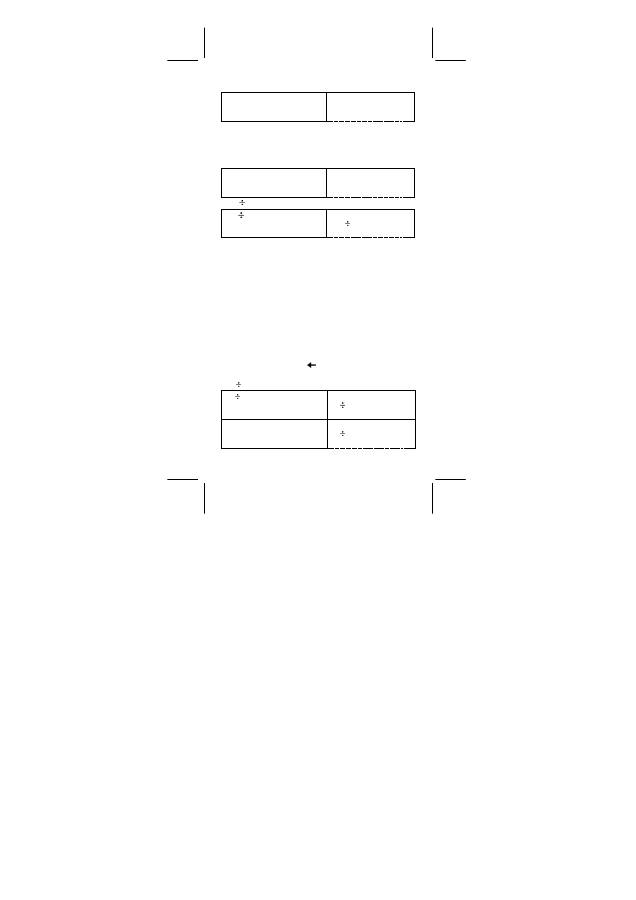
SR260B_SR-281N_Dutch_v090331.doc SIZE: 140x75mm SCALE 1:1
2009/3/31
-D11-
¾
( 2 + 3 ) x 10
2
= 500
DEG
( 2 + 3 )
¼
1 E 0 2 =
[ ( ] 2 [ + ] 3 [ ) ] [ x ] [ EXP ] 2
[ = ]
5
0 0
.
Procentberekening
Druk op [ 2nd ] [ % ] om het getal op het beeldscherm te delen door
100. Gebruik deze knop om percentages, intresten, kortingen en
percentageverhoudingen te berekenen.
¾
120 x 30 % = 36
DEG
1 2 0
¼
3 0 % =
120 [ x ] 30 [ 2nd ] [ % ] [ = ]
3 6
.
¾
88 55 % = 160
DEG
8 8
5 5 % =
88 [ ] 55 [ 2nd ] [ % ] [ = ]
1 6 0
.
Weergavenotaties
De rekenmachine heeft de volgende weergavenotaties voor het
weergeven van de waarden.
Vaste komma / Drijvende komma notatie
Om het aantal decimale plaatsen in te stellen, drukt u op [ 2nd ] [ TAB ]
en toetst u een waarde in voor het aantal decimale plaatsen ( 0~9 ).
De waarden worden afgerond op het ingestelde aantal decimale
plaatsen. Om terug te gaan naar de drijvende komma notatie, drukt u
op [ 2nd ] [ TAB ] [ • ].
Wetenschappelijke notatie
Om de weergavemodus te veranderen van drijvende komma notatie
naar wetenschappelijke notatie, drukt u op [ F
↔
E ].
Technische (Engineering) notatie
Door op [ ENG ] of [ 2nd ] [ ] te drukken zal het weergegeven
exponentgedeelte steeds een veelvoud van drie zijn.
¾
6 7 = 0.85714285714…
DEG
6
7 =
6 [ ] 7 [ = ]
0
.
8 5 7 1 4 2 8 5 7 1 4
DEG TAB
6
7 =
[ 2nd ] [ TAB ] 4
0 . 8 5 7 1
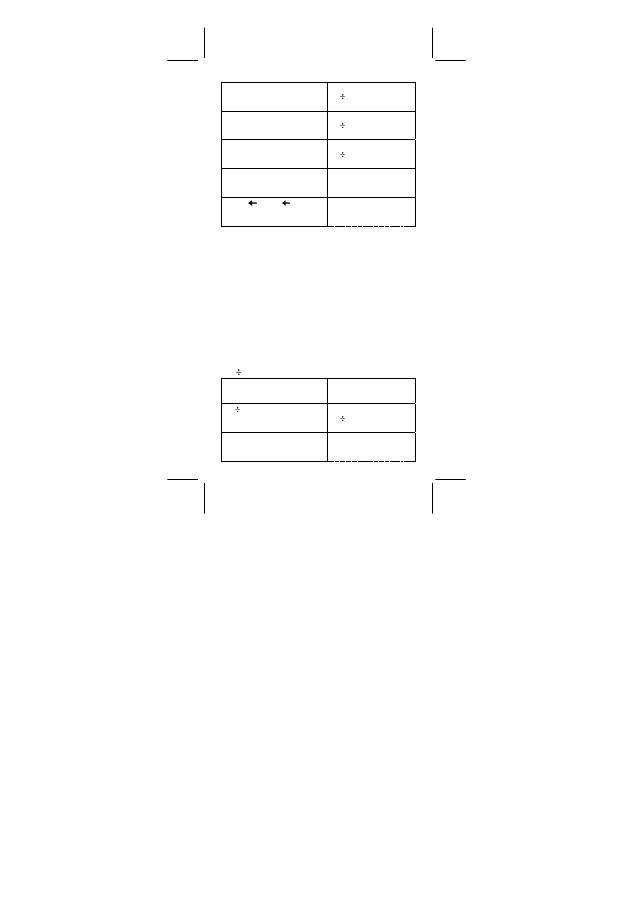
SR260B_SR-281N_Dutch_v090331.doc SIZE: 140x75mm SCALE 1:1
2009/3/31
-D12-
DEG TAB
6
7 =
[ 2nd ] [ TAB ] 2
0
.
8 6
DEG
6
7 =
[ 2nd ] [ TAB ] [ • ]
0
.
8 5 7 1 4 2 8 5 7 1 4
DEG
6
7 =
[ F
↔
E ]
8
.
5 7 1 4 2 8 5 7 1 4 3
–01
DEG
[ ENG ]
8 5 7
.
1 4 2 8 5 7 1 4 3
–03
DEG
[ 2nd ] [
] [ 2nd ] [
]
0
.
0 0 0 8 5 7 1 4 2 8 5
03
Technisch symbool notatie
Elke keer dat u de ENG modus selecteert, zal een resultaat
automatisch weergegeven worden met zijn overeenkomstig technisch
symbool.
Y
yotta
= 10
24
,
Z
zetta
= 10
21
,
E
exa
= 10
18
,
P
peta
= 10
15
,
T
tera
= 10
12
,
G
giga
= 10
9
,
M
mega
= 10
6
,
K
kilo
= 10
3
,
m
milli
= 10
– 3
,
μ
micro
= 10
– 6
,
n
nano
= 10
– 9
,
p
pico
= 10
– 12
,
f
femto
= 10
– 15
,
a
atto
= 10
– 18
,
z
zepto
= 10
– 21
,
y
yocto
= 10
– 24
Voer de volgende bewerking uit om het resultaat in de technisch
symbool notatie weer te geven.
[ MODE ] 5 ( ENG )
Om deze modus af te sluiten, drukt u nogmaals op [ MODE ] 5.
¾
6 7 = 0.85714285714…
ENG
DEG
[ MODE ] 5
0
.
ENG
DEG
6
7 =
m
6 [ ] 7 [ = ]
8
5
7
.
1 4 2 8 5 7 1
4 3
ENG
DEG
μ
[ ENG ]
8 5 7 1 4 2
.
8 5 7 1 4 3

SR260B_SR-281N_Dutch_v090331.doc SIZE: 140x75mm SCALE 1:1
2009/3/31
-D13-
ENG
DEG
K
[ 2nd ] [
] [ 2nd ] [
] [ 2nd ] [
]
0
.
0 0 0 8 5 7 1 4 2 8 5
Wetenschappelijke
berekeningen
Gebruik de MAIN ( [ MODE ] 1 ( MAIN ) ) modus voor
wetenschappelijke berekeningen.
Logaritmes en antilogaritmes
De rekenmachine kan algemene en natuurlijke logaritmes en
antilogaritmes berekenen aan de hand van de toetsen [ log ], [ ln ],
[ 2nd ] [ 10
x
], en [ 2nd ] [ e
x
].
¾
ln 7 + log 100 = 3.94591014906
DEG
l n 7 + l o g 1 0 0 =
[ ln ] 7 [ + ] [ log ] 100 [ = ]
3
.
9 4 5 9 1 0 1 4 9 0 6
¾
10
2
+ e
–5
= 100.006737947
DEG
10
^ 2 + e ^ – 5 =
[ 2nd ] [ 10
X
] 2 [ + ] [ 2nd ] [ e
X
] 5
[ + / – ] [ = ]
1 0 0
.
0 0 6 7 3 7 9 4 7
Bewerkingen met breuken
Breuken worden als volgt op het beeldscherm voorgesteld:
5
」
12
Weergave van
12
5
56
∪
5
」
12
Weergave van
56
12
5
(Opmerking) : Waarden worden automatisch in de decimale vorm
weergegeven wanneer het totaal aantal cijfers van een
breukwaarde ( geheel getal + teller + noemer +
scheidingsteken) 12 overschrijdt
Om een gemengd getal in te voeren, toetst u het geheel getal in, drukt
u op [ a b/c ], toetst u de teller in, drukt u op [ a b/c ], en toetst u de
noemer in; Om een breuk in te voeren, toetst u de teller in, drukt u op
[ a b/c ], en toets u de noemer in.
¾
21
8
22
7
5
14
3
2
7
=
+
DEG
7
2
3
+ 1 4
5
7
7 [ a b/c ] 2 [ a b/c ] 3 [ + ] 14 [ a b/c ]
5 [ a b/c ] 7 [ = ]
2 2
8
2 1
.
Wanneer u tijdens een bewerking met een breuk op een
functieopdracht toets, zoals: ( [ + ], [ – ], [ x ] of [ ] ) of de [ = ] toets
drukt, zal de breuk zoveel mogelijk vereenvoudigd worden. Door op
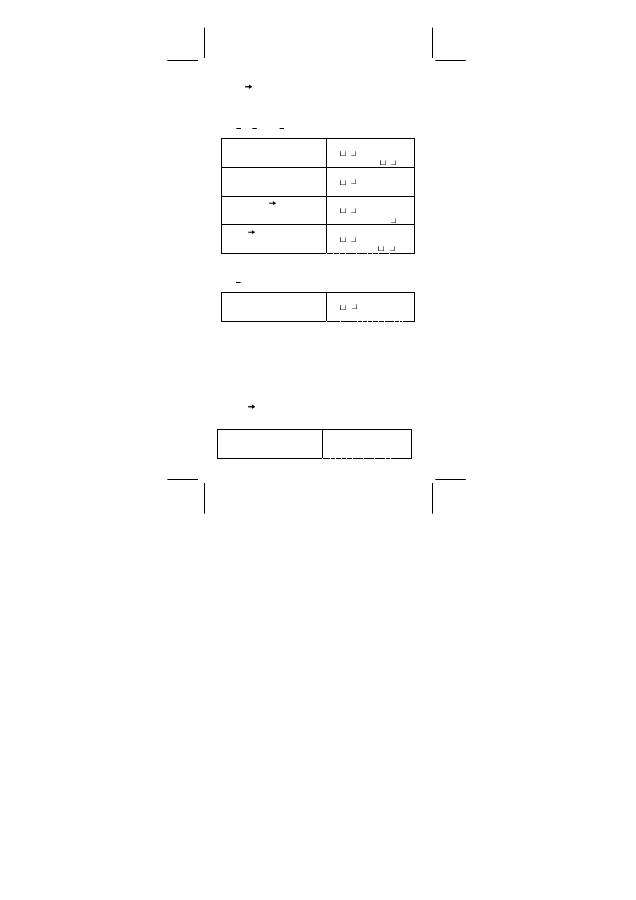
SR260B_SR-281N_Dutch_v090331.doc SIZE: 140x75mm SCALE 1:1
2009/3/31
-D14-
[ 2nd ] [ d/e ] te drukken kunt u overschakelen tussen de meest
nauwkeurige waarde en eenvoudigste waarde. Om de weergave van
het resultaat over te schakelen tussen een decimaal en een breuk,
drukt u op [ a b/c ].
¾
2
9
5
.
4
2
1
4
4
2
4
=
=
=
DEG
4
2
4
=
4 [ a b/c ] 2 [ a b/c ] 4 [ = ]
4
1
2
.
DEG
4
2
4
=
[ a b/c ]
4
.
5
DEG
4
2
4
=
[ a b/c ] [ 2nd ] [ d/e ]
9
2
.
DEG
4
2
4
=
[ 2nd ] [ d/e ]
4
1
2
.
Berekeningen die zowel breuken als decimale getallen bevatten
worden berekend in decimaal formaat.
¾
55
.
12
75
.
3
5
4
8
=
+
DEG
8
4
5
+ 3
.
7 5 =
8 [ a b/c ] 4 [ a b/c ] 5 [ + ] 3.75
[ = ]
1 2
.
5 5
Hoekconversies
Met de rekenmachine kunt u converteren tussen de volgende
hoekeenheden: graden (DEG), radialen (RAD), en grads (GRAD).
De verhouding tussen de drie hoekeenheden is:
180
°
=
π
rad = 200 grad
1) Om de standaardinstelling te veranderen naar een andere
instelling, drukt u herhaaldelijk op [ 2nd ] [ DRG ] totdat de
gewenste hoekeenheid op het beeldscherm weergegeven wordt.
2) Na het invoeren van een waarde, drukt u herhaaldelijk op [ 2nd ]
[ DRG ] totdat de gewenste hoekeenheid op het beeldscherm
weergegeven wordt.
¾
90 deg. = 1.57079632679 rad. = 100 grad.
DEG
[ 2nd ] [ DRG ]
0
.

SR260B_SR-281N_Dutch_v090331.doc SIZE: 140x75mm SCALE 1:1
2009/3/31
-D15-
RAD
9 0
O
=
90 [ 2nd ] [ DRG ]
1 .
5 7 0 7 9 6 3 2 6 7 9
GRAD
1
.
5 7 0 7 9 6 3 2 6 7
[ 2nd ] [ DRG ]
1 0 0
.
Sexagesimale
↔
decimale transformatie
Met deze rekenmachine kunt u de sexagesimale notatie (graden,
minuten en seconden) naar een de decimale notatie converteren door
op [
] te drukken. U kunt de decimale notatie naar de
sexagesimale notatie converteren door op [ 2nd ] [
] te drukken.
De sexagesimale waarde wordt als volgt weergegeven:
125
45
׀
30
׀
׀
55
Stelt 125 graden (D),
45 minuten (M) en 30.55 seconden
(S) voor.
(Opmerking)
: Het totaal aantal cijfers van D, M, S en de
scheidingstekens mag niet meer dan 12 zijn of anders
wordt de sexagesimale waarde niet volledig
weergegeven.
¾
12.755 = 12
45
l
18
l l
DEG
12.755 [ 2nd ] [
]
1 2
4 5
l
1 8
l l
¾
2
45
l
10.5
l l
= 2.75291666667
DEG
2 [
] 45 [
] 10.5 [
]
2
.
7 5 2 9 1 6 6 6 6 6 7
Trigonometrische / inverse trigonometrische
functies
De
SR-281N
is voorzien van de standaard trigonometrische functies
en inverse trigonometrische functies - sin, cos, tan, sin
–1
, cos
–1
en
tan
–1
.
(Opmerking) : Wanneer u deze toetsen gebruikt, moet u ervoor
zorgen dat de rekenmachine ingesteld staat op de
gewenste hoekeenheid.
¾
sin 30 deg.= 0.5
DEG
s i n 3 0 =
[ sin ] 30 [ = ]
0
.
5

SR260B_SR-281N_Dutch_v090331.doc SIZE: 140x75mm SCALE 1:1
2009/3/31
-D16-
¾
3 cos (
π
3
2
rad) = – 1.5
RAD
3
¼
c o s ( 2
¼
π
3 =
3 [ cos ] [ ( ] 2 [ x ] [ 2nd ] [
π
] [ ]
3 [ = ]
– 1
.
5
¾
3 sin
–1
0.5 = 90 deg
DEG
3
¼
s i n
–1
0
.
5 =
3 [ 2nd ] [ sin
–1
] 0.5 [ = ]
9 0
.
Hyperbolische / inverse hyperbolische functies
De
SR-281N
gebruikt [ 2nd ] [ HYP ] om de hyperbolische en inverse
hyperbolische functies - sinh, cosh, tanh, sinh
–1
, cosh
–1
en tanh
–1
te
berekenen.
(Opmerking) : Wanneer u deze toetsen gebruikt, moet u ervoor
zorgen dat de rekenmachine ingesteld staat op de
gewenste hoekeenheid.
¾
cosh 1.5 + 2 = 4.35240961524
DEG
c o s h 1
.
5 + 2 =
[ 2nd ] [ HYP ] [ cos ] 1.5 [ + ] 2 [ = ]
4
.
3 5 2 4 0 9 6 1 5 2 4
¾
sinh
–1
7 = 2.64412076106
DEG
s i n h 1
–1
7 =
[ 2nd ] [ HYP ] [ 2nd ] [ sin
–1
] 7 [ = ]
2
.
6 4 4 1 2 0 7 6 1 0 6
Coördinaattransformatie
Rechthoekige coördinaten Polaire coördinaten
x + y i = r (cos
θ
+ i sin
θ
)
(Opmerking) : Wanneer u deze toetsen gebruikt, moet u ervoor
zorgen dat de rekenmachine ingesteld staat op de
gewenste hoekeenheid.
Deze rekenmachine kan de conversie uitvoeren van rechthoekige
coördinaten naar polaire coördinaten of omgekeerd door op [ 2nd ]
[ P R ] en [ 2nd ] [ R P ] te drukken.
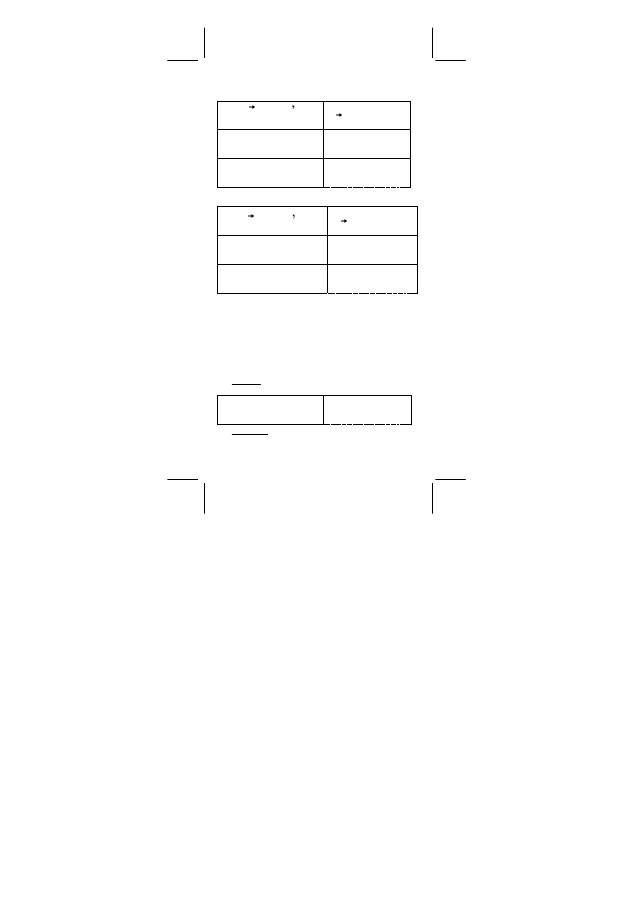
SR260B_SR-281N_Dutch_v090331.doc SIZE: 140x75mm SCALE 1:1
2009/3/31
-D17-
¾
Indien x = 5 en y = 30, hoeveel is dan r en
θ
? Antwoord: r =
30.4138126515,
θ
= 80.537677792
o
DEG
(
)
R
P ( 5
,
[ 2nd ]
[ R P ] 5 [ 2nd ] [ ] 30
3 0
DEG
r
[ = ]
3 0
.
4 1 3 8 1 2 6 5 1 5
DEG
θ
[ 2nd ] [ X
↔
Y ]
8 0
.
5 3 7 6 7 7 7 9 2
¾
Indien r = 25 en
θ
= 56
o
Hoeveel is dan x en y ? Antwoord : x =
13.9798225868, y = 20.7259393139
DEG
( )
P
R ( 2 5
,
[ 2nd ] [ P R ] 25 [ 2nd ] [ ] 56
5 6
DEG
X
[ = ]
1 3
.
9 7 9 8 2 2 5 8 6 8
DEG
Y
[ 2nd ] [ X
↔
Y ]
2 0
.
7 2 5 9 3 9 3 1 3 9
Waarschijnlijkheid
Deze rekenmachine is voorzien van de volgende
waarschijnlijkheidsfuncties:
[ nPr ] Berekent het aantal mogelijke permutaties van r uit n
objecten.
[ nCr ] Berekent het aantal mogelijke combinaties van r uit n
objecten.
[ x ! ]
Berekent de faculteit van een opgegeven positief geheel
getal n , waarbij n
≦
69.
[ RND ] Genereert een willekeurig getal tussen 0.000 en 0.999.
¾
840
!
]
)
4
7
(
[
!
7
=
−
DEG
7 P 4 =
7 [ 2nd ] [ nPr ] 4 [ = ]
8 4 0
.
¾
5
3
!
]
)
4
7
(
[
!
4
!
7
=
−

SR260B_SR-281N_Dutch_v090331.doc SIZE: 140x75mm SCALE 1:1
2009/3/31
-D18-
DEG
7 C 4 =
7 [ 2nd ] [ nCr ] 4 [ = ]
3 5
.
¾
5 ! = 120
DEG
5 ! =
5 [ 2nd ] [ X ! ] [ = ]
1 2 0
.
¾
Genereert een willekeurig getal tussen 0.000 en 0.999.
DEG
R n d
[ 2nd ] [ RND ]
0
.
4 4 9
Andere functies ( 1/x, ,
3
,
X
, x
2
, x
3
, x
y
, INT,
FRAC )
Met de rekenmachine kunt u ook de volgende functies uitvoeren:
inverse functie ( [ 2nd ] [ 1/x ] ), vierkantswortel ( [
√
] ), 3
de
machtswortel ( [ 2nd ] [
3
] ), universele wortel ( [ 2nd ] [
X
] ),
kwadraat ( [ x
2
] ), 3
de
macht ( [ 2nd ] [ x
3
] ), en exponentiële ( [ x
y
] )
functies.
¾
8
.
0
.25
1
1
=
DEG
1
.
2 5
–1
=
1.25 [ 2nd ] [ 1 / x ] [ = ]
0
.
8
¾
139
=
5
+
125
+
21
+
4
+
2
3
3
2
DEG
2
2
+
√
( 4 + 2 1 ) +
2 [ x
2
] [ + ] [
√
] [ ( ] 4 [ + ] 21 [ ) ]
[ + ] [ 2nd ] [
3
] 125 [ + ] 5 [ 2nd ]
[ x
3
] [ = ]
1 3
9
.
¾
16812
=
625
+
7
4
5
DEG
7 x
y
5 + 4
X
√
6 2 5 =
7 [ x
y
] 5 [ + ] 4 [ 2nd ] [
X
] 625 [ = ]
1 6 8 1
2
.
INT
Toont het gehele gedeelte van een gegeven getal.
FRAC
Toont het breukgedeelte van een gegeven getal.
¾
INT ( 10 8 ) = INT ( 1.25 ) = 1
DEG
I N T ( 1 0
8 =
[ 2nd ] [ INT ] 10 [ ] 8 [ = ]
1
.

SR260B_SR-281N_Dutch_v090331.doc SIZE: 140x75mm SCALE 1:1
2009/3/31
-D19-
¾
FRAC ( 10 8 ) = FRAC ( 1.25 ) = 0.25
DEG
F R A C ( 1 0
8 =
[ 2nd ] [ FRAC ] 10 [ ] 8 [ = ]
0
.
2 5
Conversie van eenheden
De rekenmachine heeft een ingebouwde functie voor de conversie
van eenheden, die u toelaat getallen met verschillende eenheden te
converteren.
1. Toets het getal in dat u wilt converteren.
2. Druk op [ CONV ] om het menu weer te geven. Er zijn 7
submenu’s die afstand, oppervlakte, temperatuur, capaciteit,
gewicht, energie en druk behandelen.
3. Gebruik de [ CONV ] toets om doorheen de lijst met de
verschillende eenheden te schuiven en selecteer de gewenste
eenheid door op [ = ] te drukken.
4.
Druk op [ ] of [ 2nd ] [
] om het ingevoerde getal naar een
andere eenheid te converteren.
¾
1 y d
2
= 9 f t
2
= 0.00000083612 km
2
DEG
f t
2
y d
2
m
2
1 [ CONV ] [ CONV ] [
] [ = ]
1
.
DEG
f t
2
y d
2
m
2
[ 2nd ] [
]
9
.
DEG
k m
2
h e c t a r e s
[
] [
] [
]
0
.
0 0 0 0 0 0 8 3 6 1 2
Constanten
Het CONST-menu heeft u toegang tot 136 ingebouwde constanten
voor het gebruik in uw berekeningen. De rekenmachine heeft de
volgende ingebouwde constanten:
Deze gegevens zijn gebaseerd op de onderstaande edities: Peter
J.Mohr en Barry N.Taylor, CODATA Recommended Values of the
Fundamental Physical Constants:1998, Journal of Physical and
Chemical Reference Data,Vol.28, No.6,1999 en Reviews of Modern
Physics,Vol.72, No.2, 2000.
Nr. Betekenis Symbool Waarde,
eenheid
1.
Lichtsnelheid in een
vacuüm
c
299792458 m s
–1
2. Magnetische
constante
μ
0
1.2566370614 x10
–6
N A
–2
3. Elektrische
constante
ε
0
8.854187817 x 10
–12
F m
–1
4.
Typische impedantie van
een vacuüm
Z
0
376.730313461
Ω
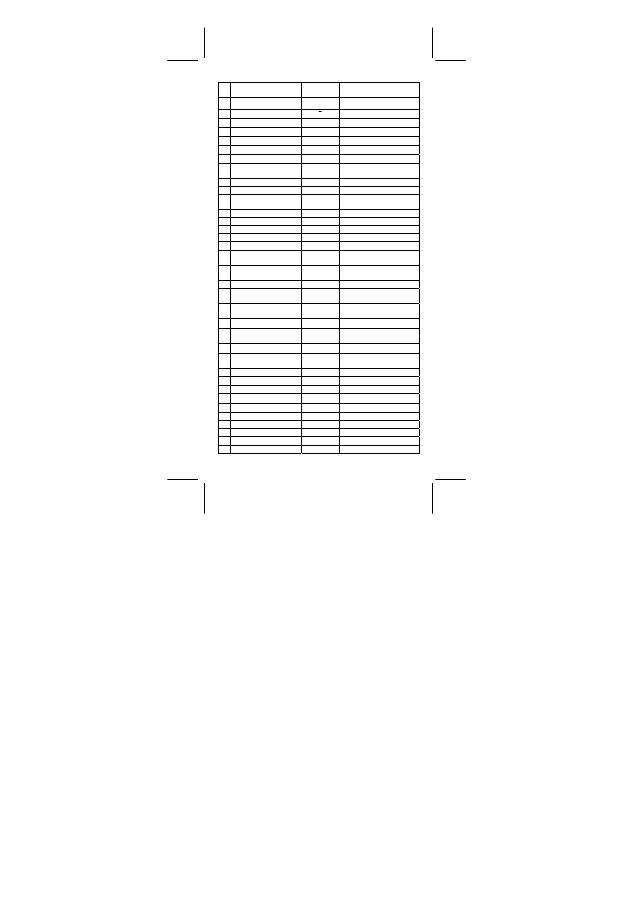
SR260B_SR-281N_Dutch_v090331.doc SIZE: 140x75mm SCALE 1:1
2009/3/31
-D20-
5.
Newton
zwaartekrachtconstante
G 6.67310
x10
–11
m
3
kg
–1
s
–2
6. Planck
constante
h
6.6260687652 x10
–34
J s
7. Planck constante over 2 pi
h
1.05457159682 x10
–34
J s
8. Avogadro
constante
N
A
6.0221419947 x10
23
mol
–1
9. Planck lengte
lp
1.616012 x10
–35
m
10. Planck tijd
tp
5.390640 x10
–44
s
11. Planck massa
mp
2.176716 x10
–8
kg
12. Atomaire massa eenheid
m
μ
1.6605387313 x10
–27
kg
13.
Energie-equivalent van
atomaire massa eenheid
m
μ
c
2
1.4924177812 x10
–10
J
14. Faraday constante
IF
96485.341539 C mol
–1
15. Elementaire lading
e
1.60217646263 x10
–19
C
16.
Elektron volt–joule
verhouding
eV 1.60217646263
x10
–19
J
17. Elementair lading over h
e/h
2.41798949195 x10
14
AJ
–1
18. Molaire gasconstante
R
8.31447215 J mol
–1
K
–1
19. Boltzmann constante
k
1.380650324 x10
–23
J K
–1
20. Molaire planck constante
N
A
h
3.99031268930x10
–10
Js mol
–1
21. Sackur–Tetrode constante
S
0
/R
–
1.164867844
22.
Constante van de
verschuivingswet van Wien
b 2.897768651
x10
–3
m K
23.
Structuurparameter van
silicium
a 543.10208816
x10
–12
m
24.
Stefan–Boltzmann constante
σ
5.67040040 x10
–8
W m
–2
K
–4
25.
Standaardversnelling van
zwaartekracht
g
9.80665 m s
–2
26.
Atomaire massa-eenheid–
kilogram verhouding
μ
1.6605387313 x10
–27
kg
27. Eerste stralingsconstante
c
1
3.7417710729 x10
–16
Wm
2
28.
Eerste stralingsconstante
voor spectrale straling
c
1
L
1.19104272293x10
–16
Wm
2
sr
–1
29. Tweede stralingsconstante
c
2
1.438775225 x10
–2
m K
30.
Molair volume van ideaal
gas
Vm
22.41399639 x10
–3
m
3
mol
–1
31. Rydberg constante
R
∞
10973731.5685 m
–1
32. Rydberg constante in Hz
R
∞
c
3.28984196037 x10
15
Hz
33.
Rydberg constante in joules
R
∞
hc
2.1798719017 x10
–18
J
34. Hartree energie
E
h
4.3597438134 x10
–18
J
35. Quantum van circulatie
h/me
7.27389503253 x10
–4
m
2
s
–1
36. Fijstructuurconstante
α
7.29735253327 x10
–3
37. Loschmidt constante
n
0
2.686777547
x10
25
m
–3
38. Bohr radius
a
0
0.52917720832
x10
–10
m
39. Magnetische flux quantum
Φ
0
2.06783363681 x10
–15
Wb
40. Conductantie quantum
G
0
7.74809169628
x10
–5
S
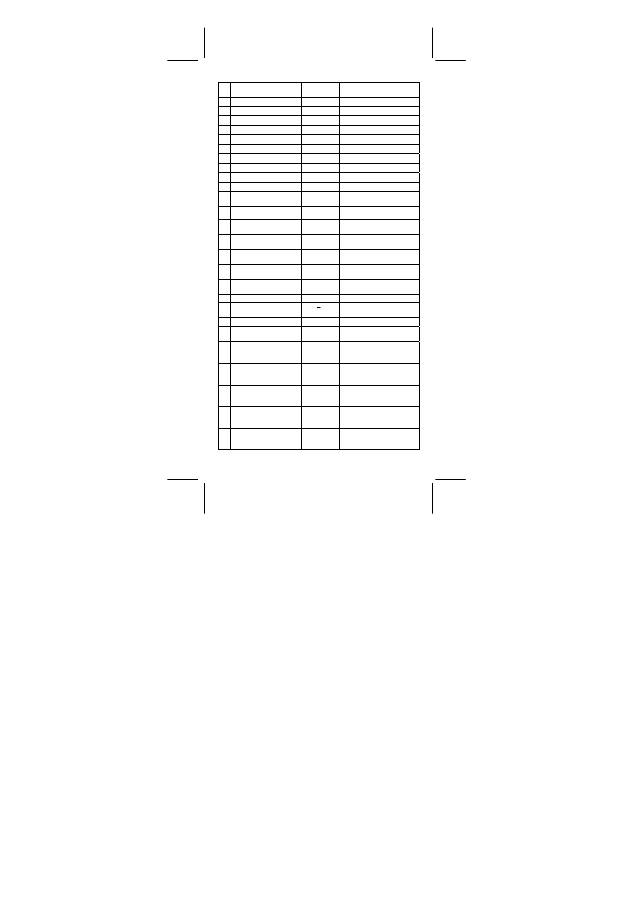
SR260B_SR-281N_Dutch_v090331.doc SIZE: 140x75mm SCALE 1:1
2009/3/31
-D21-
41.
Inverse van conductantie
quantum
G
0
–1
12906.4037865
Ω
42. Josephson constante
KJ
483597.89819 x10
9
Hz V
–1
43. Von Klitzing constante
RK
25812.8075730
Ω
44. Bohr magneton
μ
B
927.40089937 x10
–26
J T
–1
45. Bohr magneton in Hz/T
μ
B/h
13.9962462456 x10
9
Hz T
–1
46. Bohr magneton in K/T
μ
B/k
0.671713112 K T
–1
47. Nucleair magneton
μ
N
5.0507831720 x10
–27
J T
–1
48.
Nucleair magneton in MHz/T
μ
N/h
7.6225939631 MHz T
–1
49. Nucleair magneton in K/T
μ
N/k
3.658263864 x10
–4
K T
–1
50. klassieke elektronradius
re
2.81794028531 x10
–15
m
51. Massa van een elektron
me
9.1093818872 x10
–31
kg
52.
Energie-equivalent van
massa van een elektron
mec
2
8.1871041464 x10
–14
J
53.
Elektron–muon
massaverhouding
me/m
μ
4.8363321015 x10
–3
54.
Elektron–tau
massaverhouding
me/m
τ
2.8755547 x10
–4
55.
Elektron–proton
massaverhouding
me/mp
5.44617023212 x10
–4
56.
Elektron–neutron
massaverhouding
me/mn
5.43867346212 x10
–4
57.
Elektron–deuteron
massaverhouding
me/md
2.72443711706x10
–4
58.
Elektronlading tot
massaquotiënt
–
e/me
–
1.75882017471 x10
11
Ckg
–1
59. Compton golflengte
λ
c
2.42631021518 x10
–12
m
60.
Compton golflengte over 2
pi
λ
c
386.159264228 x10
–15
m
61. Thomson cross section
σ
e
0.66524585415 x10
–28
m
2
62.
Magnetisch moment van
een elektron
μ
e
–
928.47636237x10
–26
J T
–1
63.
Magnetisch moment van
een elektron tot Bohr
magneton verhouding
μ
e/
μ
B
–
1.00115965219
64.
Magnetisch moment van
een elektron tot nucleair
magneton verhouding
μ
e/
μ
N
–
1838.28196604
65.
Elektron–muon
magnetisch
momentverhouding
μ
e/
μ
μ
206.766972063
66.
Elektron–proton
magnetisch
momentverhouding
μ
e/
μ
p
–
658.210687566
67.
Elektron–neutron
magnetisch
momentverhouding
μ
e/
μ
n
960.9205023
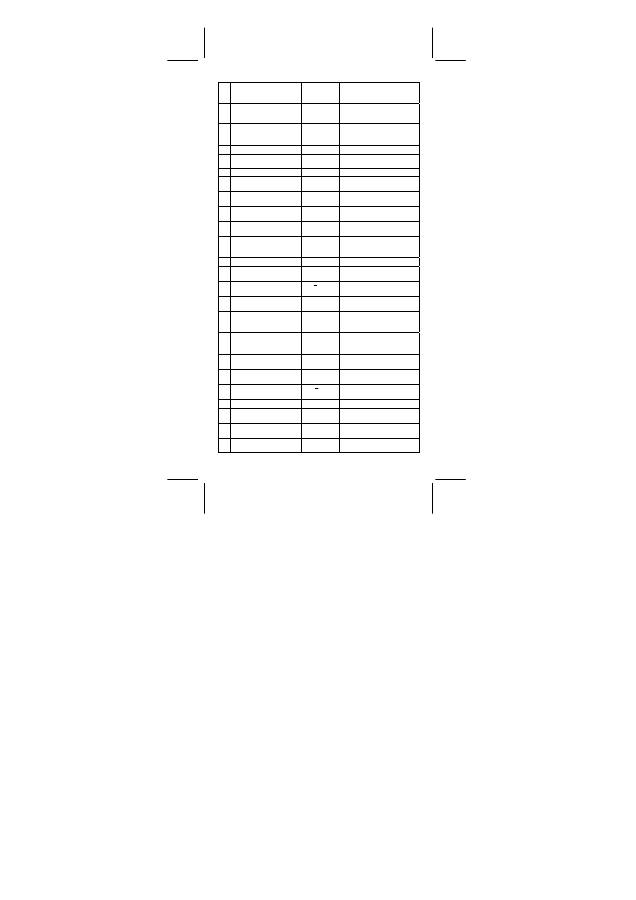
SR260B_SR-281N_Dutch_v090331.doc SIZE: 140x75mm SCALE 1:1
2009/3/31
-D22-
68.
Elektron–deuteron
magnetisch
momentverhouding
μ
e/
μ
d
–
2143.92349823
69.
Elektron tot afgeschermde
helion magnetisch
momentverhouding
μ
e/
μ
'h
864.05825510
70.
Afwijking van het
magnetisch moment van
een elektron
a e
1.15965218694 x10
–3
71. g–factor van een elektron
g e
–
2.00231930437
72.
Giromagnetische verhouding
van een elektron
γ
e
1.76085979471 x10
11
s
–1
T
–1
73. Massa van een muon
m
μ
1.8835310916 x10
–28
kg
74.
Energie-equivalent van
massa van een muon
m
μ
c
2
1.6928333214 x10
–11
J
75.
Muon–tau
massaverhouding
m
μ
/m
τ
5.9457297 x10
–2
76.
Muon–proton
massaverhouding
m
μ
/mp
0.11260951733
77.
Muon–neutron
massaverhouding
m
μ
/mn
0.11245450793
78.
Afwijking van het
magnetisch moment van
een muon
a
μ
1.1659160264 x10
–3
79. G–factor van een muon
g
μ
–
2.00233183201
80.
Compton golflengte van
een muon
λ
c,
μ
11.7344419735 x10
–15
m
81.
Compton golflengte van
een muon over 2 pi
λ
c,
μ
1.86759444455 x10
–15
m
82.
Magnetisch moment van
een muon
μ
μ
–
4.4904481322x10
–26
J T
–1
83.
Magnetisch moment van
een muon tot Bohr
magneton verhouding
μ
μ
/
μ
B
–
4.8419708515 x10
–3
84.
Magnetisch moment van
een muon tot nucleair
magneton verhouding
μ
μ
/
μ
N
–
8.8905977027
85.
Muon–proton magnetisch
momentverhouding
μ
μ
/
μ
p
–
3.1833453910
86.
Compton golflengte van
een tau
λ
c,
τ
0.6977011 x10
–15
m
87.
Compton golflengte van
een tau over 2 pi
λ
c,
τ
0.11104218 x10
–15
m
88. Massa van een tau
m
τ
3.1678852 x10
–27
kg
89.
Energie-equivalent van
massa van een tau
m
τ
c
2
2.8471546 x10
–10
J
90.
Tau–proton
massaverhouding
m
τ
/mp
1.8939631
91.
Compton golflengte van
een proton
λ
c,p
1.32140984710 x10
–15
m
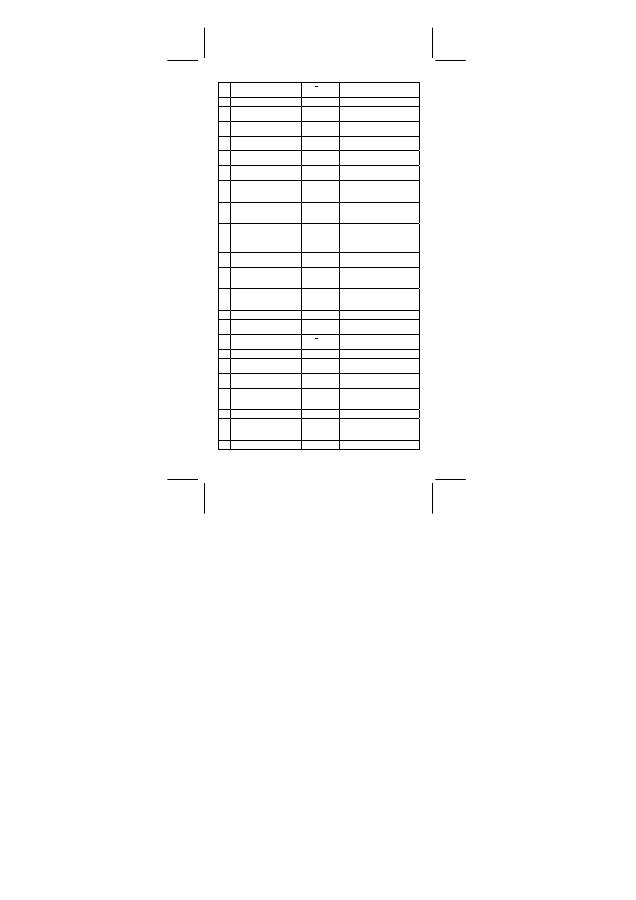
SR260B_SR-281N_Dutch_v090331.doc SIZE: 140x75mm SCALE 1:1
2009/3/31
-D23-
92.
Compton golflengte van
een proton over 2 pi
λ
c,p
0.21030890892 x10
–15
m
93. Massa van een proton
mp
1.6726215813 x10
–27
kg
94.
Energie-equivalent van
massa van een proton
mpc
2
1.5032773112 x10
–10
J
95.
Proton–neutron
massaverhouding
mp/mn
0.99862347856
96.
Protonlading tot
massaquotiënt
e/mp
9.5788340838 x10
7
C kg
–1
97.
Magnetisch moment van
een proton
μ
p
1.41060663358 x10
–26
J T
–1
98.
Magnetisch moment van
een afgeschermd proton
μ
'p
1.41057039959 x10
–26
J T
–1
99.
Magnetisch moment van
een proton tot nucleair
magneton verhouding
μ
p/
μ
N
2.79284733729
100.
Proton–neutron
magnetisch moment
verhouding
μ
p/
μ
n
–
1.4598980534
101.
Magnetisch moment van
een afgeschermde proton
tot Bohr magneton
verhouding
μ
'p/
μ
B
1.52099313216 x10
–3
102.
Giromagnetische
verhouding van een proton
γ
p
2.6752221211 x10
8
s
–1
T
–1
103.
Giromagnetische
verhouding van een
afgeschermde proton
γ
'p
2.6751534111 x10
8
s
–1
T
–1
104.
Magnetische
beschermingscorrectie van
een proton
σ
'p
25.68715 x10
–6
105.g–factor van een proton
g p
5.58569467557
106.
Compton golflengte van
een neutron
λ
c,n
1.31959089810 x10
–15
m
107.
Compton golflengte van
een neutron over 2 pi
λ
c,n
0.21001941422 x10
–15
m
108.Massa van een neutron
mn
1.6749271613 x10
–27
kg
109.
Energie-equivalente van
massa van een neutron
mnc
2
1.5053494612 x10
–10
J
110.
Magnetisch moment van
een neutron
μ
n
–
0.9662364023x10
–26
J T
–1
111.
Magnetisch moment van
een neutron tot Bohr
magneton verhouding
μ
n/
μ
B
–1.0418756325 x10
–3
112.g–factor van een neutron
gn
–
3.8260854590
113.
Giromagnetische
verhouding van een
neutron
γ
n
1.8324718844 x10
8
s
–1
T
–1
114.Massa van een deuteron
md
3.3435830926 x10
–27
kg

SR260B_SR-281N_Dutch_v090331.doc SIZE: 140x75mm SCALE 1:1
2009/3/31
-D24-
115.
Energie-equivalente van
massa van een deuteron
mdc
2
3.0050626224 x10
–10
J
116.
Molaire massa van een
deuteron
M(d)
2.01355321271x10
–3
kg mol
–1
117.
Deuteron–elektron
massaverhouding
md/me
3670.48295508
118.
Deuteron–proton
massaverhouding
md/mp
1.99900750083
119.
Magnetisch moment van
een deuteron
μ
d
0.43307345718 x10
–26
J T
–1
120.
Magnetisch moment van
een deuteron tot Bohr
magneton verhouding
μ
d/
μ
B
0.46697545565 x10
–3
121.
Deuteron magnetisch
moment tot nucleair
magneton verhouding
μ
d/
μ
N
0.85743822849
122.
Deuteron–proton
magnetisch
momentverhouding
μ
d/
μ
p
0.30701220835
123.Massa van een helion
mh
5.0064117439 x10
–27
kg
124.
Energie-equivalente van
massa van een helion
mhc
2
4.4995384835 x10
–10
J
125.
Molaire massa van een
helion
M(h)
3.01493223470x10
–3
kg mol
–1
126.
Helion–electron
massaverhouding
mh/me
5495.88523812
127.
Helion–proton
massaverhouding
mh/mp
2.99315265851
128.
Magnetisch moment van
afgeschermde helion
μ
'h
–
1.07455296745 x10
–26
J T
–1
129.
Magnetisch moment van
afgeschermde helion tot
Bohr magneton verhouding
μ
'h/
μ
B
–
1.15867147414 x10
–3
130.
Magnetisch moment van
afgeschermde helion tot
nucleair magneton
verhouding
μ
'h/
μ
N
–
2.12749771825
131.
Giromagnetische
verhouding van
afgeschermde helion
γ
'h
2.03789476485 x10
8
s
–1
T
–1
132.Massa van een alfadeeltje
m
α
6.6446559852 x10
–27
kg
133.
Energie-equivalente van
massa van een alfadeeltje
m
α
c
2
5.9719189747 x10
–10
J
134.
Molaire massa van een
alfadeeltje
M(
α
)
4.00150617471 x10
–3
kg mol
–1
135.
Alfadeeltje tot elektron
massaverhouding
m
α
/me
7294.29950816
136.
Alfadeeltje tot proton
massaverhouding
m
α
/mp
3.97259968461

SR260B_SR-281N_Dutch_v090331.doc SIZE: 140x75mm SCALE 1:1
2009/3/31
-D25-
Volg de onderstaande stappen om een constante op de plaats van de
cursor in te voegen:
1. Druk op [ CONST ] om het constantenmenu weer te geven.
2. Druk op [ ] of [ 2nd ] [
] totdat de gewenste constante
onderlijnd is.
3. Druk op [ = ].
U kunt ook de [ CONST ] toets in combinatie met een getal van 1 tot
136 gebruiken, om de gewenste constante op te vragen. Druk
bijvoorbeeld op 15 [ CONST ].
DEG
e
1
.
6 0 2 1 7 6 4 6 2 6 3
–19
¾
3 x N
A
= 1.80664259841 x 10
24
CONST DEG
h
h
N
A
l p
t p
3 [ x ] [ CONST ] [ CONST ] [
]
[
]
6
.
0 2 2 1 4 1 9 9 4 7
23
CONST DEG
0 0 8
:
m o l
–1
[ = ]
6
.
0 2 2 1 4 1 9 9 4 7
23
CONST DEG
3
¼
N
A
=
[ = ] [ = ]
1
.
8 0 6 6 4 2 5 9 8 4 1
24
Bewerkingen met getalbasissen (Base–n)
Gebruik de MAIN ( [ MODE ] 1 ( MAIN ) ) modus voor bewerkingen met
getalbasissen (Base–n).
Met de rekenmachine kunt u berekeningen maken met niet-decimale
grondtallen. De rekenmachine kan binaire, octale en hexadecimale
getallen optellen, aftrekken, vermenigvuldigen en delen.
Hieronder ziet u de verschillende getalbasissen met hun
overeenkomstige cijfers.
Binaire getalbasis ( b ): 0, 1
Octale getalbasis ( o ): 0, 1, 2, 3, 4, 5, 6, 7
Decimale getalbasis: 0, 1, 2, 3, 4, 5, 6, 7, 8, 9
Hexadecimale getalbasis (h): 0, 1, 2, 3, 4, 5, 6, 7, 8, 9, A, B, C, D, E, F
Raadpleeg de onderstaande tabel om A, B, C, D, E en F die gebruikt
worden in de hexadecimale getalbasis te onderscheiden van de
standaardletters.
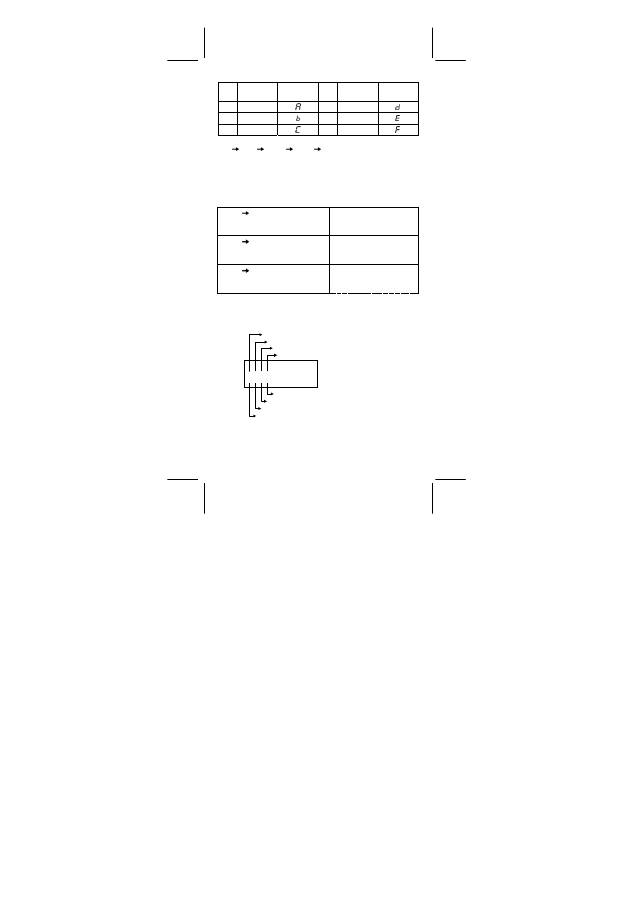
SR260B_SR-281N_Dutch_v090331.doc SIZE: 140x75mm SCALE 1:1
2009/3/31
-D26-
Toets
Beeldscherm
(bovenkant)
Beeldscherm
(onderkant)
Toets
Beeldscherm
(bovenkant)
Beeldscherm
(onderkant)
A /A
D
ID
B IB
E IE
C
I
C
F IF
Selecteer de gewenste getalbasis die u wilt gebruiken aan de hand
van [ BIN ], [ OCT ], [ DEC ], [ HEX ]. De " BIN ", " b ", " OCT ", "
o ", " HEX ", " h " indicators tonen aan welke getalbasis u momenteel
gebruikt. Indien er geen indicator op het beeldscherm verschijnt, dan
wil dit zeggen dat de rekenmachine zich in de decimale getalbasis
bevindt.
Grondtalconversies
¾
37 (grondtal 8) = 31 (grondtal 10) = 1F (grondtal 16)
DEG
OCT
[ 2nd ] [ OCT ] 37
0 0 0 0 0 0 0 0 0 3 7
o
DEG
[ 2nd ] [ DEC ]
3 1
.
DEG
HEX
[ 2nd ] [ HEX ]
0 0 0 0 0 0 1 F
h
Blokfunctie
Een resultaat in de binaire getalbasis wordt weergegeven door de
blokfunctie te gebruiken. Het maximum aantal cijfers (32) wordt
weergegeven in 4 blokken van 8 cijfers.
1 1 0 1 0 0 1 1
b
DEG BIN
Geeft het totaal aantal blokken aan: 1 blok
Toont aan dat Blok 1 momenteel weergeven wordt
Toont aan dat Blok 2 momenteel weergeven wordt
Toont aan dat Blok 3 momenteel weergeven wordt
Toont aan dat Blok 4 momenteel weergeven wordt
Geeft het totaal aantal blokken aan: 2 blokken
Geeft het totaal aantal blokken aan: 3 blokken
Geeft het totaal aantal blokken aan: 4 blokken
De blokfunctie bestaat uit bovenste en onderste blokindicatoren. De
bovenste blokindicator duidt de huidige blokpositie aan en de onderste
blokindicator duidt het totaal aantal blokken van het resultaat aan.
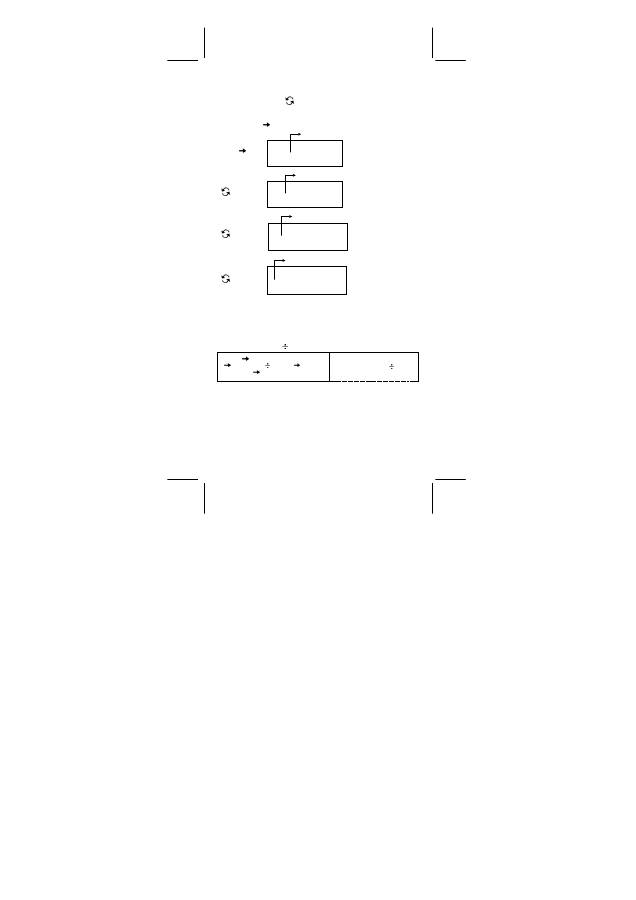
SR260B_SR-281N_Dutch_v090331.doc SIZE: 140x75mm SCALE 1:1
2009/3/31
-D27-
In de binaire getalbasis wordt onmiddellijk na de berekening, blok 1
weergegeven. De andere blokken ( blok 2 ~ blok 4 ) worden
weergegeven door op [
] te drukken.
Voer bijvoorbeeld 47577557
16
in.
Druk op [ 2nd ] [ HEX ] 47577557
[ 2nd ] [ BIN ]
0 1 0 1 0 1 1 1
b
DEG BIN
– –
Toont aan dat Blok 1 momenteel weergeven wordt
[
]
0 1 1 1 0 1 0 1
b
DEG BIN
–
–
Toont aan dat Blok 2 momenteel weergeven wordt
[
]
0 1 0 1 0 1 1 1
b
DEG BIN
– –
Toont aan dat Blok 3 momenteel weergeven wordt
[
]
0 1 0 0 0 1 1 1
b
DEG BIN
– – –
Toont aan dat Blok 4 momenteel weergeven wordt
47577557
16
= Blok 4 + Blok 3 + Blok 2 + Blok 1
= 01000111010101110111010101010111
2
Rekenkundige basisbewerkingen in andere
getalbasissen
¾
1IEIF
16
+ 1234
10
1001
2
= 1170
8
DEG
OCT
h 1 IE IF + 1 2 3 4
b 1
[ 2nd ] [ HEX ] 1E F [ + ] [ 2nd ]
[ DEC ] 1234 [ ] [ 2nd ] [ BIN ] 1001
[ = ] [ 2nd ] [ OCT ]
0 0 0 0 0 0 0 1 1 7 0
o
Negatieve uitdrukkingen
In de binaire, octale, en hexadecimale getalbasissen, stelt de
rekenmachine negatieve nummers voor aan de hand van de
complementnotatie. Het complement is het resultaat dat bekomen
wordt in deze getalbasis door het getal van
100000000000000000000000000000000 af te trekken, door op de
[ NEG ] toets in een niet-decimale getalbasis te drukken.

SR260B_SR-281N_Dutch_v090331.doc SIZE: 140x75mm SCALE 1:1
2009/3/31
-D28-
¾
3/A
16
= NEG IFIFIFIFIFIFIC6
16
DEG
HEX
N E G
h 3 /A
[ 2nd ] [ HEX ] 3 A [ NEG ]
F F F F F F C 6
h
Logische functies
Logische functies worden uitgevoerd aan de hand van logische
operators (AND), negatieve logische operators (NAND), logische
sommen (OR), exclusieve logische sommen (XOR), negaties (NOT),
en negaties van exclusieve logische sommen (XNOR).
¾
1010
2
AND ( /A
16
OR 7
16
) = 12
8
DEG
OCT
b 1 0 1 0
A N D
( h
[ 2nd ] [ BIN ] 1010 [ AND ] [ ( ] [ 2nd ]
[ HEX ] A [ OR ] 7 [ ) ] [ = ] [ 2nd ]
[ OCT ]
0 0 0 0 0 0 0 0 0 1 2
o
Statistische
bewerkingen
Gebruik de STAT ( [ MODE ] 2 ( STAT ) ) modus voor statistische
bewerkingen.
In deze modus, kan de rekenmachine zowel statistische bewerkingen
met één enkele variabele als statistische bewerkingen met gepaarde
variabelen, uitvoeren.
Druk op [ MODE ] 2 ( STAT ) om de rekenmachine in de STAT modus
te zetten. Selecteer één van de zes items in de STAT modus.
DEG
1–VAR LIN LOG
STAT
[
] [
] [
]
DEG
EXP PWR D–CL
STAT
Statistieken met één enkel variabele
1–VAR
Statistieken met één enkele variabele
Statistieken met gepaarde variabelen / regressie statistieken
LIN
Lineaire regressie
y = a + b x
LOG
Logaritmische regressie y = a + b lnx
EXP
Exponentiele regressie
y = a • e
bx
POW
Machtsregressie
y = a • x
b
D–CL
Alle statistische gegevens wissen
Gegevens invoeren
Zorg ervoor dat u steeds alle statistische wist door op D–CL te
drukken, alvorens statistische bewerkingen uit te voeren.
(A) Gebruik de volgende syntaxis voor het invoeren van één enkele
variabele:
# Één enkel gegeven: [ DATA ] < x-waarde >

SR260B_SR-281N_Dutch_v090331.doc SIZE: 140x75mm SCALE 1:1
2009/3/31
-D29-
# Meerdere gegevens met dezelfde waarde:
[ DATA ] < x-waarde> [ x ] < Aantal herhalingen>
(B) Gebruik de volgende syntaxis voor het invoeren van gepaarde
variabelen / regressiegegevens:
# Één enkel gegevensset: [ DATA ] <x-waarde> [ ] < y-waarde >
# Meerdere gegevenssets met dezelfde waarde:
[ DATA ] < x-waarde > [ ] <y-waarde> [ x ] <Aantal herhalingen>
(Opmerking) : Zelfs wanneer u de STAT modus afsluit, zullen alle
gegevens bewaard blijven tenzij u alle gegevens wist
door de D–CL modus te selecteren.
Resultaten weergeven
De waarden van de statistische variabelen zijn afhankelijk van de
ingevoerde gegevens. U kunt ze opvragen door op de toetsen te
drukken die in de onderstaande tabel getoond worden.
Statistische bewerkingen met één enkel variabele
Variabelen Betekenis
n ( [ n ] )
Het aantal ingevoerde x-waarden
x
( [2nd]+[
x
] )
Gemiddelde van de x-waarden
Sx
( [2nd]+[
Sx
] )
Standaardafwijking van de steekproef van
de x-waarden
σ
x
( [2nd]+[
σ
x
] )
Standaardafwijking van de populatie van de
x-waarden
∑
x
( [2nd]+[
∑
x
] )
De som van alle x-waarden
∑
x
2
( [2nd]+[
∑
x
2
]) De som van alle x
2
-waarden
CP
( [2nd]+[
CP
] )
Potentiële begrenzingprecisie van de x-
waarden
CPK ( [CPK] )
Minimum (CPU, CPL) van de x-waarden,
waarbij CPU de bovenste grenswaarde van
de begrenzingprecisie is en CPL de
onderste grenswaarde van de
begrenzingprecisie
CPK = Min ( CPU , CPL ) = CP ( 1 – Ca )
Statistische bewerkingen met gepaarde variabelen /
Regressieberekeningen
Variabelen Betekenis
n ( [ n ] )
Het aantal ingevoerde x-y paren
x
( [2nd]+[
x
] )
y
( [2nd]+[
y
] )
Gemiddelde van de x-waarden of y-waarden

SR260B_SR-281N_Dutch_v090331.doc SIZE: 140x75mm SCALE 1:1
2009/3/31
-D30-
Sx
( [2nd]+[ Sx ] )
Sy
( [2nd]+[ Sy ] )
Standaardafwijking van de steekproef van
de x-waarden of y-waarden
σ
x
( [2nd]+[
σ
x
] )
σ
y
( [2nd]+[
σ
y
] )
Standaardafwijking van de populatie van de
x-waarden of y-waarden
∑
x
( [2nd]+[
∑
x
] )
∑
y
( [2nd]+[
∑
y
] )
De som van alle x-waarden of y-waarden
∑
x
2
( [2nd]+[
∑
x
2
])
∑
y
2
( [2nd]+[
∑
y
2
])
De som van alle x
2
-waarden of y
2
-waarden
∑
x y
De som van ( x • y ) voor alle x-y paren
CP
( [2nd]+[
CP
] )
Potentiële begrenzingprecisie van de x-
waarden
CPK ( [ CPK ] )
Minimum (CPU, CPL) van de x-waarden,
waarbij CPU de bovenste grenswaarde van
de begrenzingprecisie is en CPL de
onderste grenswaarde van de
begrenzingprecisie
CPK = Min ( CPU , CPL ) = CP ( 1 – Ca )
a ( [2nd]+[
a ] )
Constante term a van de regressieformule
b ( [2nd]+[
b ] )
Regressiecoëfficiënt b van de
regressieformule
r ( [2nd]+[
r ] )
Correlatiecoëfficiënt r
x
’
([ x
’
] )
De geschatte waarde van x
y
’
([ y
’
] )
De geschatte waarde van y
U kunt steeds nieuwe gegevens invoeren. Elke keer dat u op [ DATA ]
drukt en nieuwe gegevens invoert, zal de rekenmachine automatisch
de statistieken opnieuw berekenen.
¾
Voer de gegevens in: USL
= 95, LSL = 70, DATA 1 = 75, DATA 2 =
85, DATA 3 = 90, DATA 4 = 82, DATA 5 = 77, en vind de
resultaten: n = 5, = 81.8, Sx = 6.05805249234,
σ
x =
5.41848687366, CP = 0.76897236513, en CPK = 0.72590991268
DEG
STAT
1–
V A R
L I N
L O G
[ MODE ] 2
DEG
STAT
D A T A
5
[ = ] [ DATA ] 75 [ DATA ] 85 [ DATA ] 90
[ DATA ] 82 [ DATA ] 77
7 7
DEG
STAT
n
[ n ]
5
.
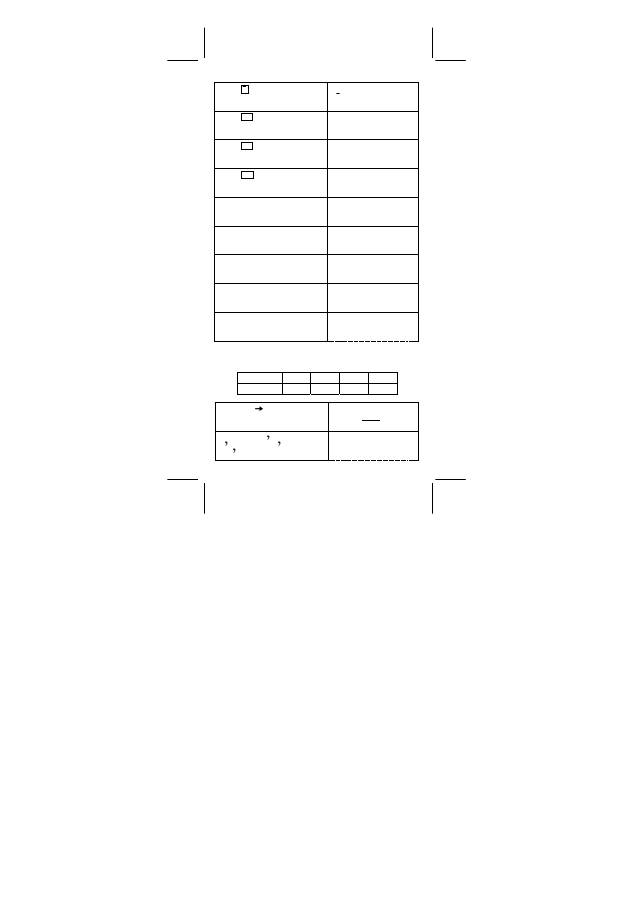
SR260B_SR-281N_Dutch_v090331.doc SIZE: 140x75mm SCALE 1:1
2009/3/31
-D31-
DEG
STAT
x
[ 2nd ] [ x
]
8 1
.
8
DEG
STAT
S x
[ 2nd ] [ Sx ]
6
.
0 5 8 0 5 2 4 9 2 3 4
DEG
STAT
σ
x
[ 2nd ] [
σ
x ]
5
.
4 1 8 4 8 6 8 7 3 6 6
DEG
STAT
U S L =
[ 2nd ] [ CP
] 95
9 5
CP
USL
DEG
STAT
L S L =
[ = ] 70
7 0
CP
LSL
DEG
STAT
C P
[ = ]
0
.
7 6 8 9 7 2 3 6 5 1 3
DEG
STAT
U S L =
[ CPK ]
9 5
.
CPK
USL
DEG
STAT
L S L =
[ = ]
7 0
.
CPK
LSL
DEG
STAT
C P K
[ = ]
0
.
7 2 5 9 0 9 9 1 2 6 8
¾
Zoek a, b en r voor de volgende gegevens door de lineaire
regressiemethode te gebruiken en voorspel: x = ? voor y =573 en
y = ? voor x = 19.
Gegevensitem
15 17 21 28
FREQ. 451 475 525 678
DEG
STAT
1–
V A R
L I N
L O G
[ MODE ] 2 [
]
DEG
STAT
D A T A
4 = 2 8
,
[ = ] [ DATA ] 15 [ ] 451 [ DATA ] 17
[ ] 475 [ DATA ] 21 [ ] 525 [ DATA ]
28 [ ] 678
6 7 8
REG
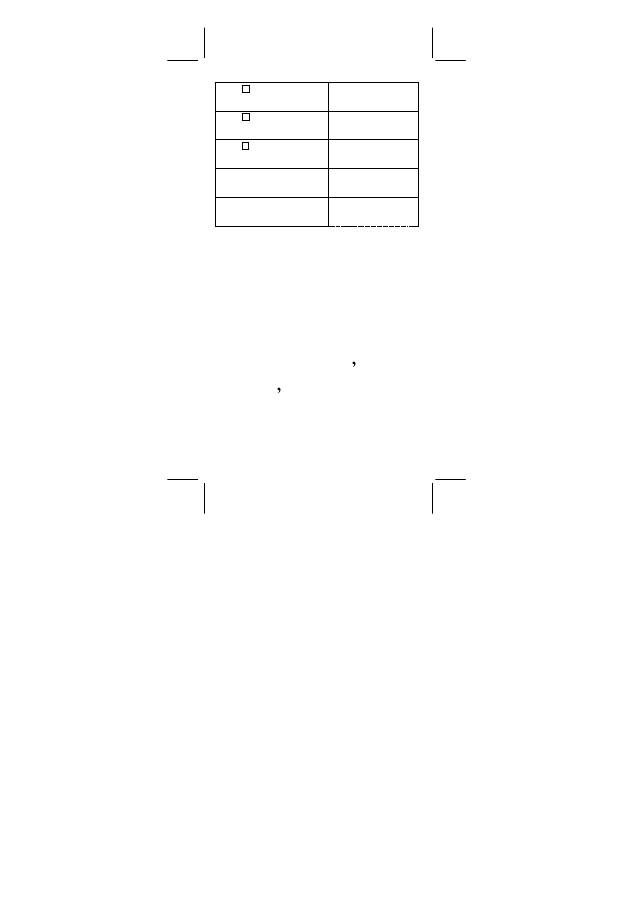
SR260B_SR-281N_Dutch_v090331.doc SIZE: 140x75mm SCALE 1:1
2009/3/31
-D32-
DEG
STAT
a
[ 2nd ] [ a ]
1 7 6
.
1 0 6 3 2 9 1 1 4
REG
DEG
STAT
b
[ 2nd ] [ b ]
1 7
.
5 8 7 3 4 1 7 7 2 2
REG
DEG
STAT
r
[ 2nd ] [ r ]
0
.
9 8 9 8 4 5 1 6 4 1 3
REG
DEG
STAT
x
’
5 7 3
573 [ x
’
]
2 2
.
5 6 7 0 0 7 3 4 1 3
REG
DEG
STAT
y
’
1 9
19 [ y
’
]
5 1 0
.
2 6 5 8 2 2 7 8 5
REG
Gegevens verwijderen
De methode om de gegevens te verwijderen, hangt af of u al dan niet
de gegevens hebt opgeslagen door op de [ DATA ] toets te drukken.
Om gegevens te verwijderen, die u zojuist ingevoerd hebt maar nog
niet opgeslagen hebt door op [ DATA ] te drukken, drukt u gewoonweg
op [ CE ].
Om gegevens te verwijderen die u reeds opgeslagen hebt door op
[ DATA ] te drukken:
(A) Gebruik de volgende syntaxis voor het verwijderen van één enkele
variabele:
# < x-waarde> [ 2nd ] [ DEL ]
# < x-waarde> [ x ] < Aantal herhalingen > [ 2nd ] [ DEL ]
(B) Gebruik de volgende syntaxis voor het verwijderen van gepaarde
variabelen / regressiegegevens:
# Één enkele gegevensset: < x-waarde > [ ] < y-waarde > [ 2nd ]
[ DEL ]
# Meerdere gegevenssets met dezelfde waarde:
< x-waarde> [ ] < y-waarde > [ x ] < Aantal herhalingen >
[ 2nd ] [ DEL ]
Indien u per ongeluk een waarde invoert en verwijdert dat zich niet in
de opgeslagen gegevens bevindt, zal " dEL Error " op het scherm
verschijnen. In dit geval zullen de vorige gegevens behouden worden.
Gegevens bewerken
Druk op [ 2nd ] [ EDIT ] om de rekenmachine in de EDIT modus te
zetten. De EDIT modus is handig voor het bekijken, corrigeren en
verwijderen van gegevens.
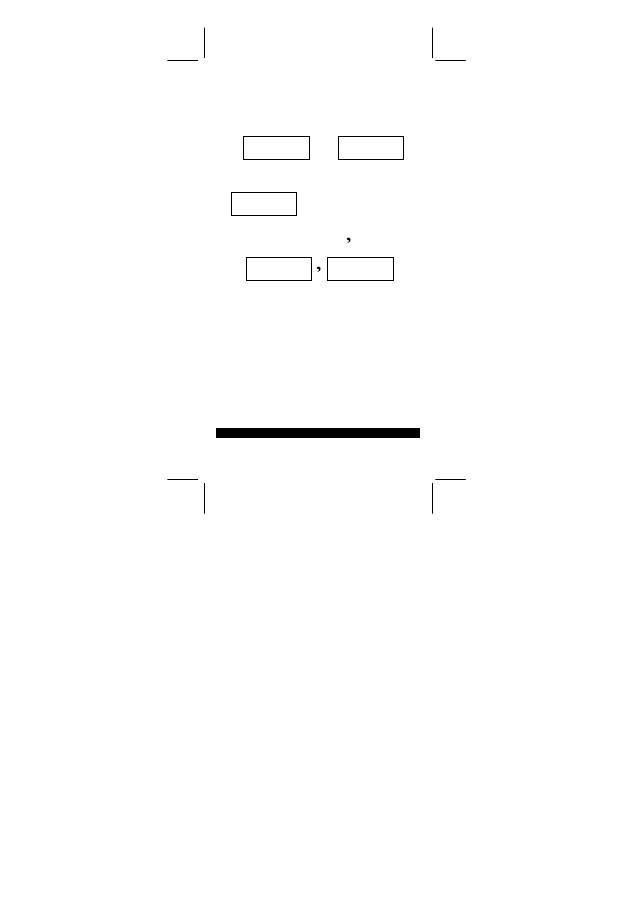
SR260B_SR-281N_Dutch_v090331.doc SIZE: 140x75mm SCALE 1:1
2009/3/31
-D33-
(A) In de 1–VAR modus, hangt de methode om de gegevens te
bekijken af van het feit of u al dan niet de gegevenitems wilt
weergeven.
# Elke keer u op [ DATA ] drukt, zal eerst het gegevenitem
gedurende 1 seconde weergegeven worden en vervolgens de
overeenkomstige waarde.
[ DATA ]
DEG
dAtA 1
STAT
EDIT
1 second
DEG
15.
STAT
EDIT
# Elke keer u op [ = ] drukt, zal de waarde rechtstreeks op het
beeldscherm weergegeven worden, zonder het gegevenitem
weer te geven.
[ = ]
DEG
15.
STAT
EDIT
(B) Elke keer u in de REG modus op [ DATA ] drukt, zullen het
gegevenitem en de x-waarde tegelijkertijd op het beeldscherm
weergegeven worden. U kunt op de [ ] drukken om over te
schakelen tussen de x en y-waarde.
[ DATA ]
DEG
DATA 1 = 15 , 45
STAT
15
EDIT
[ ]
DEG
DATA 1 = 15 , 45
STAT
451
EDIT
Indien u gegevens wilt corrigeren, moet u de te corrigeren gegevens
zoeken en een nieuwe waarde invoeren om ze te vervangen.
Het bericht "FULL"
Het bericht “ FULL” zal op het beeldscherm verschijnen en verdere
berekeningen zullen onmogelijk worden wanneer er zich één van de
onderstaande situaties voordoet. Druk op een toets om het bericht te
laten verdwijnen. De voordien ingevoerde gegevens worden
behouden tenzij u de STAT modus afsluit.
1) Het aantal ingevoerde gegevens aan de hand van [ DATA ] is
meer dan 50.
2) Het aantal herhalingen is meer dan 255.
3) n
>
12750 (n = 12750 verschijnt wanneer het aantal ingevoerde
gegevens aan de hand van [ DATA ] meer dan 50 is en wanneer
het aantal herhalingen voor iedere waarde 255 is, d.w.z. 12750 =
50 x 255 )
Complexe
bewerkingen
Gebruik de CPLX ( [ MODE ] 3 ( CPLX ) ) modus voor het uitvoeren
van complexe bewerkingen.
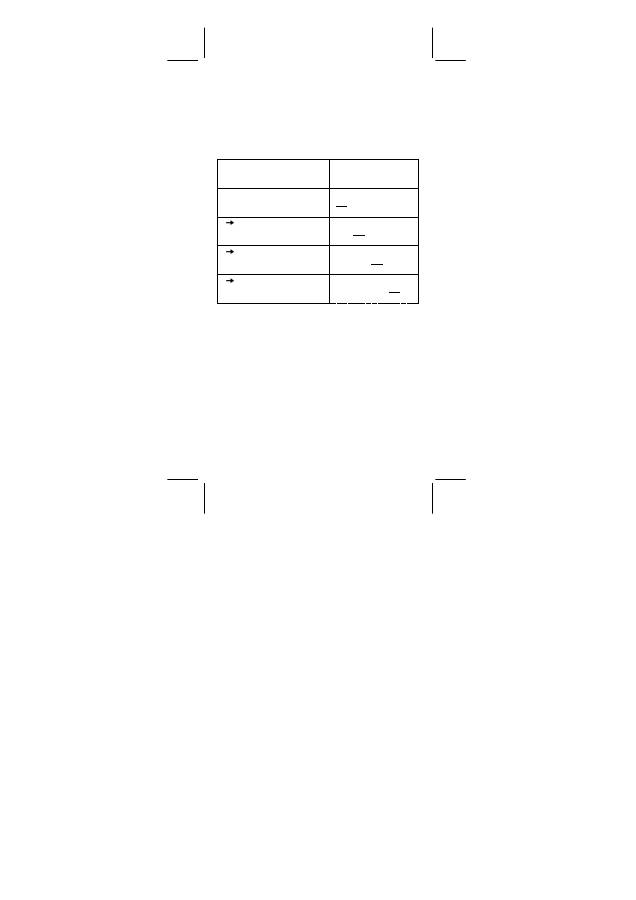
SR260B_SR-281N_Dutch_v090331.doc SIZE: 140x75mm SCALE 1:1
2009/3/31
-D34-
In de complexe getalmodus kunt u complexe getallen optellen,
aftrekken, vermenigvuldigen en delen.
De resultaten van een complexe bewerking worden als volgt
weergegeven:
Re
Reële waarde
Im
Imaginaire waarde
ab Absolute
waarde
ar Argumentwaarde
¾
( 7 – 9 i ) + ( 15 + 12 i ) = 22 + 3 i , ab = 22.2036033112,
ar = 7.76516601843
CPLX
DEG
[ MODE ] 3
0
.
CPLX
DEG
R e
I m
a b
a r
7 [ – ] 9 [ i ] [ + ] 15 [ + ] 12 [ i ] [ = ]
2 2
.
CPLX
DEG
R e
I m
a b
a r
[
]
3
.
i
CPLX
DEG
R e
I m
a b
a r
[
]
2 2
.
2 0 3 6 0 3 3 1 1 2
CPLX
DEG
R e
I m
a b
a r
[
]
7
.
7 6 5 1 6 6 0 1 8 4 3

